Topic outline
UNIT1: PEOPLE AND PLACES
Key Unit Competence: To use language learnt in the context of people and places

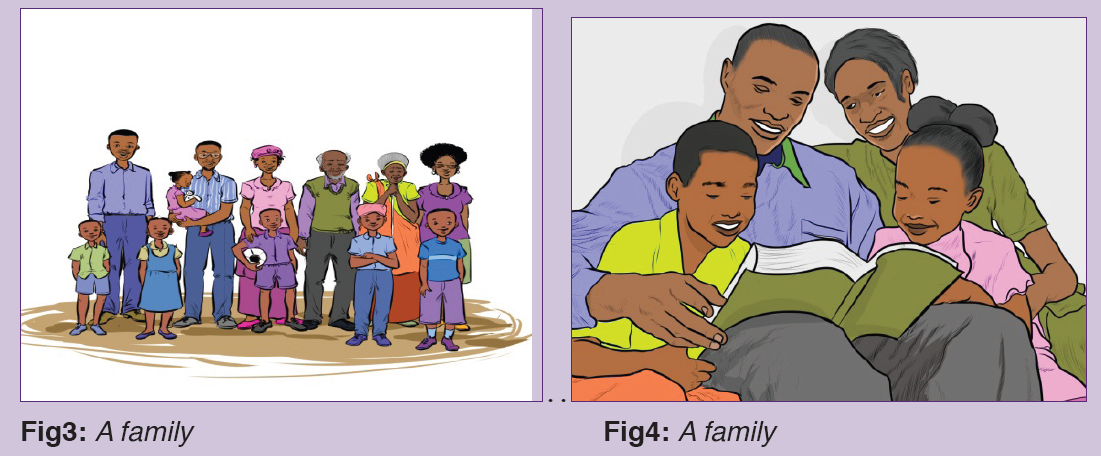
After observing the above pictures, answer the following questions.
1. Why do you think people visit national parks?
2. Describe people in your home using present simple tense.
3. Do you think people in fig 3 make a nuclear or an extended family? Explain.
4. Compare and contrast a nuclear and an extended family using conjunctions like while and whereas.
5. If you were a parent, would you spend money to take your children to explore new places? Justify your answer.
1.1. Introducing oneself and others

• Text 1. A dialogue between two classmates
Read the dialogue below and answer the questions that follow:
Keza: Hello! My name is Keza Irene. Nice to see you.
Mutoni: Hello! I am Mutoni Sara. Nice to meet you too.
Keza: When did you report for the new term and how often do you study from the library?
Mutoni: Oh well, I got to school last week and always have my preps in the library.
It’s convenient for concentration- less movement and maximum silence is maintained.
Keza: That’s great to hear. By the way, do you have any friends here?
Mutoni: Yes, I do, and I usually come with them here for preps. My best friends in this College are Mahoro Janet and Ngabire Sarah. The three of us are fascinated with quiet environments.
Keza: Obviously, but where do Janet and Sarah live?
Mutoni: Janet lives in the far end of lake Mirayi in Bugesera District.
It is a semi- arid area while Sarah is in the quiet neighbourhood of Kacyiru District.I seldom visit them.
Keza: Have you ever been to Akagera national park?
Mutoni: Yes, I have, and I must say, it is one of the richest ecological sites in Rwanda with natural vegetation, beautiful lakes and variety of animal species. It has an amazing scenery.
Keza: Oh wow! Am inspired to visit that place. Where is it located?
Mutoni: It is found in the Eastern province of Rwanda near the border with Tanzania. It would be amazing if you visited.
Keza: Thank you Mutoni, it was great meeting you and talking to you. I’m more motivated to visit new places like the Akagera National park. I’m glad I met you and hope to see you again.
• Comprehension questions
1. Are the two speakers meeting for the first time or not, explain your answer.
2. Describe Akagera national park in 4 sentences.
3. Explain why the three friends love reading from the library.
4. From the dialogue, discuss the parts of speech reflected and provide examples.
5. Discuss some of aspects that the three friends have in common in the dialogue. Give two.
6. Identify two differences between the places from which the two friends have come.
7. From the dialogue, find the contextual meaning of the following words:
a) Fascinated
b) Seldom
c) Obviously
• Text 2: Animals in the farm
Read the passage below and answer the questions that follow:
The animals never lost, not even for an instant, their sense of honour and privilege as members of Animal Farm. It remained the only farm in the whole of England, owned and operated by animals! And when they heard the gun booming and saw the green flag fluttering at the masthead, their hearts swelled with imperishable pride, and the talk turned always to the old heroic
days, the expulsion of Jones, the writing of the seven commandments, the great battles in which the human invaders had been defeated . None of their old dreams had been abandoned.
The republic of animals which Major had foretold, when the green fields of England should be destroyed by animal feet, was still believed in. It might be that their lives were hard and that not all of their hopes had been fulfilled; but they were conscious that they were not like other animals. If they went hungry it was not from feeding tyrannical human beings; if they worked hard at least it was for themselves. No creature upon them went upon two legs. No creature called any other creature Master. All animals were equal. One pleasant day, when the animals had finished work and were making their way back to the farm buildings, the terrified neighing of a horse sounded from the yard. Startled, the animals stopped in their tracks. It was Clover’s voice. She neighed again, and all the animals broke into a gallop and rushed into the yard. Then they saw what Clover had seen. It was a pig walking on its hind legs.
Yes, it was a squealer. A little awkwardly, as though not used to supporting his considerable bulk in that position, but with perfect balance, he was strolling across the yard. And a moment later, out from the door of the farmhouse came along a herd of pigs all walking on their hind legs. Some did it better than the others, one or two were even a little bit unsteady and looked as though they would have liked the support of a stick, but every one of them made his way right round the yard successfully. And finally, there was tremendous barking of dogs and a shrill crowing from the black cockerel... and out came Napoleon himself majestically upright, casting haughty glances side to side, and with his dogs gambling round him.
He carried a whip on his trotter.
There was deadly silence. Amazed, terrified, huddling together, the animals watched the long line of pigs march slowly round the yard. It was tough, the world had turned upside down. Then there came a moment when the first shock had worn off and when, despite everything, in spite of their terror of the dogs, and of the habit, developed through long years, of never complaining, never criticizing, no matter what happened. They might have uttered some words of protest. But just at that moment, as though at a signal, all the sheep burst out into a tremendous bleating of:
‘Four legs good, two legs better! Four legs good, two legs better! Four legs good, two legs better!’
It went on for five minutes without stopping. And by the time the sheep had quieted down, the chance of utter of any word of protest had passed, for the pigs had marched back into the farmhouse.
Benjamin felt a nose nuzzling at his shoulder. He looked round. It was Clover. Her old eyes looked dimmer than ever. Without saying anything,she tugged gently at his mane and led him round the end of the big barn were the seven commandments were written. For a minute or two they stood gazing at the tarred wall with its white lettering.
‘My old sight was failing, she said finally, even when I was young, I could not have read what was written there. But it appears to me now that, that wall looks different. Are the seven commandments the same as they used to be, Benjamin?’
Benjamin read out to her what was written on the wall. There was nothing there now except one single commandment. It read:
“All animals are equal but some animals are more equal than others”
Extract from “Animal Farm” by George Orwell
• Comprehension questions
1. What do you understand by the phrase,” … all animals are equal, but some animals are more equal than others.”
2. Why are animals proud of the animal farm?
3. How can you tell from the passage that Napoleon was the leader?
• Vocabulary
Construct your own sentences using the words below:
a. Bulk
b. Privilege
c. Imperishable
d. Tyrannical
e. Untrodden
f. Tugged
g. White lettering
h. Uttered

Write a two-page essay explaining the unique qualities that make people different.
1.2. Talking about people at home

• Text 1
Look at the pictures and read the passage below, then answer questions that follow.
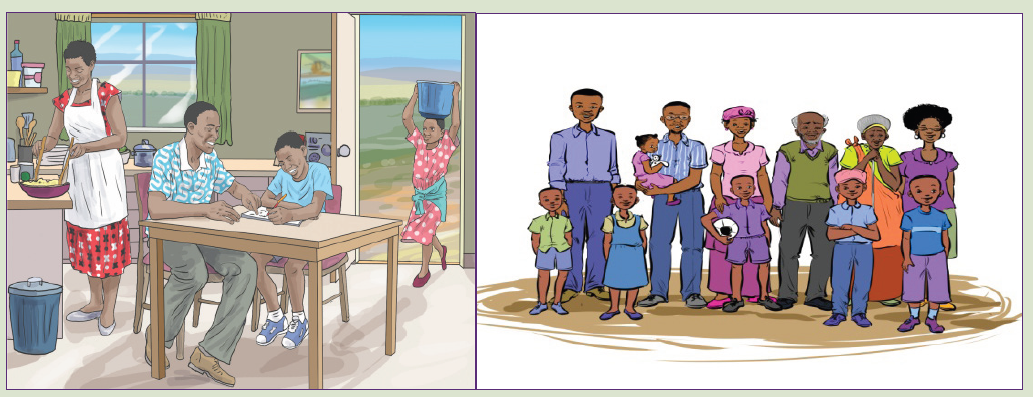
Home environment
A home is generally defined as a place where one lives permanently, especially as a member of family or household. Normally when we talk about a home, people understand a family. The family is a social group characterized by common residence, economic cooperation and reproduction. It contains adults of both sexes, at least two of whom maintain a socially approved
sexual relationship, and one or more children, own or adopted. There are two types of family that is; nuclear and extended family. The term nuclear family refers to the family group consisting of parents and children, while extended family includes all those with kinship ties. Throughout history, families have been central to human society, the basic social unit for the expression of love between man and woman and the creation and raising of children.
Although the twentieth century saw the decline in strength and numbers of the nuclear family, it has also been noted that there was never an age in history when the ideal family existed. As we move forward into an age in which barriers are broken down and we come to live together as one human family, the essential nature of individual families is key to harmonious human societies. A three generation family includes grandparents in addition to parents and children, and provides the greatest support for the raising of children and continuation of the lineage.
The term nuclear family was developed in the western world to distinguish the family group consisting of parents and their children, from what is known as extended family. So, nuclear family is made up of parents and siblings whereas extended family is composed of some people from the same ancestors. According to Merriam-Webster, the term dates back to 1947 and
is therefore relatively new, although nuclear family structures themselves are not.
As far back as our knowledge takes us, human beings have lived in families.
We know of no period where this was not so. We know of no people who have succeeded for long in dissolving the family or displacing it ... Again and again, in spite of proposals for change and actual experiments, human societies have reaffirmed their dependence on the family as the basic unit of humans living in a family of father, mother and children.
Adapted from https://www.newworldencyclopedia.org/entry/Nuclear_family
• Comprehension questions
1. In your own words define the term “family”.
2. Do you think uncles and aunts belong to nuclear or extended family?
Justify your answer.
3. Between nuclear and extended family which one do you prefer and why?
4. What do you think the writer meant by “there was never an age in history when the ideal family existed”?
5. At your place, which role does the extended family play in raising children?

1. Write a short paragraph explaining how a good family would look like. (Refer to notes on paragraph writing in unit 5, page….)
2. Discuss the following statements:
a. “ The family is a social group characterized by common residence, economic cooperation and reproduction”.
b. “It contains adults of both sexes, at least two of whom maintain a socially approved sexual relationship...”
1.3. Narrating about different places
Read the following text and answer questions that follow:
• Text: Shannon Sims’ experience in Akagera National Park
The road through Akagera National Park in eastern Rwanda was blocked.
Two giraffes had positioned themselves smack in the middle of the dirt road and were rubbing their necks together.
In the car, with a driver and a guide, my cell service was long gone; there was nothing to do but sit back, relax and enjoy the show.
Right around this time of year, to the east of Rwanda’s borders, in Tanzania and Kenya, big packs of tourists are stumbling over each other to get the perfect photo of a scene like this.
They’re driving through protected areas like Serengeti National Park and the Maasai Mara National Reserve in caravans of Land Rovers, each packed so tightly that peoples’ binocular straps get tangled up.
It makes sense: the animal migrations that occur in this part of the world these months are rightly considered by many to be the greatest natural show on earth.
But in Akagera, an eight- hour day in the park concluded without the sighting of another tourist. I did, though, see those necking giraffes, as well as plenty of snorting rhinos, which brilliantly hued birds and lumbered elephants.
Ms. Hall’s mission is to bring Akagera back to life. An electric fence put up around the park to keep poachers away is monitored by a canine unit and 80 rangers. Rangers also work on building back trust with the local community.
For lodging, the park contains one flavorless hotel, Akagera Game Lodge, with a baboon problem. I spilled my coffee in fright when a surprise guest jumped onto my balcony ... A better choice could have been Rusizi Tented
Lodge, run by African Parks.
The showcase is a crescent-shaped patio built out over the edge of Lake Ihema, which happens to be a popular hang spot for a pack of hippopotamus.
While guests nibble on pastries and fruit in the morning, the hippos heave into each other in the water, occasionally smashing their tusks together to create a startling clacking sound in early morning tussles.
Headed north from Ruzizi, an Akagera game drive is also a five to seven- hour highlight reel of gorgeous east African landscapes: open plains, scraggly highlands and the swampy waters of Africa’s largest protected wetlands.
At the north end of the park, the Karenge Bush Camp brings lucky visitors into even closer, more rustic proximity with Akagera’s natural surroundings.
Adapted from https://taarifa.rw/2018/09/23/akagera-game-park-is-asuccess-story-in-the-making/
• Comprehension questions
1. Do you think that Sims was bored when their car was blocked by two giraffes? Explain.
2. Describe what happens around this time of year, to the east of Rwanda’s borders.
3. Do you think Akagera National Park received many tourists at this time? Justify your answer.
4. Discuss the measure that has been put in place to protect the park from poachers?
5. What do you understand by “tourists are stumbling over each other to get the perfect photo of a scene like this”?
Vocabulary activity: Using dictionary and thesaurus
Find the meaning of the following words as they are used in the above passage. (the words are highlighted in the text)
1. Smack
2. Stumbling
3. Caravans
4. Snorting
5. Brilliantly
6. Poachers
7. Spilled
8. Balcony
9. Rustic
10. Startling
11. Reel
12. Hang spot
13. Wetland
14. Scraggly

Use each of the above words in your own sentence.
1.4. Comparing people according to their gender and occupations

• Text1: Gender differences in occupation of employment
Read the passage below and answer the questions that follow:
Differences in employment distributions between women and men have been, and continue to be, a prominent feature of the labour market. Researches indicated a high degree of difference that remained fairly constant from the
early 1900s until about 1970.
The 1970s were a watershed period in occupational desegregation, as indicated by significant declines in measures of occupational differences.
The advances of the women’s movement, the enactment of laws prohibiting sex discrimination, increases in female enrolment in higher education and professional schools, the steady increase in women’s participation in labour force, and reductions in gender stereotyping in both education and employment all contributed to this trend. Women continued to make inroads
into male dominated occupations in the 1980s, although the pace of change slowed.
The degree to which the jobs that women and men hold differ, reflecting a number of factors including: the amount and types of education that workers have completed; the types of jobs that have expanded or declined; personal preferences; societal attitudes about gender roles, which can affect both the kind of work that men and women choose and how family responsibilities enter into work decisions; and, in some cases, discrimination. Data that are available for broad occupational groups for the past two decades clearly indicate two major points. First, the gender distribution of many occupations
has shifted substantially. Second, despite these shifts, women and men still tend to be concentrated in different occupations: women are highly overrepresented in clerical and services occupations, for example, while men are disproportionately employed in craft, operator, and labourer jobs.
Women generally have moved most rapidly into those occupational groups in which employment has been expanding over the past two decades.
This is not surprising; because there is a greater demand for workers in faster growing occupations, so that growth could lower barriers to entry, such as gender discrimination. During 1975 to 1995, overall job growth was fastest among managers and professionals and slowest among machine operators, helpers and labourers, and farming occupations. Over this period,
women increased their representation significantly among managerial and professional specialty occupations: in 1995, women accounted for 43 percent of managerial and related employment, nearly double their share in 1975 (22 percent); and women’s share of employment in professional occupations also rose over this period, from 45 percent to 53 percent. By contrast, women made few gains in employment share among a number of occupations that posted little or even negative growth during this period. For example, among operators, fabricators, and labourers, women’s share of employment remained unchanged between 1975 and 1995, at 24 percent.
Currently, women and men are most equally represented among managers and professionals; in 1995, women held about half of such jobs. Employment of technicians and sales occupations also was about evenly split between women and men. Gender differences were still pronounced, however, among workers in other major occupational groups. For example, women held 4 out
of 5 administrative support jobs. Women also were represented heavily in services occupations, particularly private household occupations (in which they account for 96 percent of employment) and service occupations, except private household and protective services (65 percent). Men, by comparison, were much more likely than women to work in the precision production,
craft, and repair occupational group—which includes construction trades, holding 9 out of 10 such jobs in 1995. Men also continued to account for the large majority of employment in protective service (84 percent); farming, forestry, and fishing (80 percent); and operating, fabricating, and labouring occupations (76 percent).
Written by Barbara H. Wootton(1997)
• Comprehension question
1. Describe the distribution of job occupations between men and women from the early 1900s to 1970.
2. State five factors/elements that contributed to the trend of watershed period in occupational desegregation in 1970s.
3. Using an example explain how societal attitudes about gender roles can affect people’s careers.
4. The gender distribution of many occupations has shifted substantially but still women and men still tend to be concentrated in different occupations. What do you think causes this?
5. Why is the writer not surprised to see women moving most rapidly into new occupational groups (craft, operator)?
6. Explain how the distribution of jobs between men and women was in 1995, as far as employment of technicians and sales occupations is concerned.
Vocabulary
Use a dictionary and thesaurus to look up the missing meanings of the
words/phrases in the table below. Copy the table into your book and fill in
the blank spaces.


Write a 200word composition explaining how societal attitudes about gender roles can affect people’s occupational employment.
Text2: Rwanda’s first female commercial pilot
Read the following passage and answer questions that follow

During her childhood, Esther’s family would move on a regular basis due to her father’s work as a pastor. But her desire to take to the skies never wavered, even after her father passed away in a plane crash in the Democratic Republic of Congo, when the passenger aircraft he was travelling on overshot the runway and hit some terrain.
When Esther Mbabazi was 5, she looked up and watched an aeroplane cut across the sky. She thought to herself, “I want to be the one flying that plane.”
The fact that there were no female pilots in her native country Rwanda—and never had been before— didn’t affect her vision.
“You know what? I’m going to fly,” she said, “and that’s what motivated me my entire life, that idea I had as a young child.”
At 24, Esther became the first female commercial pilot in Rwanda. It shocked a lot of people because her father died in a plane crash when she was a young girl. But Esther refused to be deterred from her dream.
“I love the adventure,” she says. “Every day is different. I would wake up today and even though I’m going to the same destination I was going to yesterday, something is going to be different. That’s what I enjoy about my job: Every day brings its own uniqueness.”
Esther refuses to believe that being a woman negatively affects her career.
“It’s a modern world. I have no fear of heights and I like machinery,” she says, refusing to bow to the stereotypes about women that she’s come across.
But she has experienced some negative response. One day, a male was the one flying, he wouldn’t stay on the plane.
“I feel like even though there’s just that one person, there’s a thousand more that are excited and are happy about where the world is going for women,” she says.
Esther’s achievement is remarkable, but being a woman in a traditionally male-dominated field isn’t anomaly in Rwanda.
“Of course, I’m sure everyone knows we have the highest number of women in the parliament in the world,” Esther says, citing Rwanda’s remarkable achievement in gender parity. Half of Rwanda’s Supreme Court is also women, and an equal number of boys and girls attend school in the country.
“You know a lot of leadership roles are taken by women in Rwanda,”
Esther says. “I think Rwanda is doing really a good job training women and supporting women in all aspects.”
Today, she gets dozens of letters from young girls who want to be pilots someday. “Everything starts with a dream,” she says, and encourages those young girls to study math and ignore the naysayers. She also asks them to think about what will come between them and their dream—and then she encourages them to completely ignore it.
“If they are girls, people will tell them “Oh, if you’re a pilot, it will be hard for you to have a family, to find a husband,” Esther says. “But those opinions don’t really matter.”
“Overall, it’s a job that requires passion. Whether you’re a man or a woman, you just have to have passion.”
Adapted from https://www.one.org/international/blog/meet-esther-the-firstfemale-commercial-pilot-in-rwanda/
• Comprehension questions
1. Why were people astonished to see Esther becoming a pilot?
2. What makes her enjoy her job?
3. What is Esther’s position as far as sex discrimination in job occupations is concerned?
4. Using an example from the passage, explain how there are still negative societal attitudes towards job distribution between men and women.
5. Which advice does Esther give to young girls who want to be pilots someday?
Vocabulary
Use a dictionary and thesaurus to look up the missing meanings of the words/phrases in the table below. Copy the table into your book and fill in the blank spaces.
1.5. Language structure
A. Present simple tense
Present simple tense, also known as simple present tense or present indefinite tense is used to describe an action that is regular, true and normal.
It could equally be used to describe what is happening currently.
Present simple tense can be used for the following:
1. Repeated actions
2. Examples:
• She drinks water twice a day.
• The train leaves for Nairobi once a month.
• He visits her aunt twice a week.
• They eat meat with rice once week.
3. Habits,
• They regularly swim in the evening.
• I usually get up early every day.
4. Things that are generally true.
• They speak Ikinyarwanda at home.
• It shines a lot in summer.
5. Facts
• They come from Rwanda.
• Birds have wings.
6. Something fixed in the future.
• The school choir leaves at 7:00pm in the evening.
• She performs her traditional song tomorrow morning.
7. Some time to talk about past actions when we are summarising a book, film or play
Example:
Okwonko is moved although he remains unstoppable with his mission to become the Lord of his clan. He is disappointed by Nwoye but maintains great love for his daughter Ezinma, his child by his second wife Ekwefi.
Ekwefi has begotten ten children but only Ezinma has survived. He loves the girl so much…
Extract from Things Fall Apart by Chinua Achebe
The table below shows how the simple present tense can be used.

Rules:
• We use do/does for questions in the present simple and we specifically employ does for the third person singular.
• For third person singular, (she, he, it) we add ‘s’ to the verb.
• Often, adverbs of frequency such as sometimes, usually, seldom etc. are used with the present simple.
• We also use do/does to make interrogative clauses and negative sentences in the present simple.
• Do and does can be used with some of the ‘WH’ words such as where, when, what. Example, when does Nzeyi clean his room?
However, who does not use do or does as seen in the example below: Who lives in Huye?
Exercises
1. Construct (10) grammatically well-structured sentences using the present simple tense.
2. Narrate an experience you encountered at college using the present simple tense.
B. Past Simple tense
The past tense is formed by adding ‘ed’ at the end of the verb. This is very applicable for only regular verbs in their pat form. Such verbs in their base include play, laugh, clean, pray etc. while the irregular verbs like Catch, sweep, bring, carry have no defined formula to include for their past form.
• Uses of the past tense:
To talk about something that happened once in the past
Examples:
1. We met at the market last evening.
2. We carried the books back to the library yesterday.
When talking about a thing that happened several times in the past
Examples:
1. We sang a lot while we were in school.
2. They always enjoyed playing the piano.
For expressions with ago, we also use simple past
Examples:
1. I reintegrated my family twenty years ago.
2. Kevin finished his assignment two days ago.
When something was true for some time in the past
Examples:
1. She prayed a lot when she was sick.
2. I worked in Rwanda for fifteen years.
Examples of verbs with their past form.
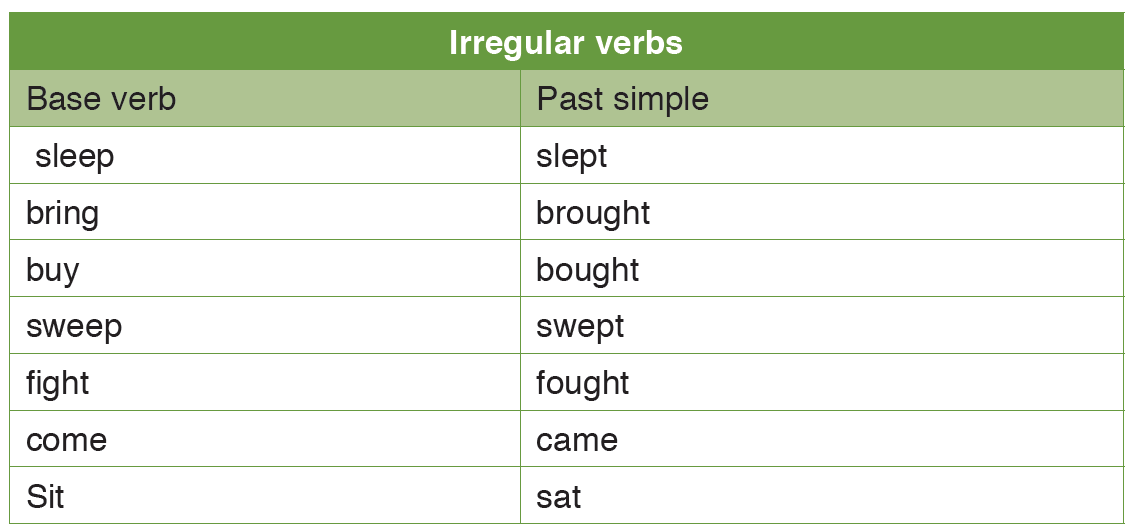
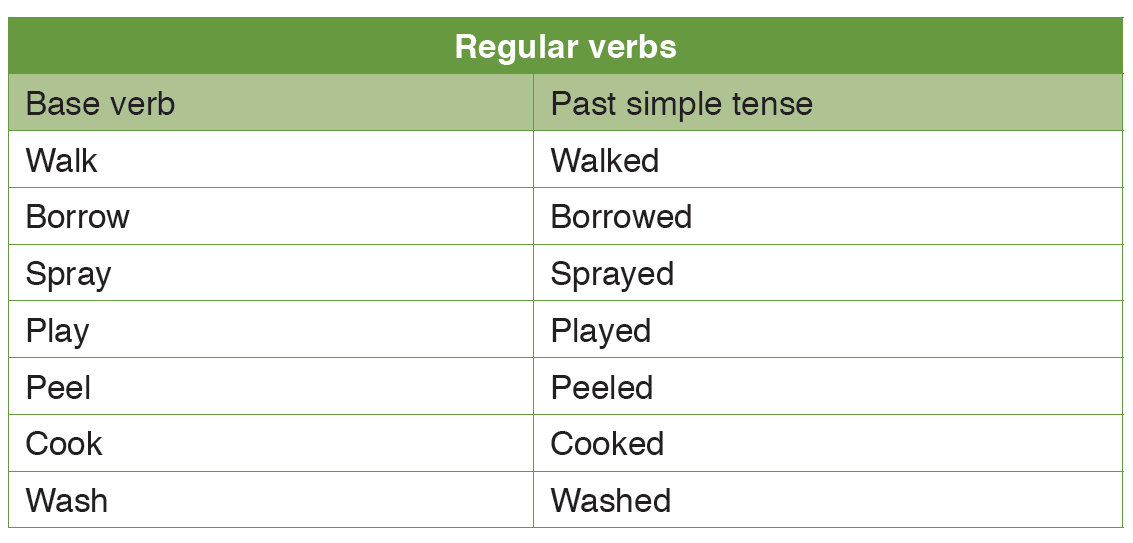
C. Nouns: Proper nouns, Common nouns, Collective nouns,
Abstract nouns Countable and uncountable nouns
• Definition
A noun can simply be defined as a word that names a person, place, thing or an idea. There are different types of nouns, but our focus will be on proper, common, abstract, collective also known as mass nouns, countable or uncountable nouns.
Abstract nouns: These are nouns that denote ideas, qualities or state rather than concrete objects.
Examples of abstract nouns can be qualities such as politeness, intelligence etc.
Collective nouns: They are words that are used to name a group of things, persons, or animals. Examples include a flock of sheep, a gang of thugs, a crowd of people, a fleet of trucks, a herd of cattle etc.
Common noun: It is a word used to name general things, places, ideas, events, or people. Common nouns are also termed as general nouns and do not provide a specific name.
Example: a table, a desk, a class, a black or white board.
• Proper noun: Is the name of a particular person, place, organization or thing. Proper names begin with capital letters when written. We also use capital letters for festivals such as Easter, Christmas, Iddi etc.
• Countable and uncountable nouns: Countable nouns are words used to name things or persons that can be counted for example bottles, books, cups, girls, boys while uncountable nouns are for things, animals or persons that cannot be counted. Examples include Air, sand, wind, crowd, etc.
D. Pronouns: Personal, indefinite, demonstrative, relative, reflexive, reciprocal and possessive pronouns , interrogative
pronouns. Pronouns are words that replace nouns in sentences. We normally use pronouns to limit repetition of nouns that have been used in sentences.
The types of pronouns include, personal, indefinite, demonstrative, relative, reflexive, reciprocal and possessive pronouns. In this unit, only personal, possessive and demonstrative pronouns are described.
1. Personal pronouns can be subjects or objects in sentences.

2. Possessive pronouns
Possessive pronouns are words that indicate ownership or possession in a
sentence. These pronouns show that something belongs to someone.
Examples include, my, our, theirs, his, hers, mine, yours.
3. Demonstrative pronouns.
These are pronouns that are used to directly point at something specific within a sentence. These pronouns are very few but are extremely relevant in language. Examples include; such, this, that, these, none, neither and those.
This is used with nouns in singular.
These is a plural form of ‘this.’ These is used with nouns in plural.
That is used with nouns in singular.
Those is the plural form of that and is used with nouns in plural.
Examples
1. This is my book.
2. Are these books yours?
3. That book is not mine.
4. Those books are John’s.
Exercise
Fill in the blanks with; this, these, that, those
1. …....... is Robert.
2. …….. pencils are mine.
3. Put …… chairs into the corner.
4. Is ……… your house?
5. Are ……… computers broken?
6. ……….. girl in front of the cinema hall is my sister.
E. Articles: Indefinite articles, Definite articles
An article is a word that accompanies a noun to specify its grammatical definiteness. Articles include: a, an and the. They can be definite or indefinite.
Indefinite articles
Indefinite articles are; a and an. They are used in several ways:
1. We use the indefinite articles (a and an) when we refer to any person or thing and not a particular one. For example
a. She gave me a radio.
b. Kamali is afraid to use an escalator.
• Note
The words “radio” and “ escalator” in the examples above are referring not to particular but to general items.
2. We also use indefinite articles when we mention something for the first time.
Example: A farmer approached an officer with a petition.
The farmer felt a bit scared because he did not know how the officer would react to the petition.
3. We use the indefinite article an when the word that follows it begins with a vowel sound. A is used when the word that follows it begins with a consonant sound. Look at the examples below.
a. Her fiancé gave her a ring.
b. The girl gave an answer.
c. I prefer working in a university.
Definite articles.
The definite article the is used to refer to particular things or persons. It is used in the following ways:
1. It can be used with both singular and plural nouns, unlike the indefinite articles.
2. It is used when we mention something that we had mentioned before.
Example: A farmer approached an officer with a petition. The farmer felt a bit scared because he did not know how the officer would react to the petition.
3. We don’t put an article before the name of a country unless it starts with united, for example, the United States of America or the United Kingdom; or its name contains the word Republic or Union, for example, the People’s Republic of China.
4. When referring to languages, we use the in the following ways: we say the English language and not English language; We say fluent in English and not fluent in the English
F. Conjunctions: Whereas, While, When, Where
In the text above you must have come across the sentences below. Read them carefully and explain the role of the highlighted words.
1. A home is generally defined as a place where one lives permanently
2. The term nuclear family refers to the family group consisting of parents and children, while extended family includes all those with kinship ties.
3. Nuclear family is composed of parents and siblings, whereas extended family is made up of all people from the same ancestors.
• Notes:
A conjunction is a part of speech that is used to connect words, phrases, clauses, or sentences. Conjunctions are considered to be invariable grammar particles. Below are some conjunctions that are used to contrast two similar things.
a) Whereas
Whereas is a conjunction which is used to highlight an important difference between two similar things or facts.
When whereas comes at the beginning of a subordinate (dependent) clause, we put a comma before it.
Examples
1. Nuclear family is composed of parents and siblings, whereas extended family is made up of all people from the same ancestors.
2. The term nuclear family refers to the family group consisting of parents and children, whereas extended family includes all those with kinship ties
3. People say ‘fries’ in America, whereas in Britain they call them ‹chips›
N.B.
When the clause with whereas comes before the main clause, we put a comma after that main clause.
Examples:
1. Whereas extended family is made up of all people from the same ancestors, Nuclear family is composed of parents and siblings.
2. Whereas Bugesera has very hot summers, Musanze summers are sometimes quite cold.
3. Whereas street children don’t get affection, children in families get enough care.
b) While
While can be used instead of whereas
Examples
1. Nuclear family is composed of parents and siblings, whereas/while extended family is made up of all people from the same ancestors.
2. Children in orphanages are sometimes sad, whereas/while children in families are usually happy.
While can also be used to express time. In that case it introduces a time clause and means “at the same time” or “during the time”.
Examples
1. While the kids were having a nap, the mom could have a relaxing bath.
2. I remembered I had forgotten to buy food while I was just leaving the market.
c) When
When can be used in different ways, but when it is used as a conjunction it means at the time that. The clause with when is a subordinate clause (sc) and needs a main clause (mc) to complete its meaning.
If the when clause comes before the main clause, we use a comma. When can be used to talk about the past, present or future as explained below.
Talking about the past
Examples:
1. When I was younger, there were no houses here.
2. Nobody spoke when she came into the room.
Talking about the present
Examples:
1. When a new child is born, there is a lot of joy in family.
2. There is a lot of joy in family when a new child is born.
Talking about the future
• Notes:
In references to the future with when, we use the present simple or the
present perfect in the when clause, not the future with shall and will:
Examples:
1. When the new park opens, my father will take me there.
Not: When the new park will open, my father will take me there.
2. When I’ve finished my homework, I’m going to phone my dad.
Not: When I’ll finish my homework, I’m going to phone my dad.
We can also use when to mean “considering that”.
Example:
What’s the point in going out when we have to be home by eleven o’clock?
d) Where
Where is used as a conjunction to mean ‘in the place that’ or ‘in situations that’. The clause with where is a subordinate clause and needs a main clause to complete its meaning. If the “where clause” comes before the main clause, we use a comma.
Examples:
1. Where you find a lot of water, you will also find these beautiful insects.
2. Where you have to pay a deposit, be sure to get a receipt.
Exercises
Using conjunctions and articles in sentences
i. Choose the right words from the brackets to fill in gaps in each of the sentences below.
1. Kariza, will you lay the table……. I help your sister with her maths exercise, please. (whereas/while)
2. The twins are very different: Kalisa is shy and reserved……. Kamana is outgoing. (whereas/while)
3. My aunt Sophie is a doctor……………. Uncle Pete is a dentist. (whereas/where)
4. I remembered my keys……………. I had left. (while/when)
5. Dad would like to have a holiday in Spain………. Mom would prefer Italy. (whereas/when)
6. Why carrying bed covers in Musanze…………… we have to sleep in a hotel. (where/when)
7. A home is generally defined as a place……………. one lives permanently. (where/when)
8. When my mother ……………… I will tell her that you didn’t mop your room. (comes, will come)
ii. Use a, an or the to fill the blanks in the following sentences. The first one has been done for you.
1. My mother considered it an hour to receive the reward promised by the President.
2. Your car is very nice. Does it have ---------DVD player?
3. Kamali rested at home in --------------garden-------------whole meaning.
4. Kalisa found --------cat. --------- cat belongs to his neighbour.
5. Keza has got -------job in ---------bank in Kigali.
6. She is --------useful person most of -------time.
Vocabulary: Word and Sentence Formation
Notes
Vocabulary is the basis for the development of all the other skills: reading comprehension, listening comprehension, speaking, writing, spelling and pronunciation. This is the main tool that helps in the use of English effectively.
Exercises
1. Copy words in column A in your exercise book and match them with their meanings in column B.
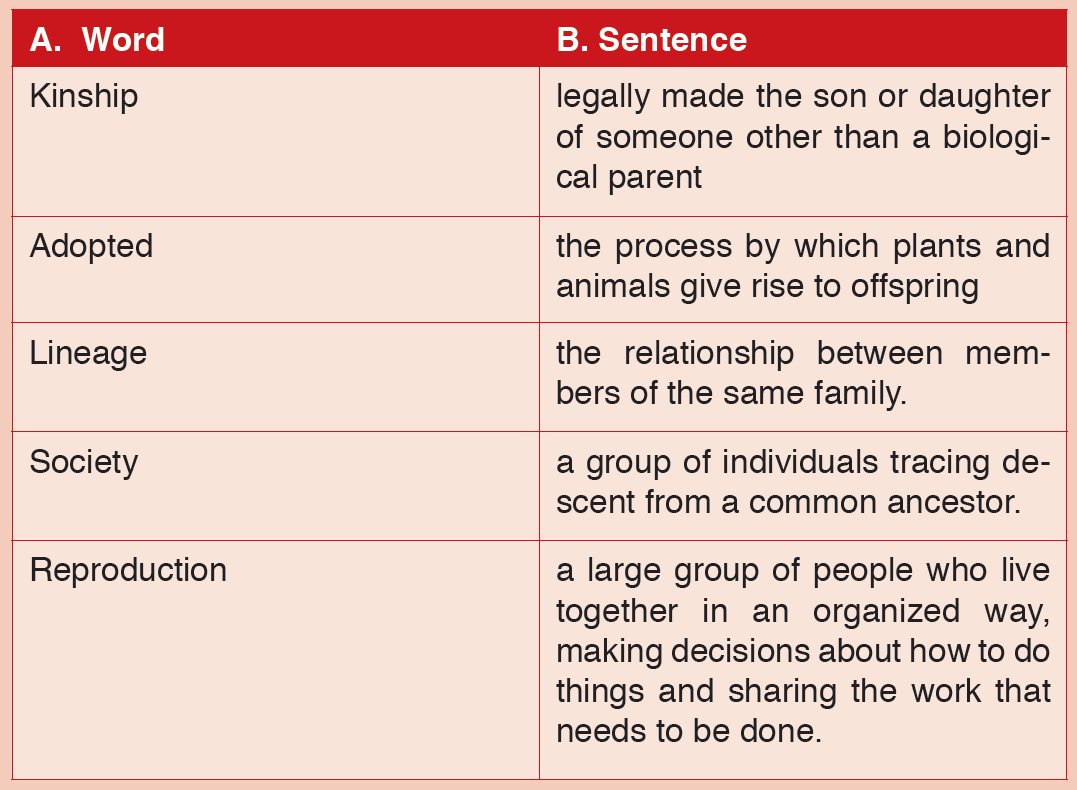
2. Use each of the words above in your own sentence.
I . Complete the sentences with the correct form of the verbs in brackets.
1. Kamali and Kalisa often……. to parties yesterday. (go)
2. Jenny sometimes …………Monica. (meet)
3. In summer, children usually…………… in the garden. (play)
4. Kalisa …………… the board every day. (clean)
5. My sister…………… blue eyes. (have)
6. Bill…………. the window at night for it is always hot here. (open)
7. They all………………. dark blue pullovers when it is cold. (wear)
8. He always……………. the housework himself. (do)
9. My mum……………. shopping every Friday. (go)
10. I never……………TV in the morning. (watch)
11. Fred…………. football last week. (play)
12. Hannah and Betty often…………… pizza. (eat)
13. Frank ………. Watching TV. (like)
ii. Decide whether to use a, an, or the for each of the following sentences.
1. _____ flowers he gave me are beautiful.
2. Her dad sings her _____ song each night before she goes to bed.
3. Have you ever eaten _____ raw egg before?
4. Excuse me, do you have _____ time?
5. He had _____ exciting day today.
6. Bob forgot to bring _____ cake he baked.
7. Can you please return _____ records you borrowed?
8. Fred met _____ wonderful group of people last night.
9. _____ people Scott met were also nice. Tell me _____ story!
iii. Write a 100-word composition explaining why living in a family is better than living in an orphanage.
UNIT2: CAREER AND CHOICES
Key unit competence: To use language in the context of Career and Choices
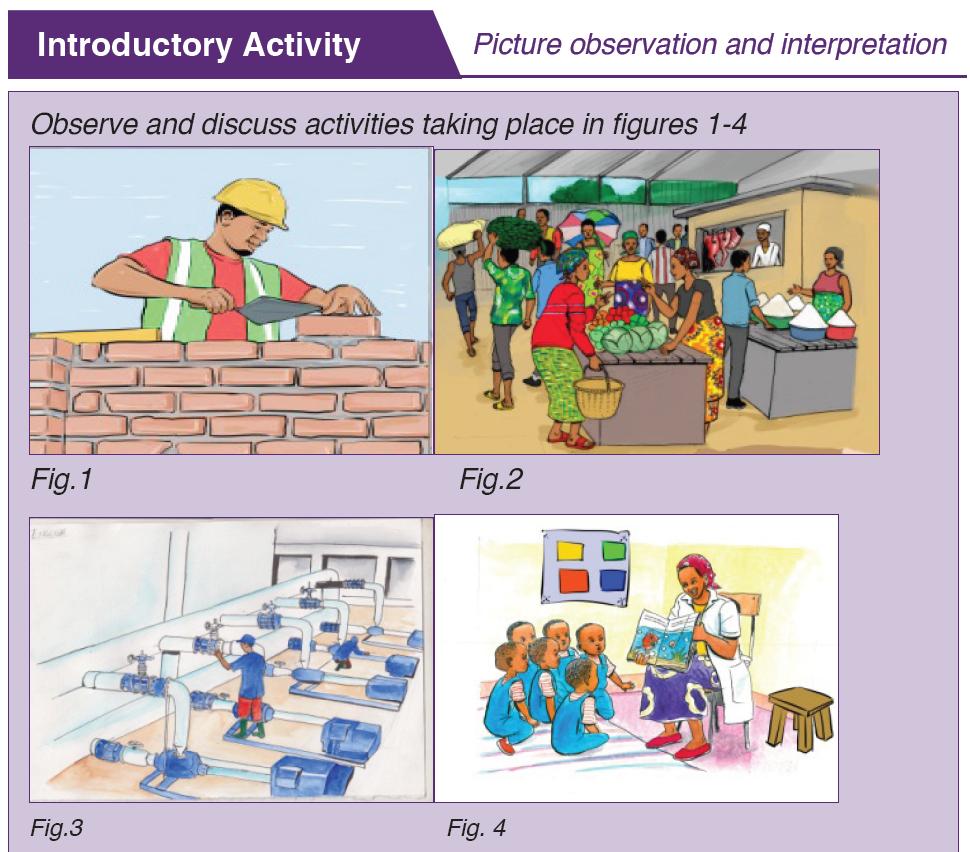
Questions for discussion
1. Identify different activities that are taking place in each figure.
2. Why do you think people do different jobs?
3. What would you do if you chose a career and found it too challenging?
2.1. Describing different types of careers and specific jobs
Picture interpretation
Observe the following pictures and discuss different types of careers and specific jobs highlighted.
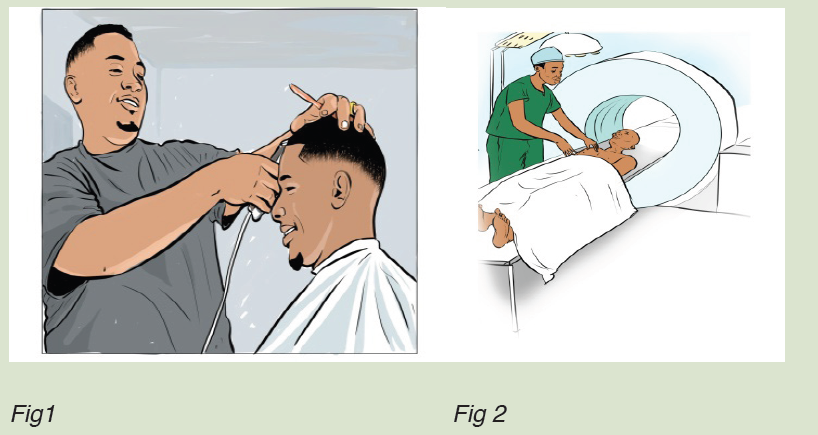
Text 1: My Job experience
• Pre-reading questions
1. Why would you choose a particular career?
2. What would you do if you chose a career and found it too challenging?
I was born in Kigali, Rwanda, and completed culinary art training in a TVET after which I went to Rubavu.
My work experience includes: Cook at Ryoherwa Hotel, Rubavu, chief cook at Serena Kigali and manager at Good life Hotel, Kigali.
From a very young age, I spent a lot of time in the kitchen with my mother who loved cooking local meals for us. I knew it was going to take a lot of hard work to be a chef but I am passionate about food and enjoy cooking as part of my life. My job involves managing a kitchen team, preparing for classes, teaching classes, television cooking demonstrations as required and some administration to ensure the smooth operation of the kitchen.
Doing something I love every day makes me feel happy. On top of that it is extremely rewarding to teach others. Also, demonstrating cooking on TV has made me so famous that everywhere I go people want me to stop and talk to them. Despite all the good things about my job, there are also setbacks. I remember one time when my fellow cook put too much salt
in the food and as the leader I had to explain how it happened. The work requires a lot of attention and time since we are dealing with high class people with different tastes, health issues and emotions. At some point in the future I would like to run my own baking business - making wedding cakes from home or start my own cookery school. I advise all high school students to find something they love and are passionate about in life and go for it.
On the other hand, my friend Umurerwa got a different experience where on her first day on the job walked into the editorial offices. It was 9.30 in the morning. For a moment she hesitated at the lift but fortunately she was unnoticed by the people seated at the their respective desks.
She took a deep breath and stepped into the office. A sudden silence descended as people looked up at the sound of her heels. She tried to relax as she walked across the floor and nodded to those who caught her eye.
My first day on the job, she thought. Then the buzzing of telephones and the hum of conversation resumed. She tapped lightly on the glass door.
“Mr. Kagabo!” The editor-in-chief came to his feet as he looked up to see Umurerwa at his door. “I was only expecting you tomorrow!” I know, but I was free and I decided to come in...”
“You’re welcome, anyway. Fred Laurence,” he introduced himself. “I am very glad to see you. My doctor has insisted that I leave by the end of next week. It is good that you have come in sooner.” “Umurerwa, you are an experienced editor. You will pick up the routine soon enough. The staffs know their jobs. Let me introduce you to the day editor.”
Umurerwa looked in the direction Fred pointed, and saw a man looking at her intently. The expression in his eyes was so malevolent that she involuntarily took a step back.
The next moment she heard a strangled sound behind her. She turned in time to see Fred collapsing at her feet, clutching his chest with both hands...
The hard work will eventually pay off even though it may feel exhausting at times.
• Comprehension questions:
1. What did the speaker in the story study and from where?
2. Describe the nature of the speaker’s work.
3. Why did the speaker choose this career and how has it benefited him/her?
4. Do you support the idea of the speaker starting his/her own business?
Give two reasons.
5. Where (in what type of business) would you expect to find an editorial office?
6. What job has Umurerwa been appointed to take over?
7. Do you think Umurerwa and Fred are going to spend any time
working together? Explain your answer.
8. What piece of advice would you give your friend regarding choosing a career after reading this story?
9. Discuss the importance of different types of careers and specific jobs
Text 2:
An occupation undertaken for a considerable period of a person’s life and
with opportunities for progress is known as a career. It is the process and
actions taken by a person throughout their lifetime in relation to his or
her occupation. One’s career is described by the jobs held, titles earned
and the work accomplished over a long period. Education and training, to
a large extent, determine the job or career an individual pursues. This in
turn determines the amount of income an individual earns. Education for
example, covers various fields.
The school curriculum gives an opportunity for learners to be exposed to
a wide range of fields at the basic level. Once they have basic knowledge
on virtually all fields, they are then able to choose areas of interest in which
they can pursue a career later in life. These choices determine what type
of education an individual gets and the kind of job he/she is likely to do. A
career plays a big role in peoples’ lives as discussed within the following
paragraphs.
In fact, be it a boy or a girl, these days’ career is given a lot of importance
in a person’s life. From the beginning itself, we are asked to concentrate on
our studies and score well in the exams. The ultimate motif of doing this is
to build a strong base and fetch good grades that would help you build a lucrative career.
Having a career is one of the most important things in life because; it’s how
money is made and a main source of income. Imagine having to wake up
every morning of everyday and then having to go to a job that you dread.
Having a career allows a person to make money doing what makes them happy, unlike a dead end job that you work doing work that’s hated. Finding a career isn’t always as easy as it sounds. While in high school or even coming
out of high school, many students are undecided on what field they want to
go into. It becomes hard trying to figure out what careers are available, what
things people are good at, and what will make a person happy and stable in life.
In conclusion, you must choose your career cautiously as various aspects
of your life are attached to it. Take your time, explore all the options, seek
advice from those you are experienced and then take a decision. Once you
choose a career, work hard so that you are able to get into the field of your choice.
• Comprehension questions
1. Explain the importance of a career and specific jobs
2. Which advice would you give to the person who wants to choose a certain career?
2.1.2. Application activities: Job vocabulary and expressions
Match the following words with their definitions and say whether the word defined is a noun, verb or both:
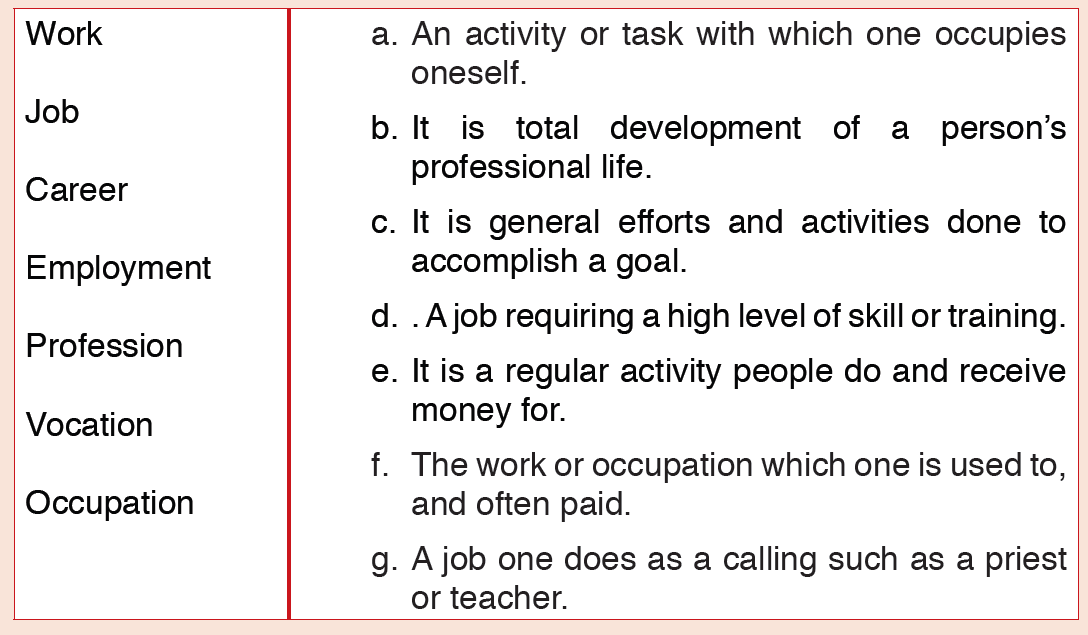
Match the following words with their definitions and say whether the word
• Complete the sentences with the words; work, job, or career
1. The reporter has done some excellent freelance____________________ for us. We should give him a permanent
___________________.
2. John is an emergency doctor. He has a very demanding______________.
3. She went shopping with some friends from ___________________.
4. Being a janitor is a dead-end ______________________ .
5. He has been on the ____________ hunt for several months, but he hasn’t found any vacancies.
6. If I were you, I wouldn’t access Facebook when you are at_________________ .
7. His father retired last year after a brilliant ___________________.
8. Working with refugee children was one of the most rewarding__________________ I’ve ever had.
9. They have been checking the ___________ listings online and in the newspapers to find a ___________
10. My sister isn’t home yet. She is still at _____________________ .
2.2. Talking about qualifications
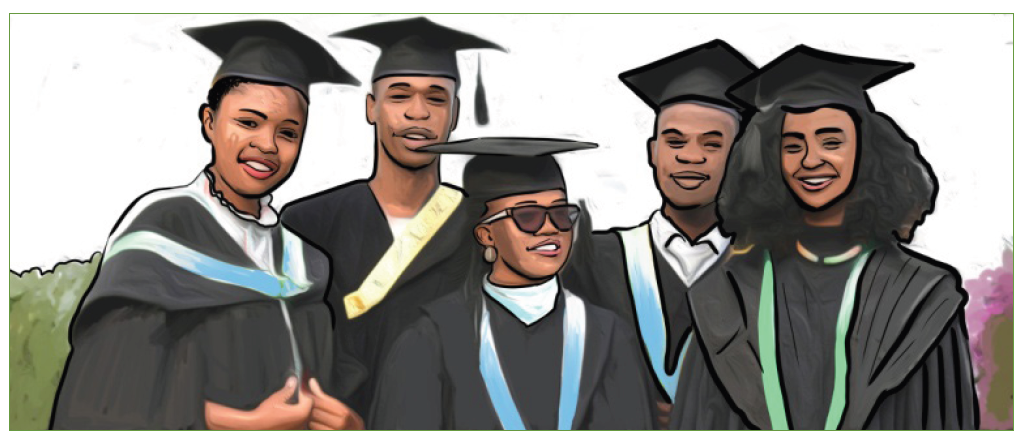
2.2.1. Learning activity: Reading and text analysis
Read the qualifications of the person below and answer the questions that
follow:
“There are as many kinds of careers as there are people. They are like
clothes, you have to choose the size and style that suits you.”
Ms. Kagoyire is a graduate with a Bachelor degree in Business Administration.
She majored in Finance from the University of Rwanda. She has by now
worked as a bank manager at Bank of Kigali for two years and she is one of
the most successful bankers in the country.
While studying this course she was so practical. She started a savings and
credit co-operative which has become a micro-finance organisations. It is
mainly women that work in this co-operative. To get a job here, one has to
be a qualified accountant with a bachelor’s degree or diploma.
When she was in secondary school, Ms. Kagoyire studied entrepreneurship
and initiated projects related to business. One of her projects called “Smart
Business Minds” won a national award and the certificate she got has made
her popular in the business community. Other business people see her
as a lady with great initiative and with plenty of ideas that can help their
companies grow.
The courses she took at university included communication and marketing.
She has demonstrated a history of meeting sales’ goals and producing
accurate, timely reports which gave her promotions and awards such as the
best employee of the year.
Ms. Kagoyire is a motivated, friendly business professional with eight years’
work experience in communications and marketing. She has the ability
to do multiple tasks, manage others, and effectively communicate while
maintaining a high quality of work.
As conclusion, as far as qualifications are concerned, for many careers you
have to have certain qualifications. For example, in order to be a doctor you
have to study for a degree in medicine. It takes about six years in order to
become a general practitioner. For some of the specialized areas you might
have to study abroad. Then, to become a nurse you have to study for a
nursing diploma at a school of nursing. There are eight schools of nursing
in Rwanda, one dental school, and one school of public health. There are
also five government schools of nursing and midwifery. It is also possible to get a nursing degree from university. In order to become a lawyer or an accountant, you also have to go to university. Again, Centers for Vocational
Education and Training teach a number of interesting skills that enable people to be employed and to start their own businesses.
They offer courses for those who wish to become plumbers, electricians, chefs and motor mechanics. These centers were established in addition to TTCs which produce Nursery and Primary teachers as their career.
People differ in what they follow in their education according to what they
expect from a career. Many people desire a high income. Some work and
hope for fame. Others want adventure. Still others want to serve people and
make the world a better place. So, think about what you want to achieve in life before you make a decision.
• Comprehension questions
1. What has Ms. Kagoyire studied throughout her education?
2. List three good qualities that Ms. Kagoyire has.
3. What is Ms. Kagoyire experienced in and for how long?
4. Give at least three achievements of Ms. Kagoyire in one paragraph.
5. Explain different ways or channels people may use to get careers.
2.2.2. Application activity: Using the present perfect tense
1. Fill in the gaps using the present perfect tense.
The world of employment....1....... (change) since the advancement of
technology. Many secretaries ....2........ (update) themselves on the use
of computer programs in order maintain their careers. However, as they
......3....... (update) themselves, software developers ......4........ (make)
new ones while others have upgraded the existing ones.
I know of a neighbour who studied computer science but ......5........
(search) for a job in almost every office and has not got one up to now.
He says they ......6...... (interview) him on programs he didn’t study.
Even those he studied, he ......7...... (not/practice) them; so he doesn’t
remember them well.
Another old man ......8........ (complain) to whoever he meets about his two
sons. He says they finished studying but they .......9....... (look) for jobs all
in vain. One son......10....... (work) in a supermarket as a salesman yet he
studied law. He is worried that he......11...... (wasted) his money on them.
He is thinking of giving them capital to create their own internet café.
2. Write a narration of around 300 words to talk about Kagoyire working
experience using your your own words.
2.3. Recounting a career
2.3.1. Learning activity: Reading and text analysis
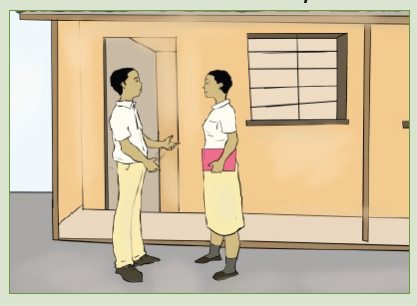
Read the dialogue below and answer the questions on it.
Keza: Ntwari. I just want you to know that I’m going to go to school to become an auto mechanic.
Ntwari: Uh what? Does Dad know about this?
Keza: Who cares? It’s my life. I really enjoy working on cars.
Ntwari: Oh, I get it. You want to study auto mechanics because of your new boyfriend. Listen, auto mechanics is a man’s job.
Keza: No, you are wrong. My boyfriend is studying electrical engineering.
Do you think everyone wants to be like you? You can’t even change a bulb.
Ntwari: Hey, that’s not fair.
Keza: My boyfriend has actually decided to study something practical in addition to law. He is also taking cookery classes.
Ntwari: Cooking? Cooking? That’s a woman’s job.
Keza: I cannot believe you still think like that. A man can be a cook, and they can do the job just as well as anybody else.
Ntwari: Uh. Let them but I won’t cook for a woman.
Keza: Sincerely speaking, my aunt has been in Kenya for three years doing engineering courses and now she is an outstanding engineer in our country.
Ntwari: Well, they can if they want to. I just think that women are better suited to be secretaries, waitresses, and piano teachers. You know.
Keza: And you have said that women can’t be farmers, carpenters, or truck drivers?
Ngabo: Oh, well, just forget this. But not to change the subject, I’m having a problem with my car, can you help me?
Keza: Forget it. Start pushing!
Ntwari: Ah! Forget the conversation and help me please?
• Comprehension Questions
1. In the past, what kinds of jobs were mainly done by men or women in your community?
2. Is this still true today, or is this trend changing? Explain
3. What are the reasons for these changes: social, religious, or economic? Explain
2.1.3. Application activities: Writing practice
1. Choose one family or community member and recount his or her career.
Explain, what the person does, how long he/she has done it,
his/her specific roles in the job and evidence to show that she/he likes the job etc.
2. Debate on the following topic:
“In the past, some people believed that Women could only be secretaries”
2.4. Describing a job in advertisement
2.4.1. Learning activity: Reading and text analysis
Pre-reading activity
Study the following a given job advertisement format and list the information required in a job advertisement.
Text: A job advertisement
Read this job advertisement and answer the questions below:
Ishema Business Co. Ltd
Ishema Business Company Limited seeks to recruit a highly qualified
candidate to fill the vacant post at our new branch in Musanze District.
Secretary
Qualification
• Bachelor’s degree in secretarial studies, Business Administration or related field
• Good command of English, French and Kinyarwanda.
• Computer literate in Microsoft office, internet, e-mail and adobe programs.
Experience
A minimum of five years’ working with international business.
Having between 20-30 years
Job requirements
• Attention to details and able to identify mistakes in documents easily.
• Ability to work extra hours.
• Organized in filing information.
Applicants should be Rwandans and attach a photocopy of their national ID and their recent passport photo.
Interested applicants can send their application letters, curriculum vitae and academic transcripts to the following email(Ishema.Co.ltd@gmail.com).
The Human Resource Ishema Business Company limited, P.O box 3434,Musanze, at the company offices.
• Comprehension questions
1. What is the vacant position?
2. Who advertised the job?
3. What does this position do?
4. What educational background is required?
5. What age is required? Why is age important when looking for an employee?
6. What computer skills are required?
7. What language ability is required? What is the importance of language for this post?
8. How can an interested person apply for the job?
9. Where can an interested person apply for the job?
Practice
Read the job advert below. Discuss the qualification and experience
required of applicants. Then write a paragraph as one of applicants.
Save the children Rwanda would like to recruit a receptionist.
Responsibilities include:
• Welcoming both local and international visitors in person or on
telephone; answering or referring inquiries.
• Directing visitors by guiding them;
• Maintaining organizational and departmental directories Maintaining
security by following procedures; monitoring logbook; issuing visitor badges.
Apply to: SCI Rwanda RT @SCI Rwanda or using Postal Address. P.O.
Box 2953. Kigali, Rwanda
2.5. Language structure: The Present Perfect and Present
Perfect Continuous
Present prefect tense
This tense connects the past with the present for completed or unchanging
actions or events. It cannot be used to make a reference to a particular point
or period (like last week, in January, at 2.am, etc.)
It is used for:
• Completed actions or events at some time before now. (no particular time given)
• Actions or events in periods of time not yet finished.
• Achievements
• Actions with ever or never with no reference to any time up to now
• Unchanging situations in periods of time up to now
• Series of completed actions up to now
• Future actions after some conjunctions: after, before, as soon as, until, for, since, this week/month/year, etc.
Generally,
The present perfect tense is used when talking about:
a) actions which took place in the past, but whose time is not precise or mentioned.
e.g. Have you been to Moscow?
b) experience.
e.g. Have you ever travelled by plane?
→ Yes, I have. No, I haven’t.
→ No, but I’m planning to.
c) news.
e.g. Our country has sent an Ambassador to DRC.
B. The use of since and for with the present perfect tense
a) Since:
NB: since is used between a moment in the past and now.
Examples:
1. The population of DRC has increased since 1970.
2. Rwanda has been independent since 1962. (this means that Rwanda
became independent in 1962 and that it is still independent).
3. His Excellence the President of the Republic of Rwanda has ruled the country since 2000.
4. You have been students here since January 2011.
b) for
NB: For is used during a declared length of time.
We are in 2019, Rwanda has been independent for 57 years.
You have been students here for one month.
Our English teacher has taught us English for one month.
• Generally, the present perfect tense is formed by the auxiliary verb
have/has + the past participle of the main verb.
• The perfect tense is used with since to indicate the beginning of a period of time.
• The present perfect tense is used with for to indicate the duration of a period of time.
The use of just, almost, already and yet.
Question: Have you written the other letter?
Different answers may be given:
• Yes, I have already written it.
• Yes, I have just written it.
• I have almost written it.
• No. I haven’t written it yet.
• No. I haven’t yet written it.
• I am still writing it.
2.6. End unit assessment
1. Put each of the following words in its correct place in the text below
Successful, engineer, lives, teens, profession, choose, interests, decisions, character, job, answer, career
It is very important for everybody to make the right choice of 1) __________.
And it is no wonder because there are a lot of honourable professions to choose
from, for example, the profession of a teacher, a doctor, a computer-operator,
an 2) __________, a journalist, an agronomist, a miner, a fitter, etc. It is difficult
for the young people of seventeen to give a definite 3) __________. There are
lots of people who take 4) __________ about their professions and their career
very easily. It is a matter of fact that only few of them become successful in their
careers and their 5) __________. Such people don’t gain much success in their
professions and their careers. The next point is that there is a big difference
between 6) __________ and career. Job is just a place to work in and to earn
your living while 7) __________ involves planning out the journey, picking up
the necessary skills along the way to be successful, and purposely deciding
what your 8) __________, skills and work values are. Choosing a career is a
hot question for school-leavers. I know that leaving school is the beginning of
my independent life, the beginning of a far more serious examination of my
abilities and 9) __________. My parents and school teachers helped me to
10) __________ my future profession. I would like to become a teacher as
my parents are. This profession is to my liking though I understand that it is a
difficult job, but I like people and my long-term dream is to bring up and teach
children. Some people never pick a career. They continue drifting from job to job,
without considering where the drifting will lead. 11) __________ may change
their career interests or goals over time, but a well-chosen career usually leads
to more advanced and challenging opportunities. And let’s face it – you’re likely
to be working most of your life, so why not enjoy what you’re doing. Finally I’d
like to advise you to choose your career carefully and then you will be happy
and 12) __________ in your future life.
Source:
https://en.islcollective.com/resources/printables/worksheets_doc_docx/writing_comprehension career/preintermediate-a2-worksheet/65054
2. Many youths in Rwanda disrespect certain jobs that require using physical energy. Write an article in your school magazine advising such students to give value to all jobs.
3. Choose the correct answer.
1. I love this writer’s books. I (have been reading / had been reading)
them for years.
2. His clothes were dirty because he (has been working / had been
working) in the garden.
3. Where have you been? We (had been waiting / have been waiting) for
you for ages.
4. He hasn’t decided on a career yet, but he (has been thinking / had
been thinking) about it lately.
5. After she (has been playing / had been playing) the violin for ten years,
she joined an orchestra.
4. Complete the sentences with the correct form of the verbs in brackets. Use
the Present Perfect Continuous or the Past Perfect Continuous.
1. Mike has never had an accident and he .......................................
(drive) for years.
2. She had no idea it was so late because she .......................................
(not / watch) the time.
3. “ ....................................... (you / take) your medicine regularly, Mrs
Smith?” “Yes, doctor.”
4. They eventually found the dog after they .......................................
(look) for it all night.
5. How long ....................................... your father .....................................
.. (work) for the company when he retired?
5. Complete the sentences with a suitable word or expression from the following:
for, by tomorrow, so far, the week before, since
1. Our TV hasn’t been working .......................... last week.
2. The Browns invited us to dinner although we had only met ......................
3. They will have finished painting the house .........................
4. We had been writing .......................... nearly an hour when the bell rang.
5. They have interviewed three suspects ..........................
UNIT 3: SOCIAL COHESION
Key unit competence
To use language in the context of social cohesion
Introductory Activity Picture observation and interpretation
Observe the following pictures and discuss
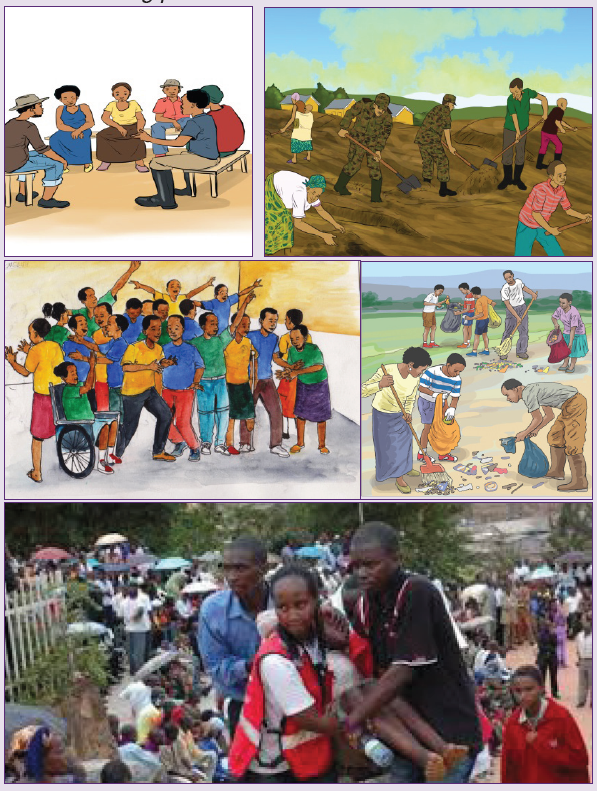
In your discussion, include answers to the following questions:
1. What is happening in the above pictures?
2. What can make people to work together as shown in those pictures?
3. What do we call the harmony and good relationship among members of a group in society?
3.1. Talking about personal values
3.1. 1. Learning activity: Reading and text analysis
• Text: The story of David and Doreen
Read the case study below then answer the questions that follow:
David was married to Doreen who came from a neighboring clan. They lived
together happily. One day, they had a quarrel and David physically assaulted
Doreen. Doreen was very sad and she packed her belongings and went
back to her parents. When her parents heard the matter, they went to the
clan elders to report the whole issue. The clan elders decided that no one
from the clan should interact with members of David’s clan till they asked for
forgiveness. David never involved his clan and therefore no one went to the
elders of Doreen’s clan to ask for forgiveness. Today, the two clans live as enemies.
• Comprehension questions
1. Analyse the problem in this case study. Show who or what contributed to each aspect of the problem.
2. What values did David not have that made him beat up his wife?
3. What values did Doreen not have that made her run away from her husband?
4. What should David’s family or clan have done to show active bystandership?
5. Suggest possible strategies that can be put in place to restore social cohesion between the two clans.
6. Suggest appropriate behaviour among couples that can promote healthy inter clan marriages that lead to social cohesion between clans.
3.1.2. Application activity: Writing a speech
Using information from the case study above, write a speech encouraging
people in your community to use peaceful means while solving problems
and discouraging negative behaviour.
a. Give your speech a title.
b. In your introduction, say what you are going to tell the audience.
c. In the body, tell them what you prepared to tell them.
d. In your conclusion, tell them a summary of what you told them in the body.
e. Read the comprehension and pick out important ideas to use in your speech.
f. Give a colleague to read through and correct for you before submitting.
3.2.1. Learning activity: Reading and text analysis
• Text: The root of social well being
Read carefully the following text and answer questions
Promoting social cohesion is one of the most difficult, yet one of the most important, challenges facing South Africa. However, while there is a widespread agreement that social cohesion influences economic and social development, and that nurturing a more cohesive society is an important policy goal in itself, little progress has been made in trying to measure it and track progress in this domain over time. One of the most severe limitations to this progress is the lack of definitional consensus on social cohesion. It may seem intuitive to describe it as the glue that binds us together, or the forging of a common sense of identity and belonging.
To others, it may speak to a willingness to extend trust to outsiders, to respect fellow citizens and uphold their dignity, and to be moved to action in the face of persistent inequality on behalf of those who are marginalised.
Alternatively, specifically in the South African context, it’s very essence may be seen as common humanity embodied in the notion of ubuntu.
The foundations of contemporary social cohesion theory and practice are often located within the early work of a number of 19th century sociologists.
In “The Division of Labour in Society” (1893), Émile Durkheim characterised social cohesion as an element of the quality of life in all societies (Dragolov etal, 2013a, p.12). Durkheim focused on two main dimensions of social cohesion: solidarity, and shared loyalty between people. Together, these elements created the foundations for social order and established bonds and inter-dependence between individuals (Manole, 2012, p. 128).
This has often been in response to divisions and cleavages within societies, related to factors including economic downturn, tensions associated with migration, and ethnic or cultural conflict. In analysing the extent of social cohesion in Canada, for example, Jenson’s (1998, p. 1) point of departure was evidence of a “fraying social fabric”, “mounting differences” between
people of different socioeconomic groups and worrying instances of “cultural insecurity and nostalgia for ‘Old Canada’ [which] are reducing tolerance and compassion” (Ekos Research Associates Inc., 1995, 17, in Jenson, 1998, p.1).
In this respect then, the recent focus on social cohesion by South African policy makers is unsurprising, given a context of widening inequality, growing unemployment, and persistent racial inequalities. Few would contest that in many ways, South Africa remains a deeply divided society.
It thus perhaps comes as little surprise that, particularly given the declining focus on reconciliation within the national policy agenda, the South African government has increasingly focused on measures to deepen social cohesion through a range of different interventions and initiatives. There are a variety of reasons for this increased interest by governance institutions
and policymakers in social cohesion. The literature proposes a number of positive potential advantages for highly cohesive societies, including: More stable democracies and greater civic participation (Cuellar, 2009, p. 3; Dhéret, 2015, pp. 1;3; Beauvais & Jenson, 2002); Greater productivity and growth, and resistance to the consequences of economic shocks (Easterly, Ritzan & Woolcock, 2009, pp. 10-11; Dhéret, 2015, pp. 1; 3; Beauvais & Jenson, 2002); Better quality of life for citizens, in that cohesive society is simply more liveable and sustainable for people (Pervaiz, Chaudhary & van Staveren, 2013, p. 5; Dragolov et al (b), p.8);
Greater inclusivity and tolerance of diversity and multiculturalism (Dhéret, 2015, pp. 1; 3); Stronger conflict management and resolution, particularly after crises such as radicalism, violence, protests or political divisions, and in fragile states. Better health outcomes, particularly related to the links between health and income inequality, employment and social support measures (Beauvais & Jenson, 2002, pp. 16- 17).
• Comprehension questions
1. What is the meaning of social cohesion according?
2. Which values did the writer talk about in the text?
3. Discuss different benefits and challenges as described in the text.
3.2.2. Application activities: Vocabulary and essay writing
1. Explain the following words as they are used in the text.
a. Conflict management
b. Inclusivity
c. Solidarity
d. Tolerance
e. Bonds
f. Glue
g. Compassion
2. Write a text using the words explained above.
3. Write a speech you would give during Itorero program in your school, sensitizing people about Values that link people together (social cohesion).
3.3. Elaborating on peace and unity
3.3. 1. Learning activity: Reading and text analysis
• Diagram: The Continuum of Benevolence
Study the diagram and answer questions that follow:
• Comprehension questions:
1. Identify different elements that can lead to peace and Unity.
2. Based on the above diagram, explain different values which were lacking in our society and finally led to genocide against Tutsi.
• Text: Dialogue between Rugamba and his Classmate Hope
Read the dialogue below and answer the questions that follow:
Hope: “What are you doing here, Rugamba? I haven’t seen you since June.”
Rugamba: “I’ve just come back from my holiday in Burera.”
Hope: “Did you enjoy it?”
Rugamba: “I love Burera. And the people there are friendly.”
Hope: “Did you attend Unity and peace training?”
Rugamba: Yes, I did. I can show you some pictures. We learnt a lot about social cohesion?”
Hope: That’s good! What were the training expectations?
Rugamba: The training expectations were mainly built on one statement that was stated as “Roles and responsibilities of youth to build and sustain a cohesive society.”
Hope: My dear, I wish I were there too.
Rugamba: Don’t worry Hope, Since I was trained and also given the training manual.
Hope: Did the organizers also plan something for those who did not attend?
Rugamba: Of course yes, you are going to be trained but mainly those from Peace and unity club.
Hope: Thank you Rugamba! Let’s join others in the dining room.
Rugamba: You are welcome hope! Enjoy your meal!
• Comprehension questions:
1. Where did Rugamba spend his holiday activities?
2. Give a reason why Rugamba said that he loves Burera.
3. What was the main purpose for the training attended by Rugamba?
4. What did the training organizers plan for other students as described in the dialogue?
5. Where did they go after conversation?
3.3.2. Application activities:
Role playing a dialogue and writing a report
1. Role play the pre-written role play above and discuss reasons for unity and peace clubs in Rwandan schools.
2. Your village has called a meeting to discuss about Rwandan values for peace building.
You are asked to take minutes as the secretary. Write the minutes and present them to the public.
• Notes:
a. The minutes should include:
b. The minutes have a title containing the date and place where the meeting was held.
c. Members who attended.
d. Agenda/ items to be discussed e.g. Previous minutes, speech from chairman, problems that may happen when there no values among people.
e. Body summarizing ideas for each item on the agenda.
f. Conclusion and time for the next meeting.
3. Vocabulary activity: Choose the right words to fill in gaps Love, Values, Cohesion, relationship, belonging, peace and unity,
conflict, responsibility , social cohesion, caring.
Social ----1--------balances individual rights against those of society and appreciates that a good ---2------------- enables people to respect each other’s------3-------. Therefore, it works towards the wellbeing of all its members. For example, it fights exclusions and marginalization and creates a sense of-------4--------. It also offers members of the group or society the opportunity for upward mobility. This promotes and--------5------- results in both individual and national development.
We often demonstrate positive values in different ways. For example, by solving problems that affect others, helping those in need, having a sense of -----------in what we do, being honest or even being caring to others. All these positive values contribute to ---------------. Finally, sensitize people to---------------one another.
3.4. Language structure: Some forms of the verb
A. Active and passive voice
• Preparatory activities
1. Justify the statement below using examples.
“In academic writing, People show interest in the person or object that experiences
an action rather than the person or object that performs the action.
In other words, the most important thing or person becomes the subject of tthe sentence.”
2. Study the following tables and answer the questions that follow
1. Identify the rules used to change active sentences into passive voices.
2. Why should we use the forms identified in the second column?
• Notes
I. “By” is used in the passive voice when it is necessary to know who does the action.
Example: “Love addicted” was sung by Vamps.
II. Passive voice is used if it does not need to know the perpetrator work.
Example: the streets are cleaned every day.
III. Passive voice is used if we do not know or forget who the perpetrator work.
Example: The police was murdered.
IV. Passive voice is used if we are more interested in the job than the actors who work.
Example: A new departmental store is being built.
• Rules
1. The places of subject and object are interchanged i.e. the object shifts to the place of subject and subject shifts to the place of object in passive voice.
Example:
Active voice: I write a letter.
Passive voice: A letter is written by me.
• Subject (I) of sentence shifted to the place of object (letter) and
object (letter) shifted to the place of subject (I) in passive voice.
2. Sometimes the subject of a sentence is omitted in passive voice, that is if
without its subject the sentence still has meaning.
Example: The traders sell clothes in yards.
Passive voice: The clothes are sold in yards.
3. 3rd form of verb (past participle) is always used as main verb in sentences
of passive voice for all tenses.
eg. A song is sung.
• The word “by” is used before the subject in sentences in passive
voice, to introduce the subject.
Example:
Active voice: He sings a song.
Passive voice: A song is sung by him.
4. The word “by” in passive voice, can be replaced sometimes by words
such as “with, to,’ etc.
Examples:
Active voice: The water fills the tub.
Passive voice: The tub is filled with water.
Active voice: He knows me.
Passive voice: I am known to him.
B. Imperative Sentences
• Definition of imperative sentence
A sentence that expresses either a command, a request, an advice, an
entreaty or desire is called imperative sentence.
• Characteristics of Imperative Sentences
1. The object “you” is generally missing in Imperative Sentences. The
structure of such sentences in Passive Voice is: Let + object + be/ not be + V3
2. In sentences which express request, advice and order, such phrases
as, you are requested to/advised to /ordered to, are used.
3. Word kindly/please is dropped.
C. Modal verbs: must, should
• Preparatory activities
1. Describe some modals verbs that may be used with obligation or
something that a person has to do and when providing pieces of advice.
2. Fill in the blanks using should, must and shouldn’t.
a. I feel sad and lonely. You see a doctor.
b. I have no money. You work harder.
c. All schools in Rwanda create peace and unity clubs.
d. We do our homework because it’s important.
e. Jason has missed the train He be late next time.
f. In England all children wear uniforms at school.
g. Parents or guardians teach their children Rwandan values.
• Notes
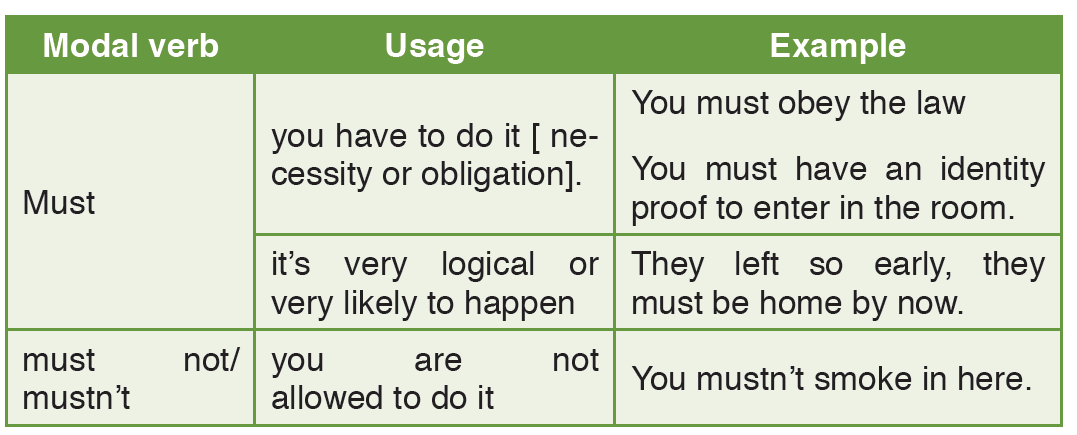
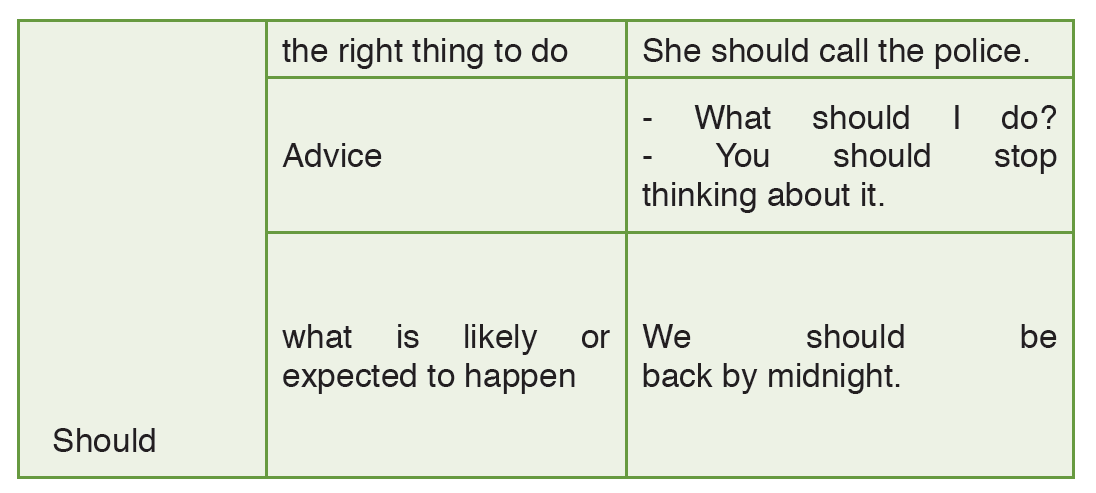

3. 6. Unit summary
This unit discusses social cohesion. The content includes: talking about
personal values that enhance social cohesion, Words and expressions
for social cohesion, elaborating on peace and unity, Modal verbs: should,
must, can, may, Active& Passive voice, vocabulary and sentence formation
activities. You could have seen that social cohesion exist in your community.
This lesson intends to help you understand the role of social cohesion in the
people’s well-being and equip you with the language and skills to do that.
More about this topic is found in general studies and communication skills at
advanced level for other options apart from Teacher training colleges.
3.7. End unit assessment
1. In about 250 words, write a speech you would give to fellow student teachers of Year one about their responsibilities to build a cohesive society.
2. Match the words in the table below with their meanings
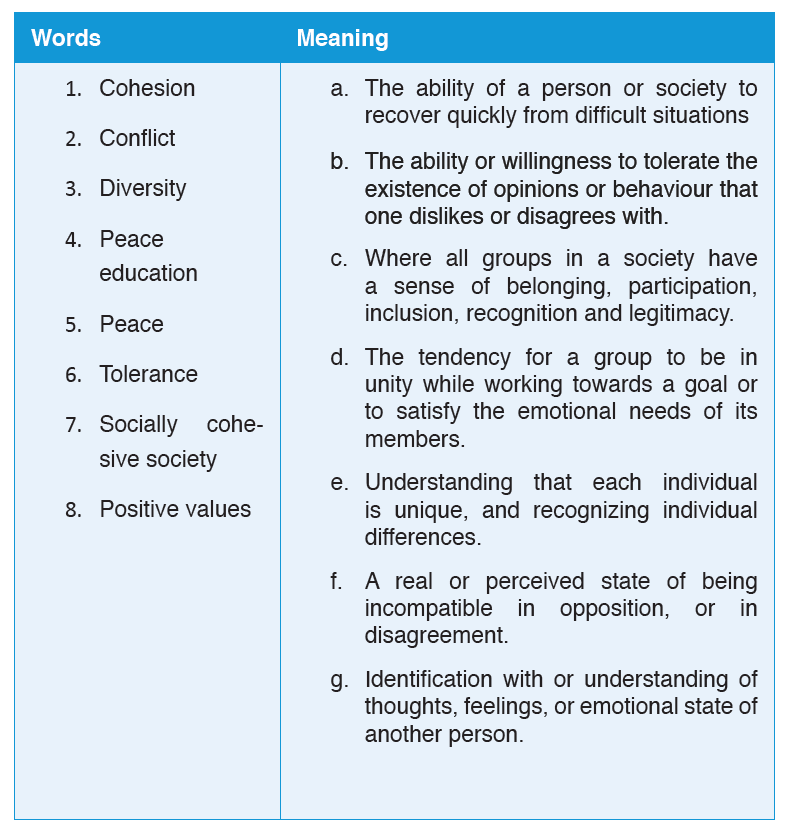
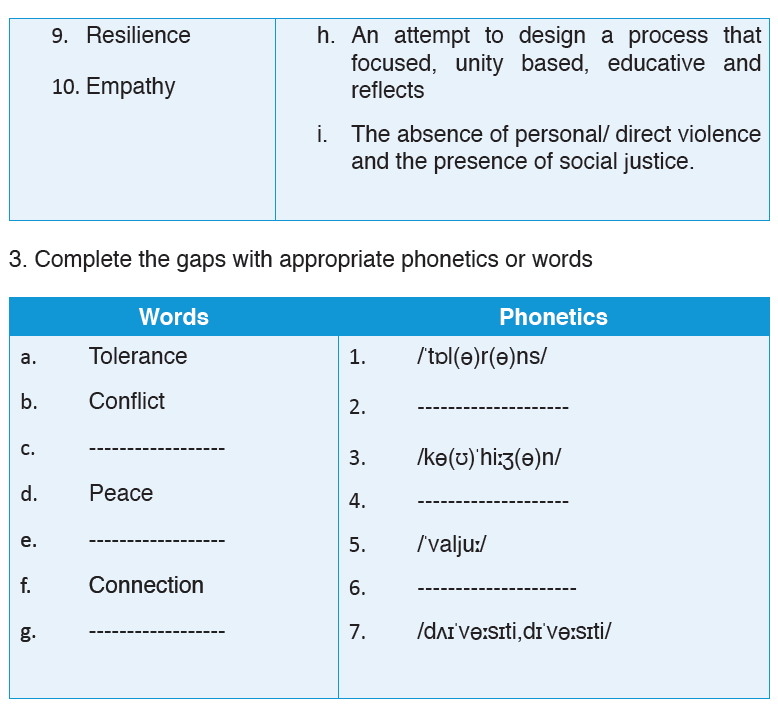
UNIT4: PERSONAL FINANCE AND DEVELOPMENT
Key unit Competence:
To use language in the context of Personal finance and development
Introductory Activity Picture observation and interpretation
1. Observe the pictures and discuss
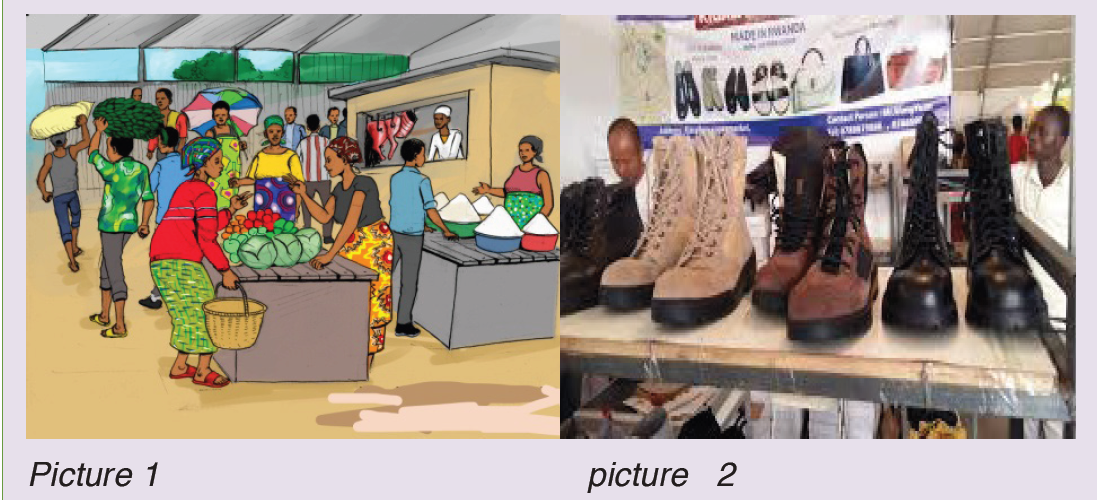
2. Describe what is taking place in the pictures observed.
4.1. Describing financial tools
4.1.1. Learning activity: Reading and text analysis
Pre-reading activity: Brainstorm on second hand clothes and made in Rwanda products.
• Text: Made in Rwanda clothes:
Read through the text and answer the questions that follow:
It started when second hand clothes had been introduced. Second hand clothes were in fashion in Rwanda a few years ago. One day, Ms. Mukandoli, a busy mum and a loving wife, went shopping for nice second hand clothes.
After a few hours of searching, she came home exhausted and disappointed because everyone was struggling to pick nice ones. In 2016, the government of Rwanda increased the price of second hand clothes, some women found it hard to find the right outfit. “I will help them,” Thought Ms. Mukandoli. With very little money, no connections in the fashion world and a community who laughed at her idea that it was not realistic, she persisted and decided to start up her own business. Ms. Mukandoli designed her first collection of twenty clothing items, bought suitable material and a sewing machine. Ms. Mukandoli was a tailor herself.
Her sitting room turned into a workshop. When the collection was ready, Ms. Mukandoli took them to fashion shops. To her surprise, they bought the whole collection at once. When they asked her about the name of her company, Ms. Mukandoli looked at them, smiled and said: “Inyarwanda”. Today many people have fallen in love with products from “Inyarwanda”.Ms.Mukandoli
has hired other tailors and expanded her business. Other people have copied her and now clothes made in Rwanda are on high demand across the country and abroad.
• Comprehension questions:
a. Do you really think that made in Rwanda is on a high demand?
Why?
b. What three difficulties did Ms. Mukandoli face when starting up her business?
c. What special character traits helped Ms. Mukandoli succeed in her new career?
d. What did Ms. Mukandoli do in order to start her business?
e. Where did Ms. Mukandoli sew her first collection?
What did Ms. Mukandoli do when she realised her clothes were in high demand?
f. Why did Mukandoli decide to call her collection “Inyarwanda?
g. What fact proves that “Inyarwanda” is a successful company?
4.2. Talking about Financial terms
4.2.1 Learning activity: Reading and text analysis
• Text: Financial terms
Business owners who struggle with finances should definitely hire an accountant, or utilize accounting software to make things easier. However, while it may be wisest to depend on expert help, it’s still important to have at least a basic understanding of the inner workings of your company’s finances. As such, there are some basic financial terms every entrepreneur should know as their business grows. These terms include; assets, liabilities, expenses, accounts receivable, cash flow, profit and loss, income statement and net profit.
First on the list of financial terms, assets are the economic resources a business has. In a broad sense, assets include everything your company owns that has some economic value.
If assets are the resources your company owns that contribute to its economic value, liabilities are its exact opposite. In fact, liabilities are just that — things your company is responsible for by law, especially debts or financial obligations. For example, any debt accrued by a business in the course of starting, growing, and maintaining its operations is a liability. This could include bank loans, credit card debts, and monies owed to vendors and product manufacturers. Liabilities, like assets, can be divided into subcategories.
As for expenses, business expenses are any cost that is “ordinary and necessary” to run a business or trade. These expenses are the costs your company incurs each month in order to operate, and include things like rent, utilities, legal costs, employee salaries, contractor pay, and marketing and advertising costs. To remain financially solid, businesses are often encouraged to keep expenses as low as possible.
Accounts receivable (A/R) is the amount that clients owe to a business.
Usually the business notifies the client by invoice of the amount owed, and if not paid, the debt is legally enforceable. On a business’s balance sheet, accounts receivable is logged as an asset.
As far as cash flow is concerned, cash flow is the overall movement of funds through your business each month, including income and expenses. For instance, cash flows into your business from clients and customers who purchase your goods or services directly, or through the collection of debts in the form of accounts receivable. On the other hand, cash flows out of your
business to pay expenses like rent, utilities, taxes, and accounts payable.
To remain financially healthy, a business must regularly generate more revenue from the sale of its product or service than it costs to make that product or service. Say it costs a company 2000frw to make a T-shirt, but that company sells the T-shirt for 5000frw. In this case, the company’s profit is 3000frw. On the other hand, a loss is money that a company, well, loses.
For instance, if a T-shirt is stolen or destroyed and can no longer be sold, it would be counted as a loss.
The income statement is where you analyse your company’s profits and losses. As such, it should come as no surprise that the income statement is also commonly referred to as the “profit and loss statement.”
In accounting jargon, your net profit might also be referred to as net income or net earnings. And because it’s usually found on the last line of a company’s income statement, it’s often also called the bottom line. But just what is it?
Well, this is the total amount a business has earned or lost at the end of a specified accounting period, usually a month.
Adapted from https://quickbooks.intuit.com/r/financial-management/15-financial-terms-every-business-needs-to-know/
• Comprehension questions
1. What can an entrepreneur do to have at least a basic understanding of the inner workings of their company’s finances?
2. Differentiate assets from liabilities.
3. Give at least four examples of expenses.
4. Define the term “accounts receivable” as related to finance.
5. What do you understand by “to remain financially healthy” as used in the 7th paragraph?
4.2.2 Application activity: Vocabulary and paragraph writing
1. Use a dictionary and thesaurus to look up the missing meanings of tthe words/phrases in the table below. The words are highlighted in the passage above. Copy the table into your book and fill in the blank spaces.
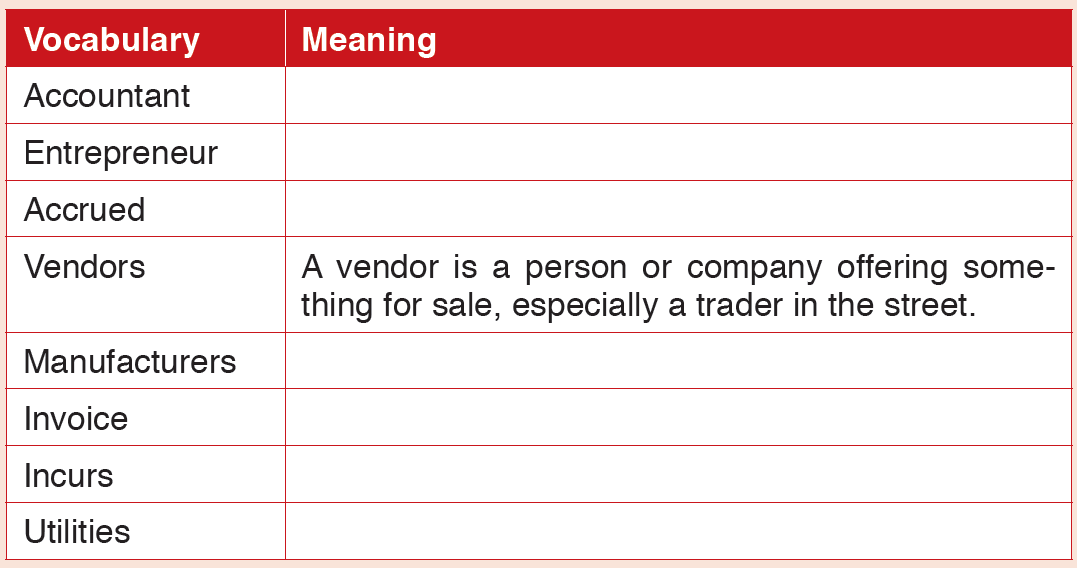
2. Write a paragraph explaining why it is important to know language used in finance.
• Notes
The following table presents some financial terms with their definitions:

3.Write sentences using different terms as they were defined in the table above.
4.3. Idioms related to Finance
4.3.1. Learning activity: Explaining idioms related to finance
Explain the following idioms
1. Cash cow
2. A quick buck
3. Daylight robbery
4. From rags to riches
5. A pretty penny
4.3.2. Application activity:
Discussing and using idioms related to finance in sentences
1. With examples from your own experience, discuss the above idioms.
2. Make 5 sentences using the idioms above.
• Note:
An idiom is an expression that has an indirect meaning:
• a pretty penny – very expensive.
• a quick buck – money which was easy to make.
• cash cow – a business/product which generates a stable flow of income/profit.
• Daylight robbery – obvious, unfair overcharging.
• from rags to riches – from poverty to wealth.
4.4. Describing Financial Institutions
4.4.1. Learning activity: Reading and text analysis
• Pre-reading activity:
Brainstorm about financial institutions that you know focusing on their role in improving people’s well-being.
• Text: Financial institutions in Rwanda
Read the following paragraphs and answer questions that follow:
In Rwanda, we have different types of financial institutions. These include; commercial bank that offers financial services to individuals and businesses.
You can save money in a savings account and ask for a loan.
Firstly, Commercial banks in Rwanda include: Access Bank Rwanda, Bank of Kigali, I & M Bank, BPR (Bank Populaire du Rwanda), Cogebanque, Ecobank and GT Bank, etc.
Secondly, investment bank buys shares in a business and sells them to investors. The Development Bank of Rwanda (BRD) is an investment bank that buys shares from businesses mainly in agriculture and tourism.
Lastly by no means of least, a microfinance company offers smaller loans to individuals or businesses. The interest rates are cheaper than in a commercial bank. Microfinance companies include: Urwego Opportunity Bank, Copedu,
Zigama Credit and Savings Bank
• Comprehension questions
1. What are the types of financial institutions described in the text?
2. Explain the services that commercial banks offer to people.
3. Why do you think that some people can prefer microfinance companies than investment banks?
4.4. 2. Application activity: Sentence formation
Use the following words to make your own sentences with the help of dictionaries.
• Microfinance
• A bank
• Investment
• commerce
• Saving
• Low interest
4.5. Language structure: Use of present tense, word meaning and pronunciation and quantifiers
4.5.1. Learning activity Reading and exploitation of texts
A.Present simple tense
1. Give the present simple tense and pronunciation of the verbs with their sounds of the –s or –e s of the verbs[s/,z/iz].
2. Complete the dialogue using the words in the box bellow, practice their pronunciation.
Style , material , size , colour, Texture.
Customer: I don’t like this dress. It makes me look too old.
Sales Assistant: What _____1__________ of dress do you prefer?
Customer: This coat doesn’t suit me. I hate green.
Sales Assistant: What _______2________ are you looking for?
Customer: These T-shirts are not good for my sons – they will get stained very easily!
Sales Assistant: What ______3_______ do you like?
Customer: I don’t think this washing machine is big enough for my family.
Sales Assistant: What ______4______of washing machine are you looking for?
Customer: I need to order some ice cream for my party, but I don’t like chocolate.
Sales Assistant: What ____5________ do you prefer?
3. Match words with their meaning

Practice
1. Debate
Debate the following topic.
Read the instructions on how to conduct a debate in unite five of this book and debate the following motion:
“Investment is better than saving”
2. Read the paragraph below, discuss and answer questions:
Ruti is a learner. He lives far from his school and is planning to buy a bicycle. Mugisha is a business owner. He delivers bread to many hotels and restaurants in Kigali and is planning to buy a delivery van. Answer the questions about Ruti and Mugisha.
Comprehension questions
a. Give ideas for how Ruti could pay for the bicycle.
b. Why do you think that Mugisha would like a delivery van?
c. Give ideas for how Mugisha could pay for the delivery van.
d. What are the similarities between the things that a person needs and the those needed by a business?
e. Do you think that a business and a private person obtain (get) money to buy items in the same way? Explain your answer.
3. Discussion
Discuss the difference between the cost of things that a private person would like and the things that a business needs.
• Notes
1. Financial terms
This unit explores issues related to personal financial literacy such as saving, budgeting, income and borrowing. It also handles determiners of quantity as well as pronunciation. Activities in this unit are designed to reflect what you probably see in your community or have heard about.
The language skills in this unit are integrated and used in the context of tthe unit. Take time to go through each unit to remind yourself of what you learnt before attempting the unit test.
B. Quantifiers
1 “A little”, ‘little’ and ‘a few’ and ‘few’
Notes
A little and little are used with uncountable nouns while “a few” or “few” are used with plural countable nouns.
• When we say “a little” or “a few”, we mean a small amount, but it’s fine.
• A little is used with small quantity and non-countable nouns. [ A little means a small amount or some.]
Example:
There is a little milk in the refrigerator.
• ‘Little’ means almost nothing. Or not much.
Examples:
1. I’m sorry, I speak little French.
2. There was little time to finish my home work.
3. I have drunk little water this morning.
• Few is used with plural countable nouns. It means not many, not enough.
Examples:
1. I have got few friends in the city. So I am lonely.
2. They have got few cakes on the table.
3. He has few photos on Instagram.
• A few is used with plural nouns. It means some or a small amount.
Examples:
1. There are a few books on the shelf.
2. We stayed a few days in Kigali and visited Musanze.
On the other hand, “little” or “few” usually give us a different impression.
These also mean a small amount, but this time the amount is almost nothing.
If the noun is something that we want (like money or friends) then using ‘little’ or ‘few’ means that we don’t have enough.
Examples:
• Sorry, I have little money. I really can’t afford to go out. (money is not enough)
• The play made little sense to me, but I’m glad you enjoyed it. (sense is uncountable) = the play didn’t make much sense.
• There are few people that I think would be qualified for the job. (people is countable) = the number of people qualified for the job is enough.
2. Much vs. many
Much and many are known as “quantifiers”. They are used to talk about quantities, amounts or degrees. Many is used with plural, countable nouns while much is used with singular, uncountable nouns.
Examples:
1. There are many chequebooks on your desk. (Chequebooks are countable)
2. Many ATM cards were lost this year. (ATM cards are countable).
3. There isn’t much light in this room so let’s open the curtains. (light is uncountable).
4. Too much money was spent on his wedding day. (money is uncountable).
3. Some vs. any
The words some and any are used when the exact number or amount of something is not known, or when it’s not important. Some and any are both used to refer to an indefinite quantity or number. Although some and any are both used to describe an indefinite number, they are used in different ways; some is generally used in positive sentences while any is used in negative sentences and in questions.
Examples:
• I have borrowed some money from the bank. (positive)
• I have ordered some chequebooks. (positive)
• I don’t need any help with my homework because I can do it on my own. (negative)
• There isn’t any milk in the fridge so we’ll have to have black coffee. (negative)
• Do you have any brothers or sisters? (interrogative)
• Do you have any plans for the summer? (interrogative)\
Exercises
1. Fill in the blanks with “little”, “a little”, “few” or “a few”
a. I have……water left. There’s enough to share.
b. I have………. good friends. I’m not lonely.
c. He has ………. education. He can’t read or write, and he can hardly count.
d. There are………. people she really trusts. It’s a bit sad.
e. We’ve got…………. time at the weekend. Would you like to meet?
2. Fill in the blanks with “much” or “many.
a. How…………. players are in a handball team?
b. How……… pocket money do you get per week?
c. How…………… time is left?
d. How……………sisters does Ella have?
e. How……………… coins did you find yesterday?
3. Fill in the blanks with “some” or “any.
a) I have seen…………… nice postcards in this souvenir shop.
b) There aren’t………………. folders in my bag.
c) I have…………… magazines for you.
d) There are…………apples on the table.
e) Pam does not have…………pencils on her desk.
4.6. End unit assessment
1. Fill in the gaps with the correct verb, in the correct form (not) earn, inherit, borrow, lend, steal, find, invest, waste, pay (back), owe, withdraw.
a. When I was younger, I ________1_______ some money in land.
It was a really good idea.
b. I was very sad when my grandfather died, but I used the money I ______2_______ from him to study and I think he would be very happy that I am a teacher now.
c. Claire works as a nurse, but she ________3_______ much money, so her mum often has to
d. _______4_______ her some.
e. When I was a student I had to ______5_________ lots of money from the bank. I ____6______ all the money back last year, so
now I don’t ___7____ the bank anything.
f. You should be careful when you ______8________ money from a cash point/ATM machine because somebody might be behind
you waiting to _____9______ it from you.
2. Writing Practice
Either write an essay with a title “My Future Business Plan” or Write a formal letter applying for a loan from the Bank for your
business.
3. Fill in an appropriate determiner of quantity in each blank space.
a. There are ______ banks left in the area because so many infrastructures have been destructed.
b. The fishermen caught ______ fish, so the resource is being reduced.
c. ______ soil is eroded every year.
d. ______ people suffer ill health because they eat too little protein.
e. ______ financial institutions give loans at low interest rate in my community.
4. Fill in the blanks with “little”, “a little”, “few” or “a few”
a. Julie gave us…………… apples from her garden. Shall we share them?
b. She has………………. self-confidence. She has a lot of trouble talking to new people.
c. There are …………………women politicians in the UK. Many people think there should be more.
d. It’s a great pity, but the hospital has…………. medicine. They can’t help many people.
e. I’ve got ……………. cakes to give away. Would you like one?
f. There’s……………… milk left in the fridge. It should be enough for our coffee.
g. …………… children from this school go on to university, unfortunately.
5. Fill in the blanks with “much” or “many.
a. How……… water is in this bottle?
b. How………… crosswords did she solve correctly?
c. How…………milk do they have for breakfast?
d. How………. bikes were stolen last year?
e. How……… coffee do your parents drink per day?
6. Fill in the blanks with “some” or “any.
a) We need……………bananas.
b) You can’t buy…………posters in this shop.
c) We haven’t got………… oranges at the moment.
d) Peter has bought………… new books.
e) She always takes…………sugar with her coffee.
UNIT 5: HEALTH AND SANITATION
Key competence: To use language learnt in the context of health and sanitation
Introductory Activity Picture observation and interpretation
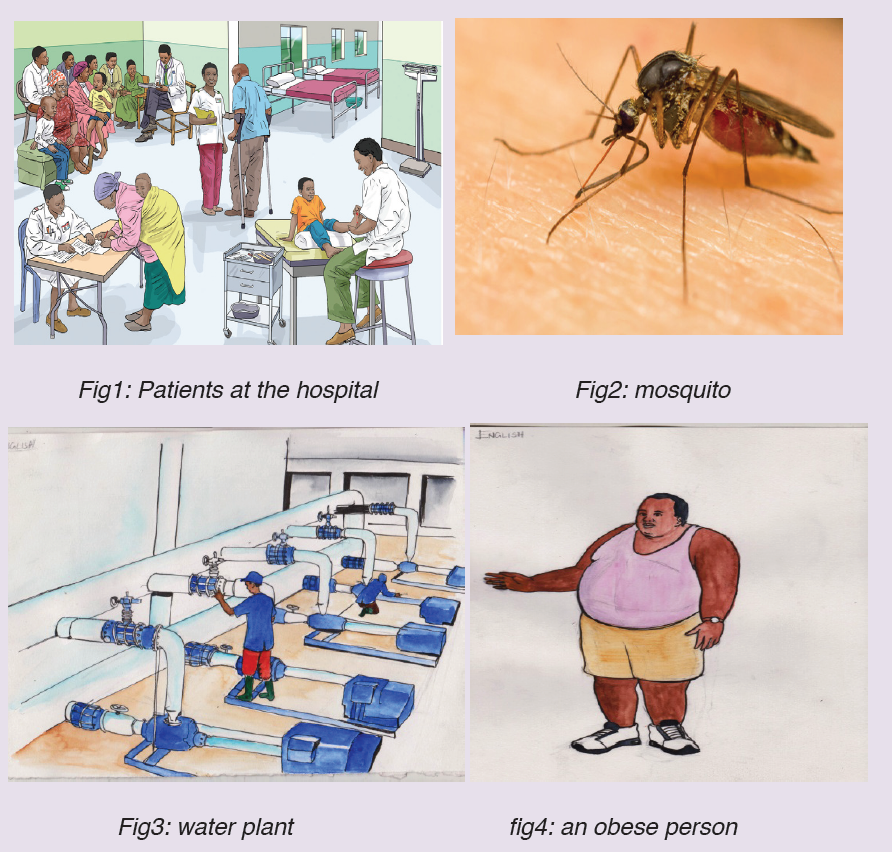
Look at the pictures above answer the questions below:
1. What are the most common illnesses in Rwanda?
2. State at least three communicable diseases.
3. Which sickness can be caused by the insect in fig 2?
4. What do you think is described in fig 3?
5. Mention at least one coronary disease you know.
6. The man in fig4 is very fat. Do you think it is a health related problem? Explain.
5.1. Describing illnesses and diseases and pandemics
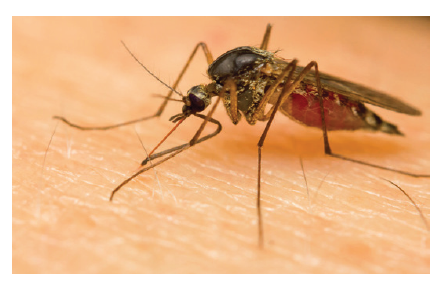
5.1.1. Learning activity: Reading and text analysis
• Text: Types of diseases in Rwanda
There are different types of diseases in Rwanda. Some diseases affect the majority of Rwandans. Others affect only a small number of the population.
The most common diseases in Rwanda today are malaria, HIV/AIDS, tuberculosis, typhoid or typhoid fever. Many Rwandans also suffer from amoebic dysentery, Hepatitis B and C and the common cold.
Some communicable diseases, like typhoid and amoebic dysentery, are waterborne. This means you get these diseases when you drink water that is not clean and boiled. Diseases like tuberculosis and the common cold are airborne. The bacteria or viruses are ejected into the air via coughs or sneezes. When you breathe in this air, you become infected.
Hepatitis B and C and HIV/AIDS are transmitted through body fluids.
Infections and diseases, such as hepatitis are most often carried through the semen and blood of infected persons. Malaria is transmitted through the bite of a female anopheles mosquito. It injects infected blood into your body when it bites you.
Communicable diseases are caused by causative agents. Typhoid, amoebic dysentery and tuberculosis are caused by bacteria. Hepatitis B and C, HIV/AIDS and the common cold are caused by viruses. Malaria is caused by a parasite called plasmodia.
Other diseases are sometimes referred to as lifestyle diseases. These are steadily increasing in Rwanda. The best examples are coronary disease, cancer, diabetes, obesity and mental illnesses.
Coronary diseases, diabetes, obesity and mental illnesses can be caused by a combination of genetics and lifestyle. Cancer results from the malfunctioning of body cells. The substances that cause cancer are called carcinogens.
A carcinogen may be a chemical substance, such as certain molecules in tobacco smoke. The cause of cancer may be environmental agents, viral or genetic factors. We should bear in mind, though, that in the majority of cancer cases we cannot attribute the disease to a single cause.
• Comprehension questions
1. List three of the most common diseases in Rwanda.
2. What are communicable diseases?
3. What is a ‘causative agent’?
4. What causes malaria?
5. How can you avoid getting typhoid fever or amoebic dysentery?
6. How can you avoid getting Hepatitis B or C and HIV/AIDS?
7. Which diseases are steadily increasing in Rwanda?
8. Name two lifestyle diseases.
9. What is meant by ‘lifestyle diseases’?
10. What disease is caused by body cells that malfunction?
• Vocabulary activities:
1. Use the dictionary and thesaurus to look up the missing meanings of the words/phrases in the table below. Copy the table into your book and fill in the blank spaces.

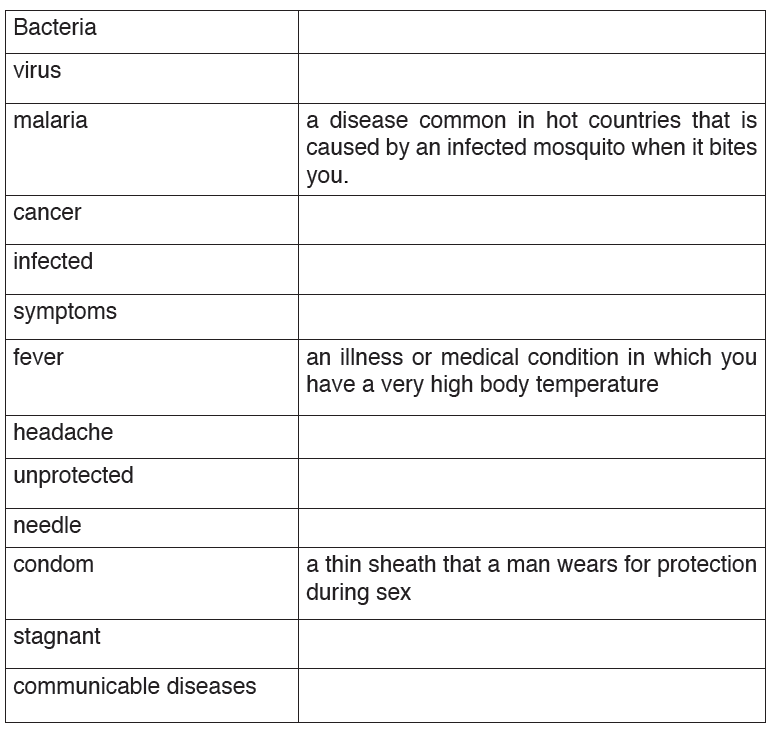
2. Write one sentence for each word/phrase to illustrate how they are used.
5.1.2 Application activities
1. Write a paragraph explaining what communicable diseases are and how they can be prevented.
• Notes
• A paragraph is normally a body of sentences developing one main point. Thus, each sentence of the paragraph should explain more on the main point. They shouldn’t raise a different point.
• Every paragraph should have a topic sentence. A topic sentence gives the main idea of a paragraph. It usually occurs as the first
sentence of the paragraph.
• Every sentence in a paragraph must be grammatically correct.
• After explanatory sentences which give details about the main topic, there is always need to have a closing sentence. This should sum up the topic in the paragraph.
• A good paragraph must focus on the main idea, presented logically and should have a sense of coherence and completeness.
2. Debate on the following motion:
Schools should conduct mandatory HIV testing on their students.
• Definition of debate
A debate is a structured contest in form of oral arguments about an issue or a topic. A formal debate involves two teams expressing their arguments on the topic. Normally, there is a team which proposes or argues in support of the topic while the second team is on the opposition side. Each team consists of two or more main speakers.
• The rules of debate
The debate is always governed by a number of rules as explained below:
• Each team is expected to advance two or three arguments, and two to three rebuttal speeches. The proposing team gives its argument first, followed by the rebuttals from the opposing team. There is always a winding up speech or summarized argument by a selected member of each team.
• The first speaker on each side is supposed to define the key words or terms of the motion as the basis of advancing his or her points.
• If the opposing side challenges the correctness of a definition advanced by the proposer, the opposing team provides its view on the matter.
• Each team of the class debate must advocate or argue in support of his or her view on the topic.
• In order to establish an assertion, a team must support its arguments with enough evidence and logic to convince the judges. Facts must be accurate. Visual materials are permissible to convince the judges.
• In case of a query, the question should be clear and relevant to the motion of the debate.
• As a matter of procedure, each speaker is expected to respond to questions as soon as he or she concludes his or her presentation speech. The speaker concerned may respond to the question personally, although any other member of his or her team can come in to assist.
• If anyone, whether in the audience or among the main speakers, feels unconvinced by a speaker’s argument, he or she is at liberty to interrupt the speaker by raising a point of information. However, the chairman of the debate is also at liberty to either permit or object to the point of interruption.
• The decision about the winning side will be entirely based on the arguments made and points awarded by a team of juries or judges.
Adapted from George H.W. Wilson (1957) Competitive Debate: Rules and Techniques, New York: McCoy Musgravehttp://homepage.ntu.edu.tw/~karchung/debate1.htm retrieved on September 5th, 2019
• Important prerequisites and tasks for debate
Team members should:
• Research on the topic and prepare logical arguments.
• Gather supporting evidence and examples to back their arguments.
• Anticipate counter arguments and prepare rebuttals or responses.
• Plan the order and ideas or points with which to argue and support their points of view.
5.2 Talking about sanitation and related tools
5.2.1 Learning activity: Reading and text analysis
Read the text below and answer the questions that below:
• Text 1: Water and sanitation are human rights.
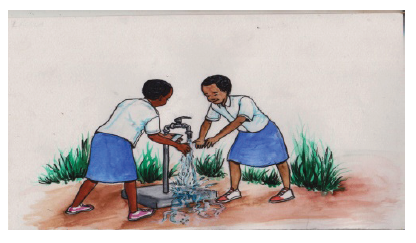
Sanitation refers to conditions relating to public health, especially the provision of clean drinking water and adequate sewage disposal. Universal access to safe water, sanitation and hygiene services are priorities in Rwanda.
Washing hands is critically linked to improved nutrition, good health, gender equality, economic growth, and environmental management.
Poor sanitary conditions causes diarrhea and intestinal parasites and environmental enteropathy and have complex and reciprocal links to malnutrition in children. Existing evidence demonstrates that poor sanitation and hygiene conditions can affect a child’s nutritional status via at least three direct pathways (i) diarrheal diseases; (ii) intestinal parasites; and (iii)
environmental enteropathy. Malnutrition weakens the body’s defenses and makes children more vulnerable to diseases. At the same time, diarrhea and intestinal parasites contribute to malnutrition by causing decreased food intake, impaired nutrient absorption and direct nutrient losses.
In Rwanda, only 57 per cent of the population access safe drinking water that is within 30 minutes of their home. When children are forced to spend time collecting water, it keeps them out of school. This is an issue especially for girls, who are often expected to take on the majority of household tasks.
Even if water is available near the home, that water is often not safe to drink.
When children drink contaminated water, they risk severe illness and even death from water bone diseases.
Basic sanitation means that every household has its own toilet and does not share with another household. These toilets should also keep human waste out of contact with people. Only 64 per cent of the population in Rwanda have access to these sanitation services.
Just 5 per cent of households in Rwanda have a place for family members to wash their hands with soap. Hand washing with soap at critical moments is essential for good health, especially in children.
As a solution UNICEF’s WASH program in Rwanda aims to ensure that more households and communities use safe and sustainable water and sanitation services, and that children and families practice good hygiene.
UNICEF supports the Government of Rwanda to ensure that every household:
Uses safe and clean water near the home, a hygienic and private latrine and practices hand washing with soap, especially after using the toilet and before handling food.
Adapted from https://www.unicef.org/rwanda/water-sanitation-and-hygiene
• Comprehension questions
1. How do you think hand washing can be linked to improved nutrition?
2. Explain the consequences of using dirty water.
3. Which consequences school children who don’t have water near their home are likely to face?
4. What does “basic sanitation” mean?
5. What are the critical moments of washing hands?
5.2.2 Application activities Word and sentence formation
• Vocabulary activities
1. Give the meaning of the following words as used in the above passage.
a. …hygiene… (paragraph one)
b. … enteropathy… (paragraph two)
c. …malnutrition… (paragraph two)
d. …nutrient… (paragraph two)
e. …contaminated water… (paragraph four)
f. …latrine… (paragraph seven)
2. Write one sentence for each of the words above to illustrate how they are used.
5.2 Language structure: Conditionals
Notes:
Conditionals are sometimes called ‘if clauses’. They describe the result of something that might happen (in the present or future) or might have happened but didn’t (in the past). They are made using different English verb tenses. There are four main kinds of conditionals: The zero, first, second and third conditional
1. Zero conditional
(if + present simple, ... present simple)
Example: If you heat water to 100 degrees, it boils.
This conditional is used when the result will always happen. So, if water reaches 100 degrees, it always boils. It’s a fact.
Here are more examples:
• If children drink dirty water, they get sick.
• If you touch on fire, you get burnt
• If bacteria get into the body, they cause infection.
2. The first conditional
(if + present simple, ... will + infinitive)
Example: If you don’t wash your hands properly you will fall sick.
The first conditional is used to talk about things which might happen in the future. Of course, we can’t know what will happen in the future, but this describes possible things, which could easily come true.
Here are more examples:
• If it rains, I won’t go to the park.
• If I study today, I’ll go to the party tonight.
• If I have enough money, I’ll buy some new shoes.
• She’ll be late if the train is delayed.
• She’ll miss the bus if she doesn’t leave soon.
• If I see her, I’ll tell her.
3. The second conditional
(if + past simple, ... would + infinitive)
Example: If my hands were clean, I would test this food.
In formal writing ‘were’ is used instead of ‘was’ with ‘I’ and ‘he/she/it’.
The second conditional has two uses:
First, we can use it to talk about things in the future that are probably not going to be true. If one is imagining some dream for example.
• If I won the lottery, I would buy a big house. (I probably won›t win the lottery)
• If I met the Queen of England, I would say hello.
• She would travel all over the world if she were rich.
• She would pass the exam if she ever studied. (She never studies, so this won’t happen)
Second, we can use it to talk about something in the present which is impossible, because it’s not true. Have a look at the following examples:
• If I had his number, I would call him. (I don’t have his number now, so it’s impossible for me to call him).
• If I were you, I wouldn’t go out with that man.
4.The third conditional
(if + past perfect, ... would + have + past participle)
Example: If they had taken Kalisa to hospital on time he would not have died.
The third conditional talks about the past. It’s used to describe a situation that didn’t happen, and to imagine the result of this situation.
• If she had studied, she would have passed the exam (but, really we know she didn’t study and so she didn’t pass)
• If I hadn’t eaten so much, I wouldn’t have felt sick (but I did eat a lot, and so I did feel sick).
• If we had taken a taxi, we wouldn’t have missed the plane
• She wouldn’t have been tired if she had gone to bed earlier
• She would have become a teacher if she had gone to university
• He would have been on time for the interview if he had left the house at nine
Exercises
Complete the Conditional Sentences using the correct form of verbs in
brackets. Decide whether to use first, second or third conditional.
1. If I had time, I…………shopping with you. (go)
2. If you…………English, you will get along with them perfectly.(speak)
3. If they had gone for a walk, they……………the lights off. (turn)
4. If she……………….to see us, we will go to the zoo. (come)
5. I would have told you, if I………………him. (see)
6. Would you mind if I………………….the window? (open)
7. If they………………me, I wouldn’t have said no. (invite)
8. My friend……………...me at the station if he gets the afternoon off. (meet)
9. If I………………….it, nobody would do it. (do)
10. If my father……………….me up, I’ll take the bus home. (pick)
5.3 Spelling and pronunciation
Use a dictionary and thesaurus to look up the missing pronunciation of the words/phrases in the table below. Copy the table into your book and fill in the blank spaces and practise reading them.
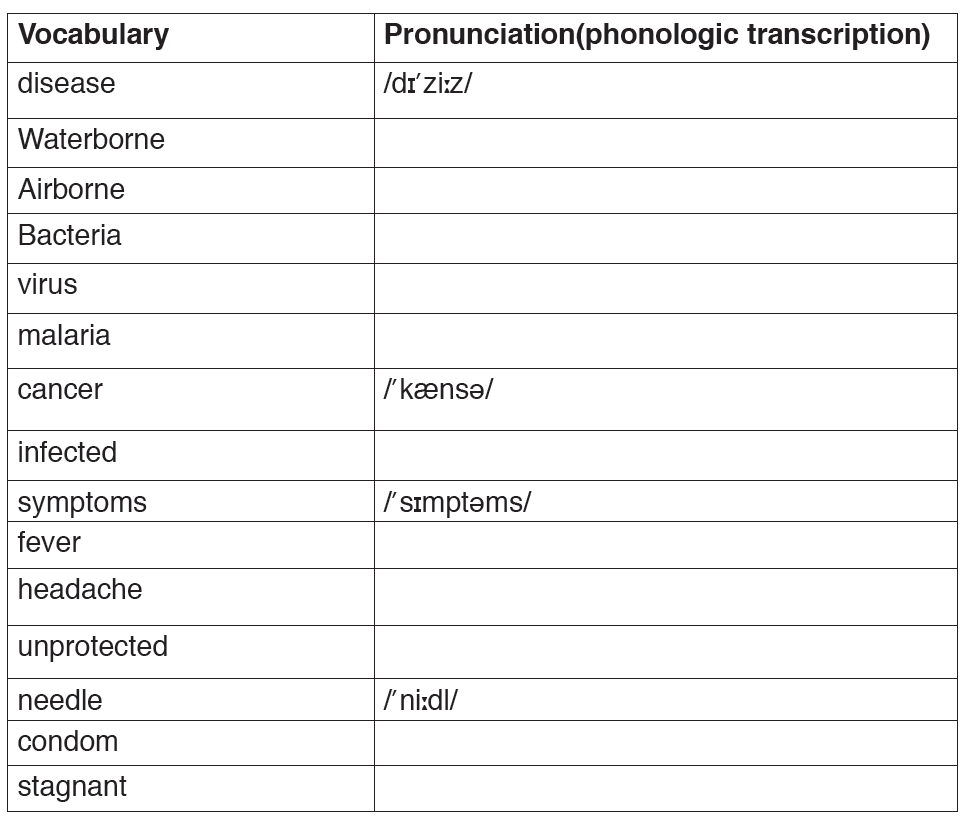
5.4 End unit assessment
i. Complete the Conditional Sentences using the correct form of verbs in brackets.
1. If we meet at 9:30, we……….plenty of time. (have)
2. Lisa would find the milk if she……….in the fridge. (look)
3. The zookeeper would have punished her with a fine if she…………the animals.(feed)
4. If you spoke louder, your classmates………………you.
(understand)
5. Dan…………safe if he drove slowly. (arrive)
6. You…………….no trouble at school if you had done your homework. (have)
7. If you………………in this lake, you’ll shiver from cold. (swim)
8. The door will unlock if you………………the green button. (press)
9. If Keza…………….her teacher, he’d have answered her questions. (ask)
10. I……………the office if I were you. (call)
ii. Choose the right word to fill in blanks in the following paragraph
Hepatitis B and C and HIV/AIDS are transmitted through body………(muscles/fluids). Infections and diseases, such as hepatitis are most often carried through the semen and blood of……………(infected/healthy) persons. Malaria is transmitted through the ………. (excrement/bite) of a female anopheles………… (fly/mosquito). It injects infected …….…(blood/semen) into your body when it bites you.
iii. Write a 200 word composition on a person you saw who got a communicable disease and use conditional sentences to explain what they would have done to avoid that communicable disease.
UNIT 6: CULTURAL HERITAGE
Key Unit competence: To use a language learnt in the context of cultural heritage
Introductory Activity
Introductory activity:
“ Losing the language means losing the culture. We need to know who
we are because it makes a difference in who our children are.”
By Dottie Le Beau.
In your own words, explain what you understand by the term culture?
Is it important to involve the community in the preservation of culture or it should be a personal initiative?
6.1. Talking about the role of language in culture
5.1.1. Learning activity: Reading and text analysis
Text 1: A poem
Read the poem below and answer questions that follow.
I lost my talk
I lost my talk
The talk you took away.
When I was a little girl
At Shubenacadie school.
You snatched it away:
I speak like you
I think like you
I create like you
The scrambled ballad, about my world.
Two ways I talk
Both ways I say,
Your way is more powerful.
So gently I offer my hand and ask,
Let me find my talk
So I can teach you about me.
Rita Joe
• Comprehension questions
1. The poem above is about culture. Is the poet happy with her culture being eroded or no? Explain your answer.
2. Analyze stanza 4 and explain why the poet is not impressed about her dissolving culture.
3. What does the poet mean when she says” the scrambled ballad about the world”?
4. Which is your favourite stanza from the poem and explain why you like it.
Text 2: Nyamalo hates school
Read the extract of the story below and then, discuss its cultural setting.
That was the end of school for Nyamalo. My father brought her home that weekend. The situation was explained to her and I saw a flood of tears run down her sweet cheeks. She screamed, sobbed and writhed painfully on the floor. “I am not going,” she said. “I am not going.” My mother also shed a tear. I don’t know why Mother shed a tear when she had accepted a blanket, drank beer and smiled when Father was given money. “You will go, my daughter. You are not your own daughter,” Father said resolutely.
“I’m not going,” Nyamalo insisted. “What wrong have I done to you? Mother!
Mother! Why do you forsake me?” Mother shed more tears and only said between sobs. “It … is … finished …” Two days later the bride was prepared for the ceremonial departure from her parents’ home. She was dressed in a loincloth, a lesso which went under her right arm and was knotted above her left shoulder. A beaded belt went around her waist. Around her neck she wore
several strings of beads and one beaded ornament whose bead suspension flowed down to her knees. Her feet were shod in green rubber shoes. On her back she carried a gourd full of milk. A real bride! The bridegroom’s father and mother came to escort her. My father, mother and clan all anointed her with milk cream. They told her to multiply like a pumpkin. May her children fill the world? But they also reminded her that she was now somebody’s wife.
She must live like one. That would bring great honour not only to herself but to all her people. I was asked to accompany her and to stay with her for two weeks to keep her company. We walked in a single file. My sister’s fatherin-law walked ahead, followed by his wife, followed by Nyamalo and, lastly myself. Although customarily the bride was required to promenade along, she defiantly walked clumsily and fast. I heard my father say from behind me when we started off, “This girl will bring us shame.”
(Adapted from They Sold My Sister by Leteipa ole Sunkuli)
Comprehension questions
1. Provide your own title for the above passage.
2. What shows that Nyamalo is a bride?
3. What are some of the cultural practices mentioned in the text?
4. Discuss the similarities and differences between the culture depicted in the above and the Rwanda culture.
6.1.2 Application activities
Discuss the importance of language in the promotion of culture
In pairs, write down a dialogue about your experience when you visited a national heritage (National park, forest reserve, genocide memorial site, museum etc.) and perform the dialogue for the rest of the class.
6.2 Talking about the importance of cultural preservation and national cultural heritage
6.2.1. Learning activity: Reading and text analysis
Text: An article
Read the article below and answer questions that follow:
There is need for more community involvement in preservation of natural and cultural heritage, experts have said.
This was during a workshop on nature and culture conservation organized by the Institute of National Museums of Rwanda in collaboration with the Yale University, Victoria and Albert Museum, and the Museum für Naturkunde Berlin, held at the environment museum in Karongi District on Tuesday.
During the workshop, participants discussed ways to raise both public and political awareness and encourage specific actions to conserve cultural and natural heritage.
It was noted that there is an increase in cultural heritage loss which is caused by criminal acts such as destruction of sites, socio-economic development projects, influence of western cultures, scarcity of resources allocated to cultural heritage conservation, among others.
The experts called for use of latest technologies, such as social media, to promote the preservation of nature, and more involvement of communities to ensure heritage such as songs, poems, fictions are well preserved.
Isidore Ndikumana, acting Director General, Rwanda Museums, called on Rwandans to treasure and protect nature and culture heritage.
“Some people think heritage sites are for foreign tourists. That’s not true; they should understand that the heritage is theirs. Conservation should start at the local level,” he said.
According to Stefan Simon, Director of the Institute for the Preservation of Cultural Heritage, Yale University in the US, cultural heritage is “the root of our identity; it determines who we are and how we live”.
“I have learnt a lot about cultural heritage of Rwanda and Africa, how it links with nature and how it is important to always make sure that residents are profiting from their cultural heritage,” he said.
Johannes Vogel, the director of Museum für Naturkunde, Berlin, said the meeting was an opportunity to learn from others’ experiences.
“Rwanda has made major efforts to address the issues of conservation of nature and culture, creating institutions and political interests and the will to pursue this. People learn new ways of living together, bring different perspectives, culture, ideas together for a more harmonious and forward looking society. We are keen to share and learn from that experience.
European conservation institutions are more advanced. There are practices, ideas, technologies that we are willing to share,” he said.
During the workshop, the Institute of National Museums of Rwanda shared local and regional potentials and challenges in nature and culture conservation.
(Source- The New times, Rwanda posted on 1st September 2016)
• Comprehension questions
1. What is the definition of culture heritage according to the passage?
2. Discuss the importance of national heritage.
3. How, according to the experts can national heritages be preserved
4. Explain the challenges in preserving national heritage.
• Vocabulary activity: Words’ meaning and synonyms
1. Find the meaning of the following words,
a. Perspective
b. Harmonious
c. Potential
d. Scarcity
2. Find the synonyms of the following words:
a. Sobbed
b. Clumsy
c. Ceremonial
d. Customarily
e. Knotted
f. Promenade
g. Writhed painfully
h. Anointed
i. Loincloth
j. Scrambled
6.2.2 Application activities Essay Writting
Imagine that you have been selected as secretary for a meeting that is searching for ways of preserving cultural heritage in Rwanda. Prepare a minute report and present it to the class.
6.3. Traditional school of culture of Rwanda called Itorero.
6.3.1. Learning activity: Reading and text analysis
Picture observation: In pairs, observe the pictures below and describe what you think is taking place.
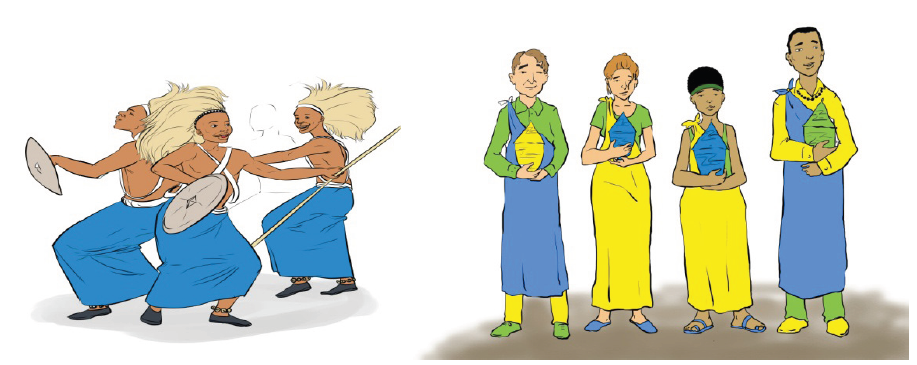
Text: Traditional school of culture of Rwanda
Read the text below and answer questions that follow.
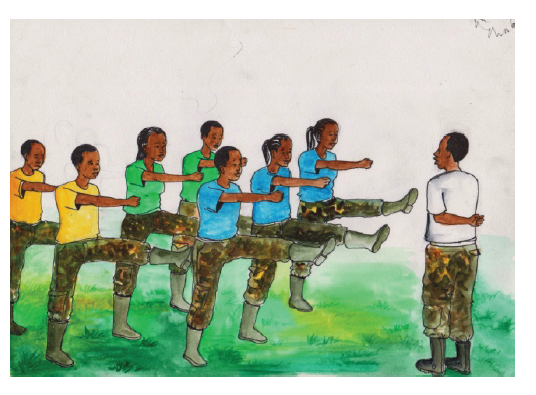
Itorero was started by King GihangaNgomijana. He was the first King of Rwanda. It dates to pre-colonial times and it started with the aim of teaching Rwandans their values. It would promote peace and unity among Rwandans.
It would teach boys above 14 years of age how to hunt, protect their homes when they became men, and to love their country (patriotism). The girls, on the other hand, had urubohero. They would learn how to take care of their husbands in the future, and weave baskets and mats.
With the coming of the Europeans, things changed. Itorero stopped because the Europeans saw that Rwandans had unified because of it. They wanted to divide Rwandans. And it helped them divide Rwandans into Hutu, Tutsi and Twa. They also promoted hatred among Rwandans. In 1962, Rwanda got independence, but ethnic tensions remained. This is what caused the
1994 Genocide against Tutsi.
After the 1994 Genocide against the Tutsi, the Rwandan government brought Itorero back. It was hard to bring back a lost culture, but Rwandans were happy that their traditional school with additional values was back. It also helped promote unity and reconciliation among Rwandans. It helped the youth know their country’s values. Now it is practiced in secondary schools
and across the whole country.
Adapted from the New Times
• Comprehension questions
a. Discuss the significance of itorero to the Rwandan community.
b. Explain the reasons for the reintroduction of Itorero.
c. In your own words, briefly explain the history of itorero in Rwanda.
d. From your own analysis of the community around you, what are some of the observable differences between citizens that have gone through itorero school and those that have not?
6.3.2. Application activity: Writing a narrative text
Write a narrative story about your first experience in the traditional school of culture (itorero). Word limit 100 words
6.4. Language structure: Past simple tense and the verb
“used to”
A. Regular and irregular verbs in past simple tense
(See notes on past simple tense, unit 1)
Examples of past simple tense of regular and irregular verbs
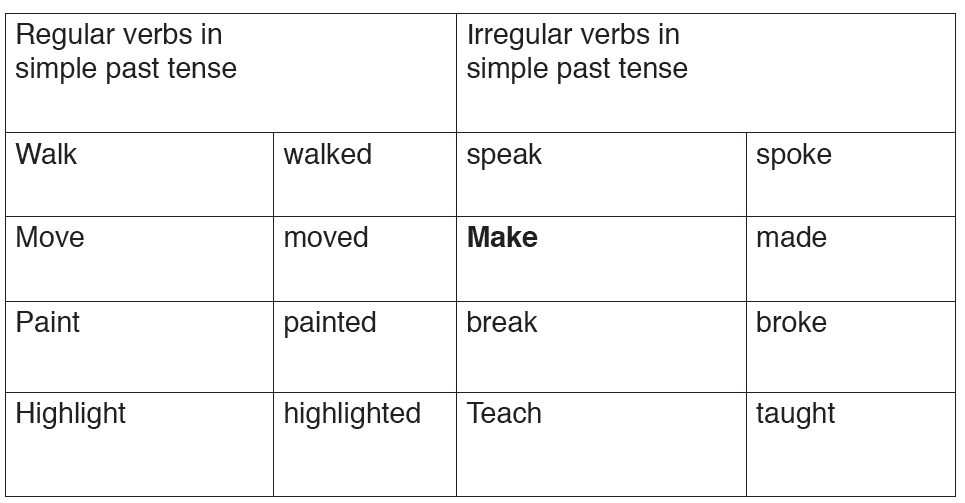
1. Complete the sentences with the verbs below in the past simple
Walk, enjoy, wash, travel, finish, like, study, listen
1. We…………………. her introductory party very much.
2. Uwineza………………….to his favourite traditional song yesterday.
3. My sister………………………. cultural heritage for her research paper.
4. They…………………………to the genocide memorial site last afternoon.
5. My father ……………………his military boots last month.
6. Last weekend, we……………………….to Nyungwe rainforest for two hours.
7. Cyabitondo……………………. her birthday presents.
2. Activity Sentence and questions in past simple tense.
………………the shop keeper………………10 percent of the price? (to take)
We …………….in the flat when we were in Musanze. (to live)
What…………. you……………Yesterday? (to do)
Mahoro ……………………. her room on Thursday. (to tidy)
Why…………… the baby……………. this morning? (to cry)
He……………. magic tricks at the party. (to do)
3. Use verbs in brackets to complete the story. Put these verbs in the past
simple tense and place them in the spaces provided.
On Saturday, the children……………. (talk) about a day out together in the national park.
The next morning, they……………(go) to the park with two dogs that suddenly disappeared.
So, they……………. (call)them and………(take) them back.
Kwizera………………. (be) very happy to see them again. At lunch time, Eric……………. (go) to the bikes
and…………… (bring) the baskets with some fruits. Then they………………. (play) football. Eric and
Claude…………. (win). Later that evening, they happily……………………(ride) back home.
B. Using “used to” and “to be used to” in sentences
• Notes
“To be used to” is used to talk about things which feel normal for us or those things that we are accustomed to or those things that become a habit to us.
‘Used to +verb-ing’:
Example: Jacky is used to getting up early, so she doesn’t mind doing it.
The above sentence means that, getting up early for Jacky is normal and has become part of her.
“To be used to” can be used when talking about things in the present, past or future as seen in the examples below:
1. Present
• Jane is used to washing her own clothes.
2. Past
• It was difficult when I first started college because I was not used to the amount of work we had to do.
3. Future
• Soon, I will be used to driving in Kigali and I won’t be frightened!
“To be used to” can also be modified into ‘get used’ to. That is, get used
to+Verb -ing. Especially when talking about a change of not normal to normal.
It could be used in any tense as observed in the examples below;
• It took me a few months to get used to living in Kenya. At first everything seemed very different but then gradually, it became normal for me.
• It took me a while, but I got used to speaking another language every day.
“To be used to” expresses actions which were habits in the past but no longer take place.
Example: 1. I used to work as a nurse but I am now a full doctor.
2. He used to jock with me. He is now a grown man. He has become serious.
Exercises
I. Read the sentences and decide whether the form is correct or not
1. Every day now I uses to ride my bicycle to school.
a. Correct
b. Wrong
2 They are not used to drinking alcohol.
a. Correct
b. Wrong
3 We used to go everywhere together. Now, he does not even
speak to me.
a. Correct
b. Wrong
4 She didn’t used to smoke but now, she is able to complete a
packet of cigar.
a. Correct
b. wrong.
5. We used to have dolls when we were young.
a. Correct
b. Wrong
6. They used to live in Nyagatare.
a. correct
b. wrong
7. Stella is used to praying every day.
a. Correct
b. Wrong
8. They are used to parking their cars in the washing bay.
a. correct
b. wrong
9. Francine got using to fly the plane from Kigali international airport to Beijing.
a. Correct
b. Wrong
10. He got used to living a solitary life after all his family perished in a nasty car accident.
a. Correct
b. Wrong
II. Match the beginnings of the sentences to the correct endings as seen in the table below:
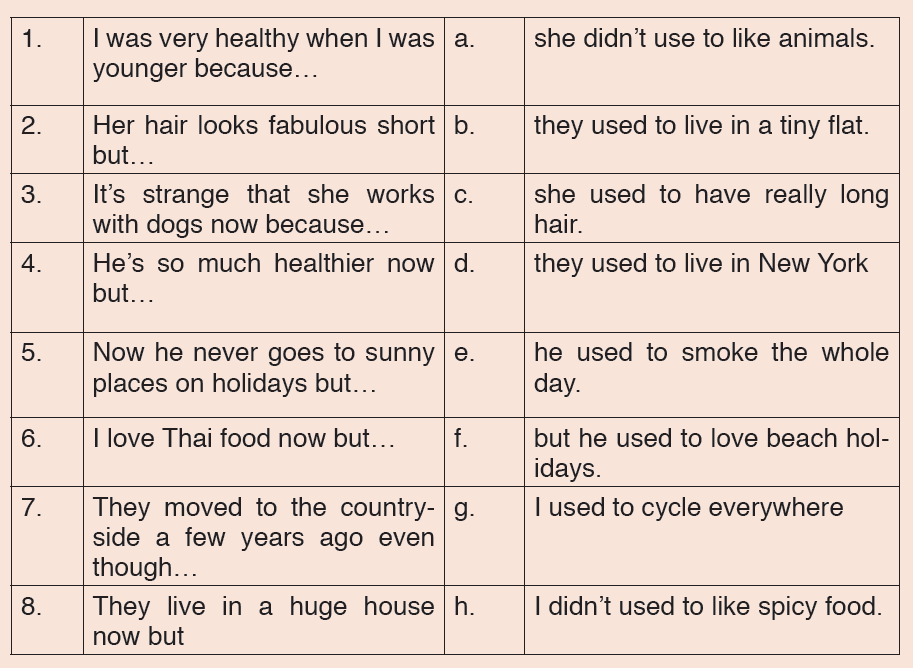
III. Construct 12 grammatically well-structured sentences using used to and got used to.
6.5 End unit assessment
1. Imagine that you have been called for an interview in a famous radio station in Kigali, in pairs prepare for an interview guide and responses about ways on how to preserve the Rwandan culture and after, present it to the class.
2. Construct your own sentences using the following words:
Swaying………………………………………………………
Launching……………………………………………………
Elegance………………………………………………………
Heritage………………………………………………………
Sunny…………………………………………………………
Fabulous………………………………………………………
Rhythm…………………………………………………………
Cheer……………………………………………………………
Dolls……………………………………………………………
Quacking………………………………………………………
3. Put the verbs into the correct form (simple past).
I ……………………………….my holiday in Ireland. (spend)
It …………………………great. (be)
I ………………………around by car with two friends and we
visited lots of interesting places. (travel)
In the evenings we usual…………………….to the markets. (go)
One night we even…………………some ikinyarwanda dances.
(learn)
But we……………………….some beautiful rainbows.(see)
She………………ill in the class and the teacher let her go home.
(feel)
4. Tick the correct answer in the exercise below I hadn’t enough money to pay the concert tickets.
Did you know that Keza was my sister?
We had a noise in the middle of the night.
My parents wasn’t very happy with my exam result.
The teacher told the students to sit down.
They never didn’t receive the money that they needed.
She didn’t ate her breakfast this morning.
She didn’t bought the bread yesterday.
UNIT 7: ENVIRONMENT CONSERVATION AND SUSTAINABILITY
Key Unit competence: To use language learnt in the context of Environment Conservation and
Sustainability
Introductory Activity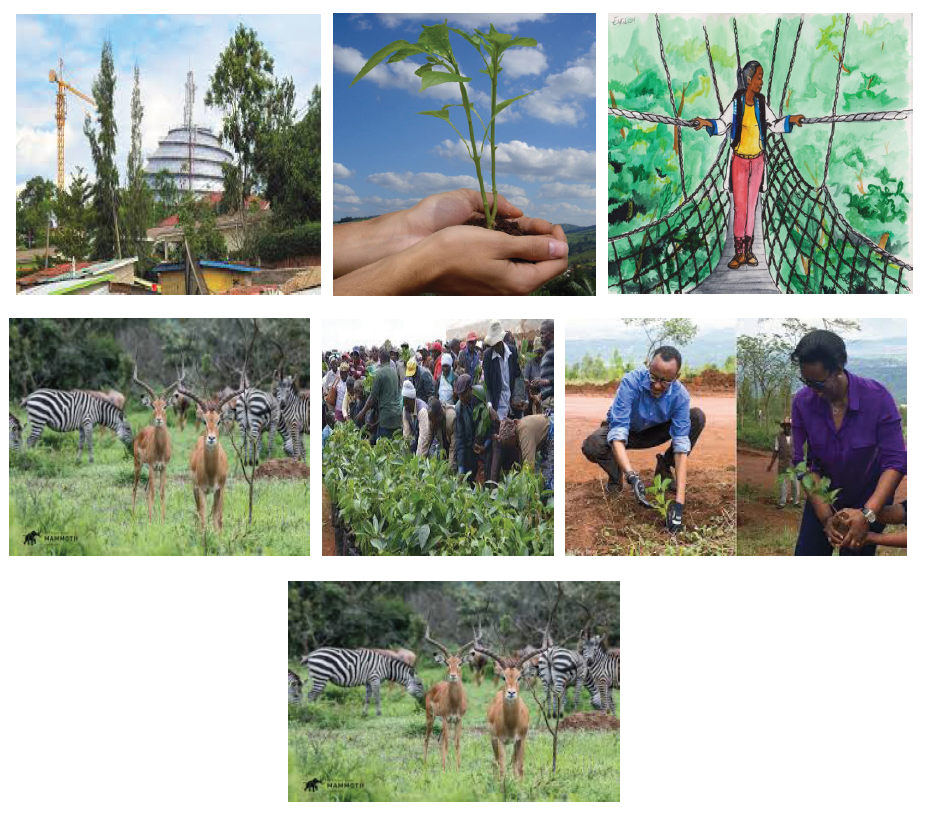
After observing the above pictures, answer the following questions:
1. What is environment conservation?
2. Who is responsible to conserve and sustain our environment?
3. Why do we need to protect and sustain our environment?
4. Which techniques can we use to protect and sustain our environment?
7.1. Describing different ways of protecting environment
7.1.1. Learning activity Reading and text analysis
7.1.1.1. Picture observation and interpretation
Observe the pictures and interpret what is happening from Figure1-3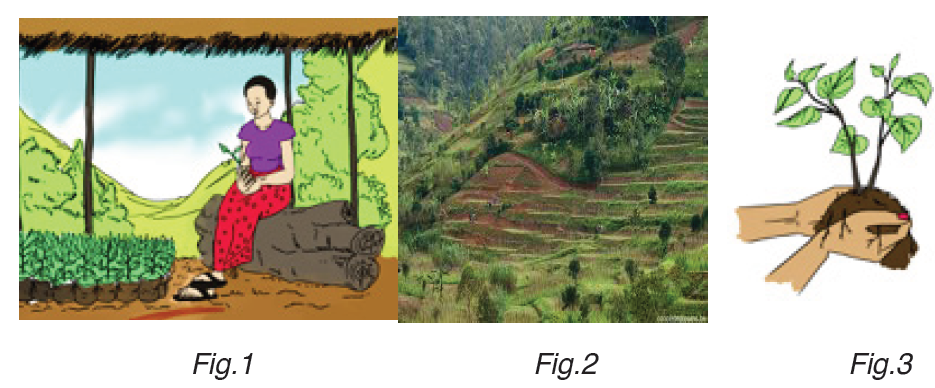
Identify different activities that are taking place in the above figures and explain their advantages.
• Text: Safe environment is a source of healthy living.
We only have one planet and we should all do our part to ensure that it’s protected by combining our modern ways of living with a deeper respect and understanding of what nature provides. Environmental conservationists understand that the way we live is a reflection of how we feel about the natural world, and our everyday habits show how much we truly value all the things that the Earth gives us. There is much to do when it comes to rebuilding and protecting what’s left of natural resources and the biodiversity within our ecosystems. Environmental conservation is an umbrella term that defines anything we do to protect our planet and conserve its natural resources so that every living thing can have an improved quality of life. Conservation works in two ways. It is meant to protect nature by protecting vital resources, and it is also a way of living that works against the irresponsible practices.
Environmental conservation comes in many forms and reminds us to be mindful of daily choices. No matter how busy your life may be, it remains fairly easy to make small, yet necessary, changes for the good of the Earth.
If we all took little steps, we would make our way towards major progress.
This can be achieved by paying more attention to what we buy and not using resources unnecessarily. We must also remember to recycle and dispose of chemicals properly so that the ground and bodies of water are not poisoned.
By embracing and promoting alternative energy sources, Mother Earth would be relieved. If every household incorporated the concepts of sustainable living by using less and conserving more, the positive impact would be immeasurable. Then, Environmental awareness and care for our immediate surroundings is cultivated in families and by cultural values before it is learned in formal educational settings such as schools and universities, or in other social settings oriented to bringing attention to environmental issues, such as groups that advocate for protecting nature. Thus, environmental education “includes the provision of information in a systematic and structured way, but usually goes further, encouraging deeper understanding and, perhaps, values and norms regarding behaviours” (Dietz & Stern, 2002) (Box 4).
Deforestation continues to be a major environmental issue. Trees are cut down to provide fuel for cooking, charcoal and more land. Trees are the ‘lungs’ of the earth, absorbing carbon dioxide and releasing oxygen. Their roots also lock moisture in the soil. Without trees, we will experience erosion and a build-up of carbon dioxide. Again, Animals and people lose their food supply and homes, and the economic status of a region can also change because less forests often leads to less employment opportunities in the area.
Planting trees is a way to give back because it aids in the restoration of homes for wildlife, food sources, and medicinal properties that only the trees provide. As trees grow, they protect soil from harsh weather conditions and protect us from excess carbon dioxide, enabling us to live longer and more comfortably. So, when trees are cut down, they must be replaced. But trees
take a long time to grow. We must control the removal of trees to prevent deforestation. Farmers are encouraged to practice agro forestry where they plant trees on their farms together with the crops and making terraces especially on high mountains. The government and many large corporations play a big part in how we make use of the Earth’s resources, but they aren’t the only ones who determine the impact we have on the planet. With so many of us on this Earth, we can make all the difference in the world hence healthy living.
• Comprehension questions.
a. What is environment protection?
b. What does the author mean by trees being the ‘lungs’ of the earth?
c. Why do people cut down trees?
d. How can deforestation be prevented?
e. Give reasons why the author said that safe environment is source of living.
f. Explain some of the ways of protecting environment.
• Vocabulary activity
Explain the following words using your dictionaries
1. Terraces
2. Conservation
3. Agro-forestry
4. Deforestation
5. Carbon dioxide
7.1.2. Application activity Essay writing
Write an essay of about one page on the topic of pollution and exploitation of Environment. You can include in your essay statements such as:
• We cut down too many trees, and therefore...
• We put too much waste into rivers, and therefore...
• We make too many fires, and therefore...
• We build too few terraces, and therefore...
7.2. Describing environmental features and their roles
7.2.1. Learning activity Reading and text analysis
Picture observation and interpretation
Observe the picture and answer questions that follow: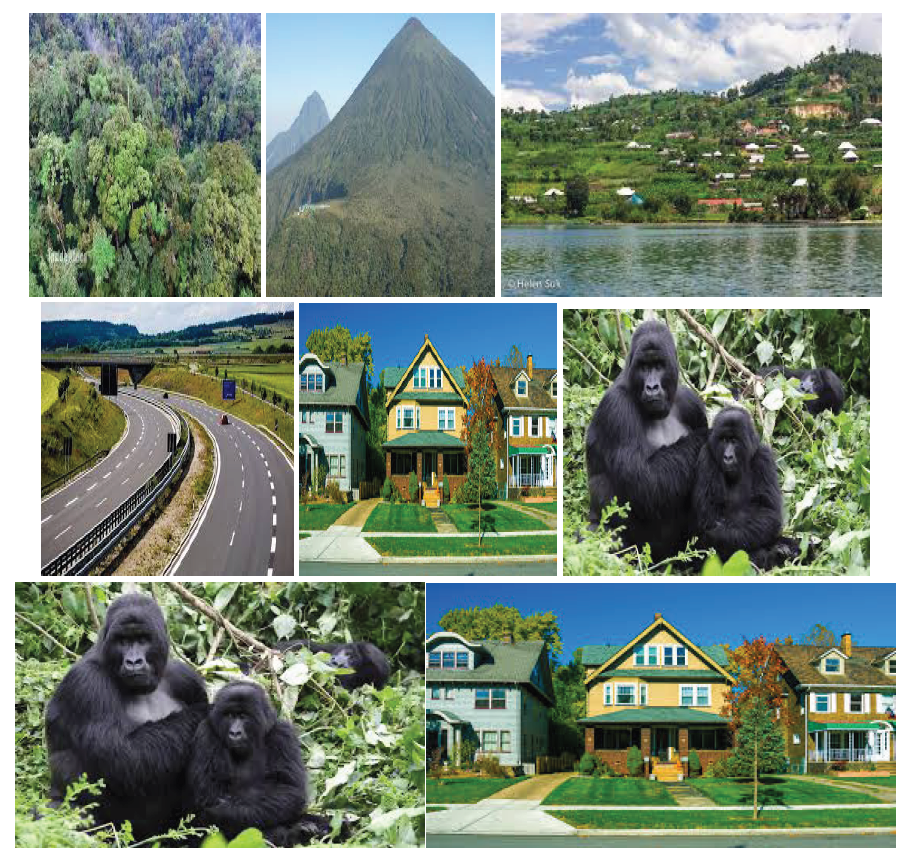
Explain what the above picture represents.
• Text: Know your country.
Read the following text and answer the questions below:
Our country is known as the “land of a thousand hills,” it is a mountainous country located on the far western edge of the Rift Valley, bordering on Burundi, the Democratic Republic of Congo, Uganda, and Tanzania. Rwanda rises from relatively flat plains in the east along the Tanzania border to steep mountains in the west along the continental divide between the Congo and Nile rivers. From the continental divide, the land drops sharply to the shores of Lake Kivu, which forms most of Rwanda’s border with Congo. A range of high volcanoes forms Rwanda’s northwest border. The mountainous topography continues in the North Kivu region of Congo, where almost half of the population identifies as Rwandan.
Rwanda is a landlocked country, a member of East Africa situated in central Africa. It has five volcanoes, 23 lakes and numerous rivers, some forming the source of the River Nile. The country lies 75 miles south of the equator in the Tropic of Capricorn, 880 miles ’as the crow flies’ west of the Indian Ocean and 1,250 miles east of the Atlantic Ocean - literally in the heart of Africa.
Rwanda is bordered by Uganda to the north, Tanzania to the east, Burundi to the south and the Democratic Republic of Congo to the west. So, anyone visiting ’The Land of a Thousand Hills’ is in for a multitude of surprises. The loveliness and variety of the landscapes in this ’green country’ is dominated to the north by volcanoes and bordered by Lake Kivu to the west.
We cannot forget the great animals of the wild are protected from poachers and roam free in the vast national parks. The Volcanoes National Park in the Virunga volcanic mountains with its high altitude forests is world famous for mountain gorillas - timid and passive family oriented giants. The Park is teeming with wildlife both large and small, while Lake Kivu to the west offers beautiful beaches, jutting peninsulas and an archipelago of islands.
In addition, the watershed between the major Congo and Nile drainage basins runs from north to south through Rwanda, with around 80 percent of the country›s area draining into the Nile and 20 percent into the Congo via the Rusizi River. The country›s longest river is the Nyabarongo, which rises in the south-west, flows north, east, and southeast before merging with the Akanyaru to form the Akagera; the Akagera then flows due north along the eastern border with Tanzania. The Nyabarongo-Akagera eventually drains into Lake Victoria, and its source in Nyungwe Forest is a contender for the as-yet undetermined overall source of the Nile.
Rwanda has many lakes, the largest being Lake Kivu. This lake occupies the floor of the Albertine Rift along most of the length of Rwanda›s western border, and with a maximum depth of 480 metres (1,575 ft), it is one of the twenty deepest lakes in the world. Other sizeable lakes include Burera, Ruhondo, Muhazi, Rweru, and Ihema, the last being the largest of a string of lakes in the eastern plains of Akagera National Park.
And for Mountains, they dominate central and western Rwanda also part of the Albertine Rift Mountains that flank the Albertine branch of the East African Rift. This branch runs from north to south along Rwanda’s western border. The highest peaks are found in the Virunga volcano chain in the northwest; this includes Mount Karisimbi, Rwanda’s highest point, at 4,507 metres (14,787 ft).
Finally, as long as our physical environment is concerned, it supports all life forms. Rocks, soils, minerals, air, water, microbes, fungi, plants and animals work together to support life and its ability to provide all the other benefits– provisioning, regulating and cultural. The capacity of the environment to support all of this depends on trillions of physical, chemical and biological
interactions. Our understanding of these is just beginning to unravel how sensitive some systems are, and how resilient others can be.
• Comprehension questions
1. What is the role of the following features:
a. Forests b. Lakes
2. Why do we call our country the land of a thousand hills?
3. Identify the lakes discussed by the author.
4. Give reasons why our physical features need to be protected.
5. Suggest some pieces of advice to people who destroy always our physical features.
7.2.2. Application activity Composition writing
Write a composition describing physical features found in the region of Virunga park.
7.3. Talking about physical environment
7.3.1. Learning activity Reading and text analysis
• Text: Our physical environment
Read the following text and answer the questions that follow:
Some people are healthier than others because the environments in which they live, learn, work and play provide more opportunities and supports for healthy behaviour. A healthy environment begins with clean, safe water, air and land we are fortunate that there is little pollution and few contaminants in the country. Our ability to interact with nature on a daily basis gives us a clear advantage over most other people. The natural environment and our connections to the land, water, animals and plants are a fundamental component of building and sustaining good health.
In the past, people travelled by foot, and survived by hunting, gathering and growing their own food. Our ancestors were close to the land and experienced the many benefits of nature. Physical activity was not exercise, it was part of daily life.
Today, we must pay attention to how buildings, roads and walkways, and public spaces are designed so that neighbourhoods are safe and people can be active. Communities that are spread out like Whitehorse can make us more reliant on cars to get around. It’s easy to see how being physically active becomes “working out” rather than part of regular daily activities.
Stores that stock healthy foods and restaurants that serve healthy foods at affordable prices are also examples of physical environments which make healthy choices possible and easier. When it comes to activity and eating, even small changes in the immediate environment can make a difference in what we do. Safe, visible stairwells make it easier to take the stairs rather
than the elevator, and labelling healthier choices at restaurants can prompt us to order a salad instead of other meals.
Adapted from S2 English text book, unit 6 and from www.yukonwellness.ca
• Comprehension questions
Why some people get healthier than others?
Explain the importance of environment as discussed by the author.
Compare and contrast the exploitation of environment in the past and today.
Which advice would you give to people who do not do physical sports?
7.3.2. Application activity Debate and Composition writing
1. Conduct a debate on the following topic. Find the guidelines in unit 5 of this book. ‘Technology has brought more harm to the
environment than good.”
2. Write a composition about the following topic. Find the guidelines in unit 5 of this book. “Without safe environment, people’s
activities are meaningless.”
7.4. Language structure: expressions of purpose
1. Identify the phrases used for expressing the purpose of actions in the following extracts:
a. There are a number of different actions that environmentalist can take in order to reduce soil erosion.
b. The new device is used for locating the position of cars at anytime. It is easy to install and uses satellite navigation which leads
to approximately 97% coverage and accuracy.
c. There are a number of different actions that laboratory users can take to reduce potential hazards when working with human blood.
Gloves should be worn at all times so that the skin of the hands is protected against exposure. To avoid contamination when there is a danger of splattering, gloves, a laboratory coat or gown, eye protection, and a mask should be worn. So as to reduce the danger if contact does occur, all users should be immunised against the hepatitis B virus.
d. This key is for opening the front door, and that one is for the back.
e. Keep on planting trees in order to attract the rain and enjoy the flesh environment.
• Notes
Use of expressions of purpose:
Affirmative to + infinitive
He started drinking alcohol to run away from reality.
I need a chair to sit down.
Negative so as not to + infinitive
- I’ll take a taxi so as not to be late
- Take your shoes off so as not to wake them up
Different subjects so that + subject + can
- I’ll open the door so that he can enter.
- She covered the hole so that water couldn’t come in.
N.B. We use could when the main clause is in the past. instead of can/
could you may also find: may/might, will/would/should.
More colloquial for + subject + to
(+) I’ll open the door for you to enter.
(-) I’ll close the door for you not to go out.
General purpose (definitions) for + -ing
- A tin opener is something for opening tins.
- That’s for peeling potatoes
• It should be noted that after prepositions and conjunctions the ing form of the verb.
If it is about a particular use of something we can’t use “for”.
Example: I need a tin-opener to open this tin.
Exercise:
Choose the correct phrase for the following:
1. They planted many trees _ They could really enjoy the beauty of our environment.
a. Tob. So as to
c. In order to
2. We worked hard just before Christmas _ we could really enjoy the holiday.
a. To
b. So as to
c. In order to
3. This oven is used _ bread.
a. for make
b. to make
c. for making
7.5. End unit assessmentI. Spelling and pronunciation
Provided the example of pronunciation and meaning of the word environment.
Fill in the gaps left out by appropriate pronunciations and meanings of given
words.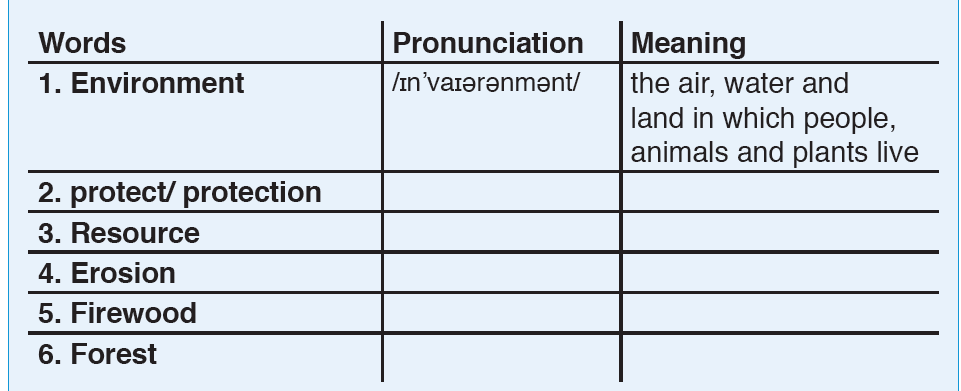
II. Complete the following sentences using an appropriate word or
phrase.
1. I talked to the shy girl ............................ she wouldn’t feel left out.
a. for
b. to
c. so
2 We stopped at the pub .............................. a drink.
a. to have
b. for having
3. We stopped at the pub ........................ a drink.
a. ..for
b. ..for having
c to4. I went to Canada ............................ my brother.
a. to see
b. for seeing
5. Sort your rubbish .............................. recycling.
a. to
b. for
c. so
6. I took the phone back to the store ....................... a replacement.
a. to get
b. for getting
7. We started early ........................... we wouldn’t be late.
a. so
b. so that
8 You need to be over 18 ......................... that film.
a. for watching
b. to watch
9. I am leaving early today ........................... the rush hour traffic.
a. for avoiding
b. to avoid
III. Write short notes on the following questions:
a. Why is it important to protect our resources?
b. Why do people cut down trees?
c. What happens to the soil when too many trees are cut down?
d. What happens to the soil when too much fertilizer is used?
e. How do lakes become polluted?
f. What happens to people when they eat too little protein?
IV. Write a short text describing different ways of protecting
environment using expressions of purpose.
UNIT 8: EDUCATION AND PERSONAL DEVELOPMENT
Key unit competence: To use language learnt in the context of education and development
Introductory Activity
Observe the pictures bellow and answer the questions after them:

1. Discuss the two types of jobs illustrated in both the above pictures.
2. Compare the impact of each job on the lives of their respective practitioners.
3. If you were to choose between the two types of job, which would you prefer? Justify your choice.
8.1 Describing the ability at school and educational ambitions
8.1.1. Learning activity Reading and text analysis
Pre _reading: Discuss the statement below:
Both on personal and national levels, education has been shown to increase economic growth and stability. One of the most important benefits of education is how it improves personal lives and helps societies run smoothly. ... Consequently, education promotes fulfilling, fuller lifestyles.
Picture observation
Observe the picture bellow and carefully answer questions that follows:
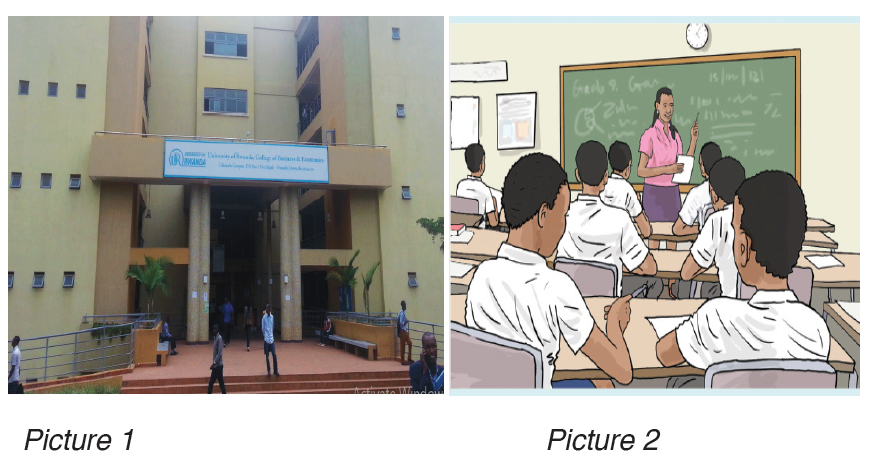
1. What are your future plans after education?
2. Which career would you like to take?
3. Which career inspires you most?
4. Describe what is happening in the two pictures above.
5. Discuss two occupations presented in picture
• Text: Further studies in Rwanda.
There are many opportunities for further study in Rwanda.
Form any careers you have to have certain qualifications.
In order to be a doctor you have to study for a degree in medicine. It takes about six years in order to become a general practitioner.
For some of the specialized areas you might have to study abroad. In order to become a nurse you have to study for a diploma in nursing at a medical school. There are eight schools of nursing in Rwanda, one dental school, and one school of public health.
There are also five government schools of nursing and midwifery. It is also possible to get a nursing degree from university. In order to become a lawyer or accountant, you also have to go to university.
Secondary school teachers have to study for a university degree after S6.
Primary school teachers have to have a teacher’s diploma from one of the13 teacher training colleges in order to teach in the country’s primary schools.
Several countries offer scholarships for African students to further their postgraduate studies overseas. There are enough opportunities for hard-working and motivated students. Centres for Vocational Education and Training teach a number of interesting skills that enable people to be employed and to start their own businesses. They offer courses for those who wish to
become plumbers, electricians, chefs and motor mechanics. They also offer entrepreneurship courses. Learners who want to return to the family farm to continue producing food can improve their skills. Agricultural organizations offer numerous short courses, from technical and management to irrigation and fertilization.
• Comprehension questions
1. How long does it take to become a medical doctor?
2. Can doctors specialize in heart surgery in Rwanda?
3. Can post graduate students in Rwanda afford to study overseas?
4. Where do you need to study if you want to become a nurse?
5. Where do you have to go to become a secondary school teacher?
6. Name four courses that you could study at a Centre for Technical and Vocational Education and Training.
7. How can young farmers improve their farming skills?
8. Have any of the fields of study mentioned above captured your interest as a possibility for future studies? Explain your answer.
9. Exchange notebooks for peer assessment of your answers
8.2.2 Application activity Word Meanings
Using dictionaries use the following words as used in the above text in your own sentences.
a. Degree
b. employ
c. specialization
d. Diploma
e. Course
f. Agriculture
g. Midwifery
h. Graduate
i. Undergraduates
8.2. Sexual behaviour
8.2.1. Learning activity Reading and text analysis-
Text1: Abigali’s story
Read the story bellow and discuss questions after.
“Mama, I know I have failed you, but when you get to know what happened, I know you will be more forgiving…”
“Failed me?” Her mother asked, looking inquisitively at her... “You completely let me down, Abigail. I did not expect you to have a baby before you completed school and was able to take care of yourself, and your baby! I can only hope that you have learnt your lesson. Though a baby is a blessing from God, it comes with responsibilities. Imagine what will happen when your first son
Benji grows older!” she said.
Abigail accepted her mother’s reprimand without bitterness. She was right.
Indeed, the responsibilities currently were already exhausting. ‘Anything more will destroy me though,’ she thought. ‘Every day brings new challenges!
I wonder if I will ever manage to do anything else.’ She said thoughtfully.
“Mama, I want to defer school until Benji is older.”
“No!” her mother said emphatically. “You are going back to school. If you put your education on hold, you will end up giving up on it completely. Then, what will you do with your life? Get married?”
“I will never get married!” Abigail vowed. She surprised even herself by the strength of her voice. “And, I am done with this painful breastfeeding. I’ll feed Benji on cow’s milk and porridge from now onwards,” she added petulantly, her frustration was becoming obvious.
“I know it is hard for you,” her mother told her gently. “But, of all the things you can do for Benji, please… please, breastfeed him,” she added, almost as a plea. She looked at her daughter keenly, treating her more as an equal than a child. Then she said, “As for school, Abigail, that is the place to take your fight to, in order to prove that having a baby doesn’t mean one’s life is over.”
For Abigail, motherhood had become a continuous physical and emotional pain. Her tiny breasts were now large and painful. She prayed that her mother could agree to the alternative way of feeding Benji, other than breastfeeding.
The mere imagination of his lips on her nipple made her wince. Indeed, just thinking about the forceps and scissors that had been used during Benji’s birth still made her sweat. Now, it would take a good number of years to nurture Benji to the point where he could care for himself. In the meantime, what would she be doing with her life?
“Mama, I wish I had known what I was getting myself into. I cannot take care of Benji and think about school at the same time, can I?” “You should have remembered my advice. But, as far as school is concerned, the sooner you go back, the better. It will be tough, yes; but I know you are strong enough to pull through,” she said, and she had obviously made up her mind on the matter...
Extract from the Novella, Sunrise after Midnight, by Florence.....
• Comprehension questions
1. Is Abigail happy of what she has experienced?
2. According to the passage, did Abigail listen to her mother’s advice?
3. Which advice can you give to Abigail after such experience?
4. How can we avoid such incidences?
5. Discuss with the help of dictionaries and internet, what sexual behaviour mean in a broad manner.
8.3. Life skills
8.3.1. Learning activity Reading and text analysis
Text1: True friendship
Read the text below and answer the following questions:
Horror gripped the heart of the World War I soldier as he saw his lifelong friend fall in battle. Caught in a trench with continuous gunfire whizzing over his head, the soldier asked his lieutenant if he might go out into the “no man’s land” between the trenches to bring his fallen comrade back.
“You can go,” said the lieutenant, “but i don’t think it will be worth it. Your friend is probably dead and you may throw your life away.” The lieutenant’s advice didn’t matter, and the soldier went anyway. Miraculously he managed to reach his friend, hoist him onto his shoulder and bring him back to their company’s trench. As the two of them tumbled in together to the bottom of the trench, the officer checked the wounded soldier, and then looked kindly at his friend.
“I told you it wouldn’t be worth it,” he said. “Your friend is dead and you are mortally
Wounded.
“It was worth it, though, sir,” said the soldier.
“What do you mean; worth it?” responded the Lieutenant. “Your friend is dead.”
“Yes, Sir”the private answered. “But it was worth it because when I got to him, he was still alive and I had the satisfaction of hearing him saying, “Jim…, I knew you’d come.”
Many times in life, whether a thing is worth doing or not, really depends on how you look at it. Take up all your courage and do something your heart tells you to do so that you may not regret not doing it later in your life. May each and every one of you be blessed with the company of TRUE FRIENDS.
A true friend is one who walks in, when the rest of the world walks out. War doesn’t determine who’s right. War only determines who’s left.
Extract from Military Story: True Friend by STEPHEN on JUNE 19, 2011
Comprehension questions
a. Who is a true friend according to the passage?
b. What does mortally wounded mean?
c. Did this private soldier have any life skill? Discuss.
d. Explain the statement” it’s worth it”_ _ _ according to the text.
• Note:
Life skills are skills for adaptive and positive behaviour that enable humans to deal effectively with life. Gaining life skills is vital for one to meet life challenges. Examples of life skills: Critical thinking, cooperation, conflict resolution, decision making, problem solving, love for work well done, etc.
8.3.2. Language structure: Conditional clauses
Notes:
There are several kinds of conditional clauses,
They express different conditions and are followed by main clauses that show the results of such conditions.
Below are some of the types of conditional clauses:
1. Zero conditional.
This is used to refer to general truths.
Examples:
a. If it rains, the grass gets wet.
b. If the sun shines, it gets hot.
Both main clauses show obvious results.
2 1st conditional
Refers to a possible condition and its subsequent or probable result.
Examples:
a. If you work hard every day, you will pass examinations.
b. If you read for half an hour every day, your English will improve.
The main clause is in the present or future when it expresses a real situation.
The first conditional is also called a ‘will’ conditional. It is a sentence that talks about the future with a given condition in mind. The sentence also talks about the result of this condition. The events in the main part of the sentence depend on the condition given in the conditional clause. The main part of the sentence is called the independent - clause and has the modal ‘will’. There
is a real possibility that this condition will happen.
3. 2nd conditional t
The second conditional clause expresses a situation that may take place now or any time but not yet real because it has not happened. It therefore refers to a possible condition that might have a certain result.
Examples:
a. If you went to bed earlier, you would not be so tired.
b. If my English was good, I could get a job in the UK.
4. 3rd conditional clause
This conditional is expressed in the past and shows a situation that is different from reality.
Examples:
a. If he had studied harder (which he didn’t), he would have passed the examinations (which he didn’t either).
b. If my English was good (which it is not the case), I could have got a job in the UK (which I have not).
c. If we had looked at the map(which they didn’t), we would not have got lost(they got lost).
N.B.
• When an if- clause comes first, a comma is used. But when the mainclause comes first, no comma is used.
• A conditional clause can begins with if or unless. Both if and unless, express conditions.
Examples:
a. Unless I read my books, I will not be promoted.
b. If I don’t read my books, I will not be promoted.
• When __ clauses can also be used to replace if clauses, they mean the same.
Examples:
a. When/if I finish my studies, I will become a business man.
b. When/if I finish my Education, I will be a lecturer.
Exercises
1. Complete the sentences bellow correctly:
a. If you had done your homework ________.
b. If I was a farmer,__________________,
c. If he had read English for half an hour every day ________.
d. If you had looked after your textbooks ________.
e. If I was a doctor,______________________
f. If I was a lecturer,__________________
g. If your English was better, ________.
h. If you went to bed earlier, ________.
2. Use two of the words below in sentences of your own to show that you understand their meaning:

3. Give the correct form of the verbs in brackets.
i. Last year they (start) secondary school.
ii. They (be) nervous about starting a new school.
iii. Some of them (go) to boarding school
iv. They (learn) to take responsibility for their own work
v. The teachers (keep) them very busy during their first term.
vi. Make 9 sentences using if clauses (three sentences in each type)
8.5 End unit assessment
1. This section can be used for formal assessment or for revision.
Write three sentences expressing your aspirations for future education. Use appropriate conditional clauses.
2. Provide the correct conditional in the sentences below.
a) If you were not late for school every day ________.
b) If he had spent more time on his studies ________.
c) ________ she would have won a bursary.
d) If you had done more research on careers ________.
e) If you had completed your further studies ________.
3. Debate on advantages and disadvantages of early pregnancies.
4. Referring to the story above and unit 5 in this book. Use the 2nd.
conditional clause in your own sentences. make 5 of them.
5. Discuss the importance of education.
UNIT 9: SCIENCES AND TECHNOLOGY
Key unit competence: To use language learnt in the context of
Sciences and Technology
Introductory Activity Picture observation and interpretation
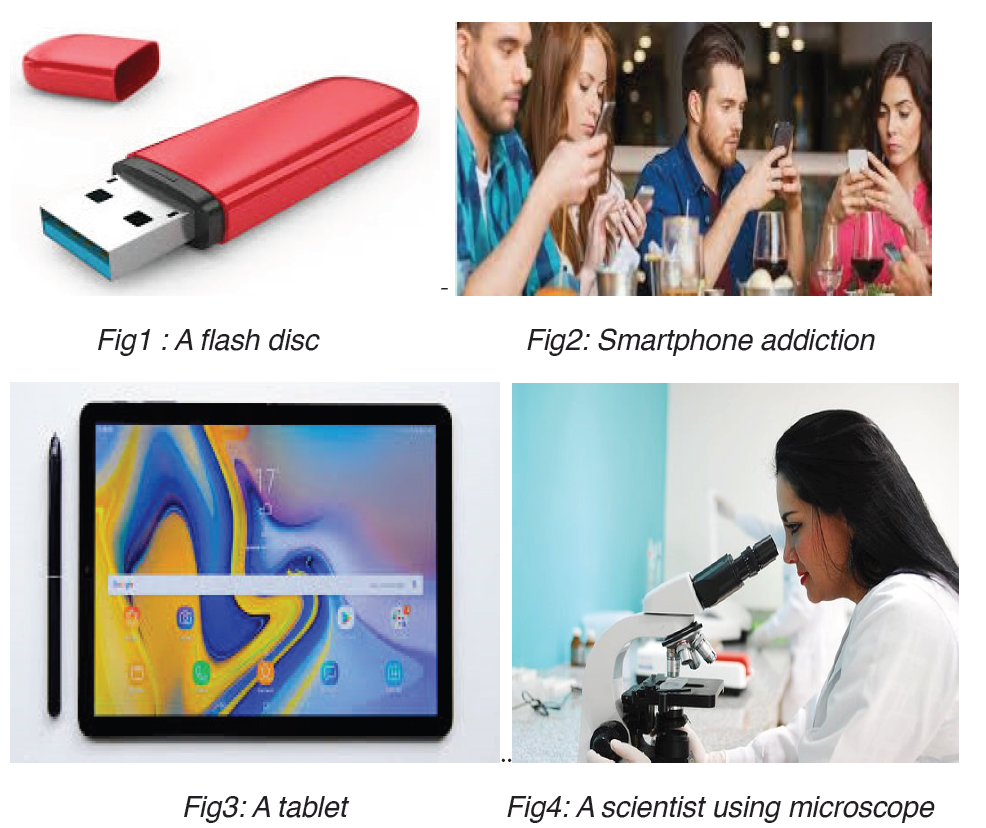
1. Discuss the use of the devices in fig1.
2. The people in fig2 are around the table sharing a drink but they are not talking to one another because they are busy chatting. Do you think it is a good practice? Explain.
3. Explain the use of the devices in fig3
4. Explain the use of the devices in fig4
9.1. Talking about words and expressions used in the context of science and technology
9.1.1. Learning activity Reading and text analysis
Text1: Technology is changing the World of Medicine
Read the passage below and answer the questions that follow:
A large number of digital innovations are revolutionizing healthcare and technology in medicine is here to stay. Numerous innovations and new solutions are already on the market and they have all improved healthcare drastically. Today, multiple medical issues such as congestive heart failure, diabetes, medication noncompliance, even stressful isolation, are researched
and solved with remarkable new technologies. The following are some areas researchers are targeting: The first area targeted by researchers is heart failure. One of the most common and costly diagnoses is that of heart failure, with a mortality rate closer to cancer. It includes three types of sensors –wristband, necklace and watch – which are used for testing. This type of diagnosis gives both patients and doctors continuous information on how a compromised heart is functioning.
The second area targeted by researchers is 3D printing. These days, medical researchers are considering the potential of 3D printing in medicine. For example, Kaiser Permanente’s Los Angeles Medical Centre is perfecting the use of 3D printers to replicate multidimensional models of problematic areas inside patients. Surgeons can handle the models and simulate a
variety of possible operation replicas before performing the actual surgery. Alternatively, 3D printing can be used in reproducing bones or other organs in the human body.
The second area targeted by researchers is the area of mobile applications. Today, mobile applications are available for everything. In the healthcare sector, this is especially true. Doctors and patients are discovering new ways to use technology to monitor personal health. Nowadays, tracking daily sleep patterns, counting calories, researching treatment options, and even monitoring heart rate is possible.
Thirdly, remote monitoring technology is one of the most useful and practical innovations in recent years. The systems can be used by patients in the comfort of their homes to reduce the time and financial cost of recurring visits to the doctor. By using a small device designed to measure a particular health issue, doctors can analyse a patient’s data remotely without the need
for them to come down to the hospital.
This must be the reason why the Government of Rwanda recognized that there is a need to strengthen science, technology and research and is engaged in many National and Regional initiatives to help build this capacity.
Adapted from https://www.hunimed.eu/news/technology-changing-worldmedicine/
• Comprehension questions
1. State four medical issues that are researched and solved with remarkable new technologies.
2. What are the three areas targeted by researchers mentioned in the passage?
3. State and explain the use of the three types of sensors mentioned in the passage.
4. Explain how 3D printing technology helps surgeons in their work.
5. Evaluate the use of mobile applications in healthcare sector.
6. Assess the importance of remote monitoring technology in healthcare sector
• Vocabulary activity
Use a dictionary and thesaurus to look up the missing meanings of the words/phrases in the table below. Copy the table into your book and fill in the blank spaces.
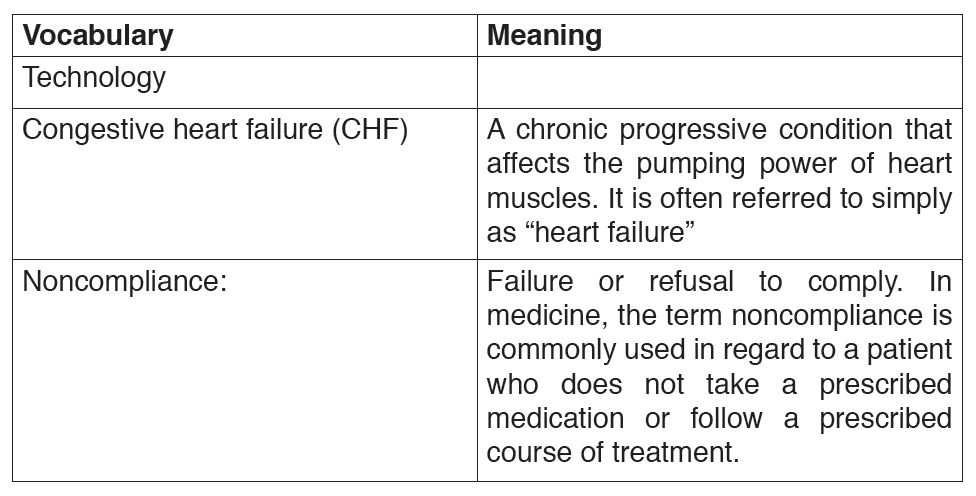
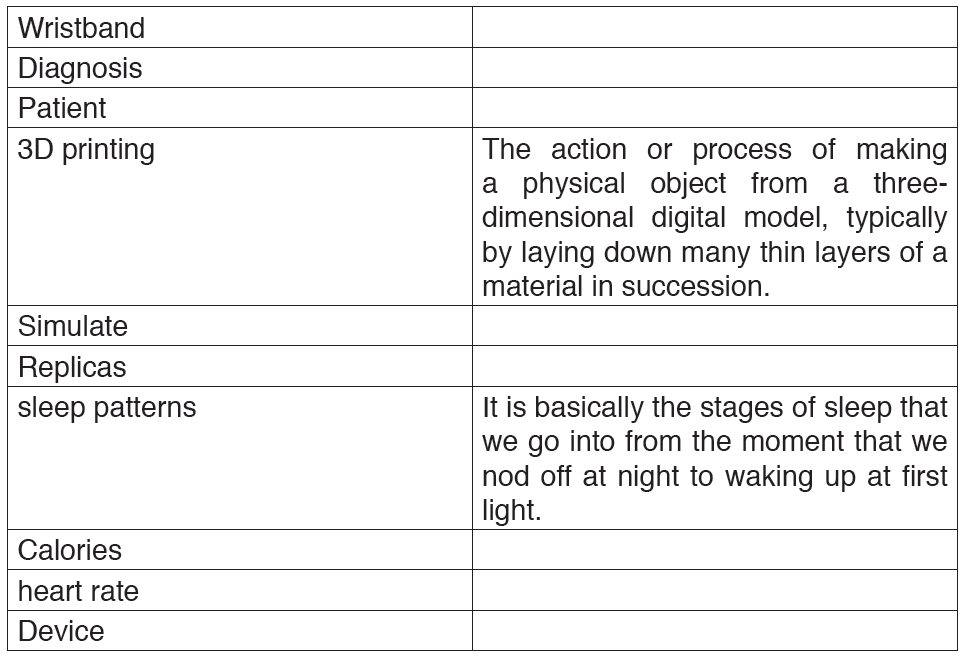
Text 2: Body systems
Read the passage below and answer the questions that follow:
Our bodies consist of a number of biological systems that carry out specific functions necessary for everyday living.
The job of the circulatory system is to move blood, nutrients, oxygen, carbon dioxide, and hormones, around the body. It consists of the heart, blood, blood vessels, arteries and veins.
The digestive system consists of a series of connected organs that together, allow the body to break down and absorb food, and remove waste. It includes the mouth, oesophagus, stomach, small intestine, large intestine, rectum, and anus. The liver and pancreas also play a role in the digestive system because they produce digestive juices.
The endocrine system consists of eight major glands that secrete hormones into the blood. These hormones, in turn, travel to different tissues and regulate various bodily functions, such as metabolism, growth and sexual function.
The immune system is the body’s defence against bacteria, viruses and other pathogens that may be harmful. It includes lymph nodes, the spleen,bone marrow, lymphocytes (including B-cells and T-cells), the thymus and
leukocytes, which are white blood cells.
The lymphatic system includes lymph nodes, lymph ducts and lymph vessels, and also plays a role in the body’s defences. Its main job is to make and move lymph, a clear fluid that contains white blood cells, which help the body fight infection. The lymphatic system also removes excess lymph fluid from bodily tissues, and returns it to the blood.
The nervous system controls both voluntary action (like conscious movement) and involuntary actions (like breathing), and sends signals to different parts of the body. The central nervous system includes the brain and spinal cord.
The peripheral nervous system consists of nerves that connect every other part of the body to the central nervous system.
The body’s muscular system consists of about 650 muscles that aid in movement, blood flow and other bodily functions. There are three types of muscle: skeletal muscle which is connected to bone and helps with voluntary movement, smooth muscle which is found inside organs and helps to move substances through organs, and cardiac muscle which is found in the heart
and helps pump blood. The reproductive system allows humans to reproduce. The male reproductive system includes the penis and the testes which produce sperm. The female reproductive system consists of the vagina, the uterus and the ovaries which
produce eggs. During conception, a sperm cell fuses with an egg cell, which creates a fertilized egg that implants and grows in the uterus. Our bodies are supported by the skeletal system, which consists of 206 bones that are connected by tendons, ligaments and cartilage. The skeleton not only helps us move, but it’s also involved in the production of blood cells and the storage of calcium. The teeth are also part of the skeletal system, but they aren’t considered bones.
The respiratory system allows us to take in vital oxygen and expel carbon dioxide in a process we call breathing. It consists mainly of the trachea, the diaphragm and the lungs.
The urinary system helps eliminate a waste product called urea from the body, which is produced when certain foods are broken down. The whole system includes two kidneys, two ureters, the bladder, two sphincter muscles and the urethra. Urine produced by the kidneys travels down the urethras to the bladder, and exits the body through the urethra.
The skin, or integumentary system, is the body’s largest organ. It protects us from the outside world, and is our first defence against bacteria, viruses and other pathogens. Our skin also helps regulate body temperature and eliminate waste through perspiration. In addition to skin, the integumentary system includes hair and nails.
Adapted from https://www.livescience.com/37009-human-body.html
• Comprehension questions
1. What are biological systems mentioned in the passage?
2. Which biological system helps oxygen to move around the body?
3. What is the role of the liver and pancreas in the digestive system?
4. Which biological system regulates metabolism, growth and sexual function?
5. Which biological system protects from falling sick?
6. Do you think our nervous system has anything to do with our sight?
Justify your answer.
7. State the three types of muscles and explain their functions?
8. What is the role of urinary system?
9. What is the body’s largest organ?
10. Hair and nails belong to which biological system?
• Vocabulary activity.
Use a dictionary, thesaurus or Internet to look up meaning of the following
words/phrases as they are used in the above passage. (The words are highlighted in the text)
a. Hormones
b. Metabolism
c. Bacteria
d. Viruses
e. Pathogens
f. Leukocytes
g. Tissues
h. Spinal cord
i. Cardiac
j. Conception
k. Perspiration
9.1.2 Application activity Compositing writing
1. Have you ever been in a hospital? Write a short composition describing a technological tool you saw there. If you never went
there, you can describe a tool you have heard of or read about.
2. Write a short composition on the importance of physical exercise for our body systems.
9.2. Describing the role of ICT devices and their side effects
9.2.1. Learning activity Reading and text analysis
Text1: The positive and negative impacts of ICT
Read the passage below and answer the questions that follow:
As it is known from time immemorial that everything in life is like the two side of a coin, there is always a positive and negative side of every phenomenon. But whether the effect is positive or negative the effects of Information Communication Technology (ICT) is far reaching and cannot be overemphasized. The Effects of ICT lens looks at how our lives have been changed, for better and for worse, by the impact of ICT. It includes both positive effects and negative effects.
One of the positive effects of ICT is access to information. Possibly the greatest effect of ICT on individuals is the huge increase in access to information and services that has accompanied the growth of the Internet.
Some of the positive aspects of this increased access are better, and often cheaper communications, such as phone calls and Instant messaging. In addition, the use of ICT to access information has brought new opportunities
for leisure and entertainment. Another positive effect of ICT is easy access to education. With ICT there are new ways of learning, such as interactive multi-media and virtual reality. ICT has also created new job opportunities, such as flexible and mobile working, virtual offices and jobs in the communications industry among others.
ICT can be used for processes that had previously been out of the reach of most individuals, such as photography, where digital cameras, photo-editing software and high quality printers have enabled people to produce results that would previously require a photographic studio.
ICT can be used to help people overcome disabilities. For example screen magnification or screen reading software enables partially sighted or blind people to work with ordinary text rather than Braille.
As far as negative effects are concerned, ICT has caused Job loss, reduced personal interaction and reduced physical activity.
As for Job loss, one of the largest negative effects of ICT can be the loss of a person’s job. This has both economic consequences, loss of income, and social consequences, loss of status and self-esteem. Job losses may occur for several reasons, including the replacement of manual operations by automation. This can happen when, for example, robots replace people on an assembly line. People can also lose jobs due to Job export. This is when Data processing work is sent to other countries where operating costs are lower. Multiple workers can also be replaced by a smaller number of people who are able to do the same amount of work using machines.
Personal interaction and physical activity have also been negatively affected by ICT. Being able to work from home is usually regarded as being a positive effect of using ICT, but there can be negative aspects as well. Most people need some form of social interaction and physical exercise.
Adapted from https://ajahana.wordpress.com/2012/06/27/the-positive-andnegative-impacts-of-ict-5/
• Comprehension questions
1. What do you understand by “everything in life is like the two side of a coin”?
2. What strengthened the huge increase in access to information?
3. Explain how ICT has created new job opportunities.
4. Using an example, explain how ICT has enabled people to do processes that had previously been out of the reach of most
individuals.
5. In which ways can ICT make people lose their jobs?
• Vocabulary activity
Use a dictionary, thesaurus or Internet to look up meaning of the following
words/phrases as they are used in the above passage. (The words are highlighted in the text)
a. phenomenon
b. Overemphasized
c. Lens
d. Information
e. Internet
f. Leisure
g. Entertainment
h. Virtual reality.
i. Manual operations
j. Automation
k. Job export
9.2.2 Application activity Sentece writing, CompositIon and Debate
1. Use each of the above words in a sentence of your own to illustrate how they are used.
2. Writer a 100word composition on smartphone addiction.
3. Debate
Referring to notes on debating techniques in unit 5, debate the following motion.
“This house believes that ICT has done more harm than good”
9.3. Language structure: Word formation
Introduction:
In linguistics (particularly morphology and lexicology), word formation refers to the ways in which new words are made on the basis of other words or morphemes. This is also called derivational morphology.
Most English vocabulary arises by making new lexemes out of old ones. This can be done either by adding an affix to previously existing forms, altering their word class, or combining them to produce compounds. Below are some types of word formation processes.
1. Derivation
Derivation is the creation of words by modification of a root without the addition of other roots. Often the effect is a change in part of speech.
Examples
• Empty-emptiness (adjective was changed into a noun)
2. Affixation
(This is like a subtype of derivation)
Affixation is the process of adding a morpheme or an affix to a word to create either a different form of that word or a new word with a different meaning.
Affixation is the most common way of making new words in English. An affix is a word element of English grammar used to alter the meaning or form of a word and comes in the form of either a prefix or a suffix. The two primary types of affixation are prefixation, the addition of a prefix, and suffixation, the addition of a suffix.
3 Prefixation
Prefixation is a morphological process whereby a bound morpheme is attached to the front of a root or stem. The kind of affix involved in this process is called a prefix. Prefixes include examples like; “un-,” “self-,” and “re-,”
Example:
The prefix un- attaches to the front of the stem selfish to form the word unselfish.
Other examples include:
9.4. Suffixation
Suffixation is a morphological process whereby a bound morpheme is attached to the end of a stem. The kind of affix involved in this process is called a suffix. Suffixes come in the form of ending elements like; “-hood,”“-ing,” “-ness,”, “-ed…”
• Communicate-communicator
Think of the 26 common suffixes in the table as clues to the meanings of words. Keep in mind, though, that the meanings of words are best determined by studying the contexts in which they are used as well as the parts of the words themselves.
Noun Suffixes
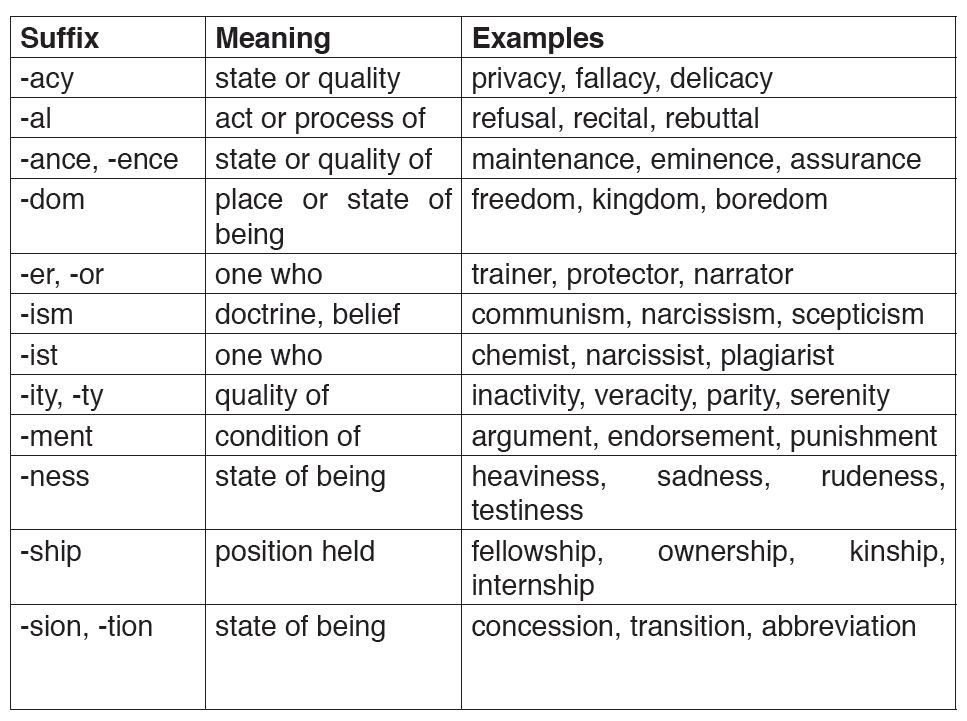
Verbs suffixes

Verbs can end with either -ize (the American spelling) or -ise (the British spelling). Examples include finalize/finalise and realize/realise.
Adjective Suffixes
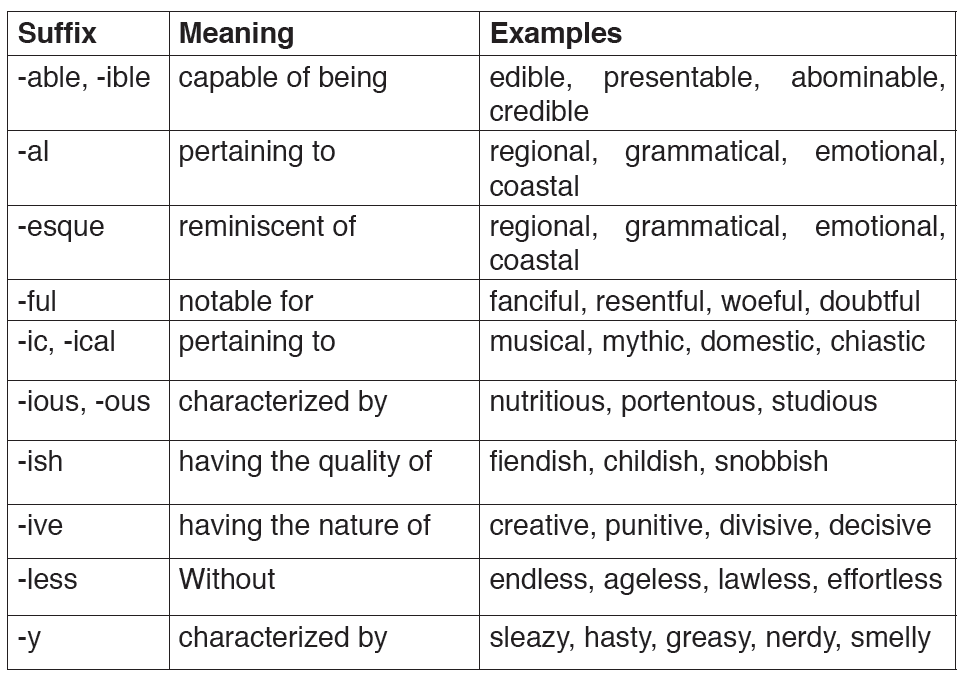
The examples above are adopted from https://www.thoughtco.com/commonsuffixes-in-english-1692725
Exercises
1. Use prefixes to find the opposite of these verbs:
a. Use
b. Agree
c. Engage
d. Behave
e. Understand
f. Fold
g. Spell
h. Connect
i. Close
2. Complete the sentences by writing the correct prefix from the table below in the blank space. You can use a dictionary to help
you

a.I just can’t believe it! The story is _____believable!
b. No, that answer is _____correct. It is wrong.
c. Let’s look at this information again. We should _____view it before the test.
d. I saw Kalisa just a moment ago, but now I can’t find him! It seems that he _____appeared!
e. Oh, I’m sorry, I didn’t hear you correctly. I _____understood you.
f. The subway does not go over the land like a normal train. It moves_____ground.
3. Put the words in brackets in the appropriate form (use prefixes or suffixes):
a. He was acting in a very………………. way. (child)
b. She looked……………. She started to cry. (happy)
(succeed)
d.The team that he supported was able to win the……………….(champion)
e. I couldn’t find any……………………in his theory. (weak)
f. He wants to be a……………………………when he grows up.
(mathematics)
g. There were only a……………………… of people at the match.
(hand)
h. The road was too narrow, so they had to……………………it.
(wide)
i. I think that you should……………………… your decision. It may not be the best thing to do. (consider)
j. You need a…………………….of motivation, organization and hard work to realize your dreams.(combine)
9.5 End unit assessment
1. Use a prefix or a suffix to make a new word out of the word in brackets. Complete the sentence with it.

a. I can’t answer this question. It’s………… (possible).
b. Don’t stand near the water. It’s too………… (danger).
c. I don’t like this fish. It’s not very well………… (cook).
d. Kate started crying because she was so………. (happy)
e. If you have a haircut it will change your………………………(appear)
f. Paul never waits in queues. He is too……………(patient)
g. Thank you for your advice. You have been very…………(help).
h. Stealing other people’s money is………………(honest)
i. Our science………………is very young. (teach)
j. Harry didn’t think the book was very………… (interest).
k. A million pounds was given to the hospital by an…………person(known)
l. When you…………. this paragraph, make it a bit shorter (write)
m. That was a great film. It was really……………. (enjoy)
n. Mary was wearing a/an……………….hat (usual)
o. I like this town. The people are very………………(friend)
p. I don’t think you’re right. I…………with you completely (agree)
2. Identify at least five words formed through the process of affixation in the following paragraph.
One of the positive effects of ICT is access to information. Possibly the greatest effect of ICT on individuals is the huge increase in access to information and services that has accompanied the growth of the Internet. Some of the positive aspects of this increased access are better and often cheaper communications, such as phone calls and instant messaging. In addition, the use of ICT to access information has brought new opportunities for leisure and entertainment.
3. Write a short composition on advantages and disadvantages of social media in society.
UNIT 10 LITERATURE IN ENGLISH
Key unit Competence: To analyse literary texts based on their genres and period.
Introductory Activity
Quotation: “Literature is news that stays news”
• Why do you think literature is important in your daily life?
• What do you understand by the word literature?
10.1 Defining Literature
10.1.1. Learning activity Reading and text analysis
Text1: Importance of studying literature
Read the passage below and answer questions that follow:
“By studying literature, I find that this sense of confusion and search for
self-discovery is a common theme. I am confident that my choice to be an English major is one that I will be satisfied with. Thus far, in my opinion, to be an English major necessitates more than just being able to read and write well.
An English major must also strive to understand and interpret the importance that various forms of literature have had on the society of the past and the present. Being able to express opinions is another important aspect, as it is starting a piece of literature with an open mind. These habits are also important when facing everyday life, not just literature.
The chance to read and write is something that everyone should be able to experience. Literature in all forms is everywhere today, and with this idea, it is clear just how important it is. Whether it is studied in the classroom, read for pleasure or purpose, literature is a central part of many lives. It offers not only a chance to enlighten a person, but it also gives the chance to broaden one’s horizons and perspectives.
In my case, having the opportunity to study literature in two different languages has helped me to find similarities in two different cultures, and to also find that although literature varies in form and content, it is important, and it is a central part of many lives.” (Written by Stephanie Conroy)
• Comprehension questions.
1. From your understanding of the passage, explain the term literature.
2. Why do you think literature is important? Clearly explain your points.
3. What does the writer mean by the phase,” …necessitates more than just being able to read and write”?
4. Discuss the different ways an English major use to better their literature in English skills.
5. Provide the synonyms of the following words highlighted in the text above and use the alternative words to construct sentences:
i. Strive
ii. Enlighten
iii. Broaden.
• Notes
Literature has a more technical and specific meaning. It is the kind of art, which uses language in a special way to comment on society.
Others simply define it as, anything that has been written in some form or another with the aim of talking about life and society.
What is the difference between literature in English and English literature?
Literature in English would be any literature written in the English language while English literature is literature believed to originate from England or from the English people.
Literature in English exists in two forms and that is oral and written literature.
In the traditional Rwanda society, there are poems, songs, proverbs, riddles, tongue twisters, fairy tales, legends and myths. All these are regarded to be important in promoting Rwandan values and traditions. This is referred to us oral literature because it is verbal and transmitted orally and delivered by word of mouth.
Important tips on how to study a literary text:
• Begin to better your reading by focusing on your favourite genres of literature. It could be a short story, poem, nonfiction, drama, fiction, biographies etc.
• Read for a purpose. This does not mean reading only for your test or exam but it could also be for personal growth such as adding vocabulary and improving you reading speed.
• Read to understand and not to finish. This will help to sustain your concentration.
• Create a mental picture of the events unfolding in the book or poem that you are reading because it will directly connect you with the book making it more fun and worth reading.
• Before reading, trace the history of that book and that of the author. It will facilitate a better understanding of that literary piece.
Text 2: The origin of English Literature
Read the text below and answer the questions that follow:
English literature began with the history of dark ages around the 8th– 14thcenturies which introduced various types of poems including epics, ballads, hymns and so on. The first examples of English literature were written in Anglo-Saxon’s language, which is the source of English speaking but should be considered almost another language.
Almost all men of literature accept that English literature begins with Beowulf, who belonged to the Germanic Tradition of the Anglo-Saxons.
Dark ages, also called Old English, had a more unclear structure than the present day, where language structure or meaning has different features. The main point of the Old English is the oral tradition.
Old English Period has no written text or works and it ended with the Norman Conquest, a turning point in British history, to the middle of 11th century which had the transition from the oral phase to the written phase. At the end of the Old English Period, Middle English Period began. This period helped to shape English Literature’s framework and produced many literary products.
Geoffrey Chaucer was the greatest creator of Middle English literature. In his long poems such as ‘Troilus and Criseyde’ (1385) and ‘Canterbury Tales’ (1387-1400), Chaucer painted very vivid portraits of people of all kinds and wrote many stories in different moods from the most painful to the most laughable or interesting.
After the humanist movement which started in the 15th century, it brought up great artists in English literature, poetry, theatre, and prose. Spencer, who is considered to be the greatest poet of English poetry, Shakespeare, Marlowe, Ben Johnson, Milton, Bacon, who are the greatest theatrical writers of world literature as well as English literature, are among these writers who gave
the most brilliant works of English literature in the early years. In the 18th century, artists such as Defoe, Swift, and Feilding gained fame; different literary movements influenced artists in later periods.
(By Kubla Khan-ancient writer of Literature)
• Comprehension questions
1. When did the written phase of English literature start?
2. Name the writer who started English literature?
3. Summarise the text above in about 90 words.
4. Which types of poems were introduced by Ohere between 8th and 14th centuries? Explain briefly each of these poems.
10.1.2. Application activities: Summary writing
1. In your own words, summarize the text above.
2. Complete the following sentences.
a. Oral literature is……………………….
b. Written literature is…………………
10.2. Talking about the three literary genres.
10.2.1. Learning activity Reading and text analysis
Text: The story of Kagure
Read the text below attempt the questions given below:
The first time Kagure wore a pair of shoes was the day she was admitted at Kibomet Girls High School. It was a cheap second-hand pair, but to Kagure, the shoes represented all the good things that education would help her achieve. Most days her family could only afford one meal a day. When things were bad, they would sleep hungry. Unable to face the children and tell them
there was no food for the day, Kagure’s mother would tell her to put a pot of water onto the fire to boil. She would say that someone was on the way with flour to make maize meal. Once the water came to a boil, she would tell one of the children to bathe with the water since the person with the flour had not yet arrived. She would do this again with a second pot of water, and on it went. Wambui would make sure there was little firewood in the hearth so that each pot of water took a while to boil.
As the evening wore on, the three younger children would doze off, leaving Kagure and her brother. Finally, they too would figure out there was no one coming with flour and go to bed. This grinding poverty had driven Kagure to work relentlessly hard and excel in school. She knew she was the ticket to her family’s better future. “Do you know what Lumanzi gave me?” Tracy asked Kagure mischievously. Kagure had seen Lumanzi press something into Tracy’s palm as they were parting. “I don’t know, and I don’t care,” Kagure said, wishing they were already in school. She vowed she would avoid Tracy henceforth. The girl spelt trouble with a capital T. “Come on, ask.
I know you are curious,” Tracy teased “No!” Kagure answered tersely. The new girl had already put her into more trouble than she had ever been in her two years in secondary school. “Well, I will tell you anyway. He gave me his mobile phone number,” Tracy said, showing Kagure the slip of paper with the number. “He also gave me this,” she added, holding five hundred shillings in loose notes. To Kagure who had never had as much as fifty shillings as pocket money, five hundred shillings was an absolute fortune for a student to have. The idea that Tracy had taken all that money from a man she hardly knew was alien to Kagure.
She still remembered the thrashing she had received from her mother when she was in Primary 6. She had come home from school hungry and found there was no food in the house. In the morning, she had only taken a cup of black tea before going to school and had had nothing to eat the whole day.
Kagure had sat on the steps outside their house enduring pangs of hunger. A neighbour, who made a living from brewing illicit liquor, was passing by when he saw her sitting there forlornly, capping her chin. “What is wrong, daughter of Wakapanga? Are you ill?” he asked her. Driven by hunger, Kagure had answered she was not sick, just very hungry. The man, perhaps moved by
the plight of the little girl, gave her some money. “Go and buy some food,” he told her. Kagure ran to the marketplace and bought a loaf of bread. When she came back, she found her brother, Mburu, at home. The two of them started stuffing the dry bread into their mouths. That is how their mother Wambui found them – cheeks bulging with bread that was difficult to swallow
without a drink. “Where did you get this bread?” she asked, grabbing the few slices that were remaining. “Baba Wairimu gave me the money to buy it,” Kagure said, struggling to swallow what was in her mouth. “Why did he give you the money? Did you work for him?” Kagure’s mother demanded. “I told him I was hungry,” Kagure answered, knowing from her mother’s demeanor
she was in deep trouble.
Wambui, who had lived in Gituamba village for a long time, knew that there were no free things. She was trying to raise her children to know this and that they had to work to get whatever they needed. If her daughter was to survive, she had to learn this lesson. Wambui threw the remaining bread away and took a stick, which she kept handy for disciplining her children. And
Kagure did learn the lesson. She received a thrashing she would remember for a long time to come. “He gave you money and you took it?” Kagure asked aghast, remembering the thrashing. “Why not?” Tracy asked her.
“At least now I have some pocket money. Here, let’s share it,” she added, handing Kagure two hundred shillings. Kagure regarded the money, thinking how much easier life at school would be with some pocket money. She had reported to school with one bar of soap, which she was using to bathe and to wash her clothes. Her small tube of toothpaste would hardly see her through the term. She polished her shoes once a week so that the tin of polish she had carried would last a little longer.
During tea breaks, other students bought bread at the school canteen to have with their mid-morning tea. Kagure would take her tea quickly and head back to class. The temptation to stretch out her hand and take the money was great. It would be enough to buy a small tube of toothpaste, a packet of sanitary towels and there would still be a little left for half a loaf of bread.
“Come on, take it,” Tracy urged her. “No, thanks. I don’t take money from strangers.” “Lumanzi is not a stranger. I told you we met last night,” Tracy said as she pocketed the money. “You met last night, huh! How well do you know him?” “Well, let’s see. Lumanzi is gorgeous. He took the trouble to see me safely to school, has bought us lunch and given me some money. I would
say he is one stranger I would love to know,” Tracy said, waving the slip of paper with Lumanzi’s phone number. “You are …” Kagure began, searching for words to describe Tracy. “Incorrigible, irredeemable, crazy, yeah, I am all that,” Tracy suggested, laughing. “Just stay away from me in future,” Kagure said, exasperated (Adapted from Beyond the Barricades by Muthoni wa Gichuru)
• Comprehension questions
1. What is the extract about?
2. Where is the setting of this extract?
3. Comment on the kind of diction used. Is it formal or informal? Explain.
4. Discuss the themes developed in the text above.
5. Discuss the character traits of Kagure.
• Notes
A. Definitions:
What is literary genre?
• The word ‘genre’ originates from a French word ‘genre’ which means kinds or types or forms. There are three literary genre and these are; prose, poetry and drama. In this sub-unit, the focus will be on prose as one of the main literary genres.
What is Prose?
Prose refers to all forms of written or spoken expressions that are not inverse.
In other words, it is the way people speak every day. It is written in words, phrases, sentences, paragraphs and chapters. It utilizes punctuation, grammar and vocabulary to develop its message. Prose is written from one end of the page to the other. It is made up of fiction and nonfiction. When someone tells or reports about actions and conversations taking place around, the result would be prose. Texts written in form of prose can be characterized as fiction or nonfiction.
Fiction is prose writing that consists of imaginary elements. It springs from the writers’ imagination. It usually focuses on unreal events about individuals, societies, animals etc. with one or more lessons to learn from.
Nonfiction is writing that tells about real people, places and events. Unlike fiction, nonfiction is mainly written to convey factual information.
Prose fiction includes:
1. Novels
A novel is a piece of long narration of a story in literary prose. Narrative prose is meant to entertain and tell a story. It is a description of actions and includes characters, setting and an ending. Some of the novels include, No longer at ease by Chinua Achebe,
NB; A novel is an extended work of fiction. Like a short story, a novel is essentially the product of a writer’s imagination.
So long A letter by Mariama Ba. Etc.
2. Mystery
This is a novel in which the reader is challenged to solve an issue that is complicated and confusing before explains it at the end
3. Romance
This is prose that focuses on the romantic love affair between usually two young people who turn out to be the main characters in the book.
4. Short stories
A short story is a work of fiction that is determined by its length. They are believed to be between 1,000- 7,500 words and can be read to completion in a single seating such as, the happy Princess by Oscar Wilde, Say you one of them by Umem Akpan and many others.
5. Historical fiction
The genre of historical fiction in the field of children’s literature includes stories that are written to portray a time period or convey information about a specific time period or an historical event. Usually, the event or time period is about 30 years ago and involves imaginary or real events and characters.
Prose nonfiction writing includes:
1. Essays
These are documents or writings which focus on specific topics that contain a mix of fact and opinion, laid out in logical sequences and employing appropriate ways of expression. An essay comprises both content (what is said) and form (the way in which it is written.
NB: Essay is a short work of nonfiction that deals with single subject. / brief
prose works that are based on fact.
2. Autobiographies
This is information about a person’s life written by themselves. For example, the autobiography of Michael Obama, Gifted hands by Ben Carson.
NB: Autobiography is a writer’s account on his or her own life. It is generally told from the first person point of view.
3. Speeches
This is a type of a literary nonfiction Meant to be delivered to an audience.
It is usually formal and talks about a specific subject. As future leaders, it is important that you master the skill of presenting and writing speech.
NB: speech is a talk or public address. The purpose of a speech may be to entertain, to explain, to persuade, to inspire, or any combination of these aims.
4. Journals
A journal covers a specific subject area or topic and are publish regularly (weekly, monthly or yearly. They are knowledge based and are written by experts in subject areas. Journals are fun to use because they are organized and easily understood.
NB: A journal is a regular record of writer’s thoughts, experiences and feelings.
B. Aspects to consider when analysing novels and short stories
Here are some of the definitions of terms when analyzing literature. For clarity and understanding while studying literature, it’s important to know the following terms:
1. Setting
This, in simple terms is when and where action takes place, there are 2 main types of setting:
• Place- this where action takes place, example: in the forest, at the market etc.
• Time- the period in which action occurred. Such as, the time of the day, month, year etc.
Under time, we can also have historical setting to mean the past era in which the book was written. Example, the book was written during the genocide period, during the colonial period etc.
NB: Setting is the time and place of the action of a story.
2. Plot
The plot is the chronological flow of events or episodes carried out by the characters in a narrative . Here are the primary terms related to plot, which a learner of literature should be familiar with. In each work these concepts are obviously manipulated in their own unique ways.
NB: A plot is a sequence of events in a story. A plot focuses on a central conflict or problem faced by the main character.
• Exposition: the event that puts the story in gear
• Rising action: the series of complications in the narrative
• Climax: the highest point of interest, action or tension. More subtly, it is a turning point in the protagonist’s behaviour or thoughts.
• Falling action: the series of events occurring after the climax
• Denouement (the ending of the play) these could be resolutions or reconciliation. It contributes in binding the book.
3. Diction
This is choice of words the author uses in prose. It is classified into formal and informal diction.
Informal diction looks like everyday speech (considered not so serious) while formal diction is viewed as dignified language. (serious language) NB: Diction is a writer’s or speaker’s choice of words and way of arranging the words in sentence.
4. Themes
These are the central ideas or insights about human life or human behaviour that a story portrays.
NB: Theme is an underlying message about life or human nature that the writer wants the readers to understand.
5. Character and characterization
• Characters are people or animals that have a role in the novel.
Characters are described according to how they develop in a work of literature.
There are two types of characters, flat characters which are described as those that are relatively uncomplicated. They do not change throughout the course of a story while round characters are complex and undergo gradual change. A round character is a major character in a story. He or she encounters conflict, which changes them. Round characters tend to be more fully developed and described than flat or simple characters. Think of the characters you most love in fiction − they probably seem as real to you as people you know in real life. These are the round characters.
• Characterization is the analysis in the behaviour of characters in a narrative text.
A Character trait – this is the behavioural quality the character exhibits.
Example; kind, intelligent, proud etc.
6. Writing techniques in prose fiction.
These are styles in which the novel is written. Some of the techniques used in writing prose fiction include; narration (1st or 3rd person narration) symbolism, foreshadowing, flash backs etc. Every author directly or indirectly uses them.
7. Moral lessons.
Literature is a moral subject and as a student teacher, it is important that you utilize it to not only shape your character but also that of learners because at the very end of every literary text, virtue wins, and vice loses- good wins and evil loses. Adopting virtues will make this world a better place for all of Us to live in.
10.2.2. Application activity Summary writing
1. home or school. Let your colleague who was listening to you find the setting of your short story, the theme, the characters involved and their character traits. You could switch roles.
2. Read and summarize a short story, identify its setting, main characters and mention the theme that was developed.
3. Write a narrative composition between 250-500words entitled,
“The day I will never forget.”
4. Discuss how setting helps in developing the plot in a short story referring to one you have ever read.
10.3. End unit assessment
1. Define literature.
2. What is prose?
3. Explain the reasons why it is important to study prose.
4. Discuss the two main types of setting and provide examples to each.
5. Discuss what to consider when analyzing plot in prose.
6. Discuss some of the examples of nonfiction prose.
7. Explain the difference between flat and round characters in prose.
8. Define the word character trait and describe the traits of your best friend in college.
9. From any prose that you have read, summarize its plot and identify the setting, characters involved, identify the flat and round
character, provide the theme and the moral lesson of the book.
10. Describe how the author portrays his or her messages to the readers referring to any prose text you have read.
Reference
1. Arthur, D.D., Issifu, A.K. and Marfo, S. (2015). An Analysis of the Influence of Ubuntu Principle on the South
2. Africa Peace Building Process. Journal of Global Peace and Conflict, December 2015, Vol. 3, No. 2, pp. 63-77.
3. Berger-Schmitt, R. (2000). Social Cohesion as an Aspect of the Quality of Societies: Concept and Assessment. EU
4. Reporting Working Paper No.14, Centre for Survey Research and Methodology. Available at:
5. http://www.gesis.org/fileadmin/upload/dienstleistung/daten/soz_indikatoren/eusi/paper14.pdf.
6. Broodryk, J. (2002). Ubuntu: Life lessons from Africa. Ubuntu School of Philosophy, Pretoria.
7. General studies and communication skills, S4
8. Peace and value training manual, AEGIS Trust (2016)
